New Product Business – Workshop 1 (Current State)

The Appleton Greene Corporate Training Program (CTP) for New Product Business is provided by Mr. Faigen MEng Certified Learning Provider (CLP). Program Specifications: Monthly cost USD$2,500.00; Monthly Workshops 6 hours; Monthly Support 4 hours; Program Duration 12 months; Program orders subject to ongoing availability.
If you would like to view the Client Information Hub (CIH) for this program, please Click Here
Learning Provider Profile

Throughout his career, Mr. Faigen has been laying-flat the issues that block innovative new products from becoming successful businesses. His unique perspective has been shaped by his hands-on experience in Research, Development, Product Test, Customer Experience, Product Management, Marketing, Sales & Brand, founding and leading three software startups, and over 20 years in consulting. He created New Product Business as a pragmatic approach to drive successful commercial outcomes amidst the inherent uncertainty that stymies innovation.
Each of his functional positions taught him how to master pieces of innovation’s complexity. His career started in high-tech R&D which was seen by that industry as the natural owner of innovation since it created new products. His roles in Marketing, Sales and Brand introduced the need for a strong voice-of-customer to guide a new product’s value proposition. Leading Product Management for a $3Bn hardware/software company highlighted the need for portfolio planning and product life cycle management. And consulting to dozens of clients across industries highlighted the need for speed of action across the entire business to scale commercial success for new businesses.
These lessons, however, only partially answered the question, “why do companies struggle with getting their desired financial outcomes from new products”?
Over the previous 20 years, the game clock was reset to “Digital” challenging every company to bring new products to market faster. The common (and flawed) approach was to focus was on developing new products, not new product businesses, but even within new product development, there were significant challenges. Mr. Faigen helped several clients accelerate their internal clocks so they could compete at Digital speed, however, these early engagements also uncovered related problems that had to be flattened for a company to be commercially successful at innovation. Specifically, companies needed a new decision-making model to deal with innovation’s inherently high-level of uncertainty. Uncertainty impacts how projects are funded, how many projects need to be undertaken in parallel, the criticality to use learning as a measure of innovation progress, and the way a company should organize.
Mr. Faigen responded to the need for tools to handle this uncertainty and gathered, built, and incorporated them into the New Product Business approach.
Mr. Faigen holds a Bachelors and Masters in Mechanical Engineering and is a Professional Engineer.
MOST Analysis
Mission Statement
This program provides teams in Technology, Consumer Goods, Telecommunications, Automotive, and Healthcare the tools, processes, and decision-making skills to create new businesses or radically re-imagine core business processes. They will learn to act as a multi-functional innovation team, owning the commercial business outcomes they will generate through the development of a new product or service. The twelve-month program will engage them in the various aspects necessary to navigate innovation’s uncertain terrain as they move from generating business ideas, through building their product or service, to launching it in the market, and growing it to scale. In addition to working in a new multi-functional silo model, they will become skilled at making fast-paced decisions with little available data and become comfortable with learning quickly, failing, and having to pivot.
In the first month’s workshop, Current State, the team will gain a solid understanding of their starting point and their innovation ambition, which sets the stage for undertaking the innovation journey. The starting point is their corporate strategy, and the role innovation plays in contributing to their company’s growth. The current statement assessment covers how the company is currently organized for innovation, where the innovation decisions are made, by whom, and how often. The maturity of the current innovation business processes marks the departure point and will be used as a reference for the progress to be made as the company adopts the New Product Business process. At the conclusion of Current State, the team will understand the distance up the Innovation Maturity Curve they will need to make to create their desired Future State.
Objectives
01. Internal Analysis: Use the Innovation Current State Analysis tool to document the company’s Strategy, Role for Innovation, Innovation Staffing, Innovation Funding, Portfolio Management, and Innovation Governance. Time allocated: 1 Month
02. Define Issues: Reflect on the Innovation Current State, identifying misalignments, gaps, and breaks. Time allocated: 1 Month
03. Target Setting: Document how innovation targets are set. Time allocated: 1 Month
04: Gather Data: Collect the data for the Current State. Time allocated: 1 Month
05: Analyze Data: Learn how the Current State helps/hinders your company’s innovation efforts. Time allocated: 1 Month
06: Preliminary Plan: Using the Innovation Current State Analysis tool, develop a complete view on your company’s approach to innovation. Time allocated: 1 Month
07: Review Plan: Review the preliminary plan, testing it for accuracy and completeness. Time allocated: 1 Month
08: Test Assumptions: Develop hypotheses and test each. Time allocated: 1 Month
09: Issue Resolution: Resolve any issues that surface from hypothesis testing. Time allocated: 1 Month
10: Implement Solutions: Improve the plan with new learnings. Time allocated: 1 Month
11: Monitor Activity: Review plan with senior management. Time allocated: 1 Month
12: Continuous Improvement: Use feedback to further improve the Current State document. Time allocated: 1 Month
Strategies
01. Internal Analysis: Multi-functional innovation team to capture the company’s Innovation Current State.
02. Define Issues: Multi-functional innovation team to reflect on the gaps and misalignments.
03. Target Setting: Multi-functional innovation team to determine how innovation targets are currently set.
04: Gathering Data: Multi-functional innovation team gathers the data of the Current State.
05: Analyze Data: Multi-functional innovation team analyzes the Current State data evaluating how the current state helps/hinders innovation efforts.
06: Preliminary Plan: Multi-functional innovation team builds the first complete overall assessment of the company’s approach to innovation.
07: Review Plan: Multi-functional innovation team tests the view of the Current State they have created.
08: Test Assumptions: Multi-functional innovation team develops leap of faith hypotheses and tests each.
09: Issue Resolution: Multi-functional innovation team resolves the issues they have uncovered in hypotheses testing.
10: Implement Solutions: Multi-functional innovation team defines changes to their Current State Analysis document.
11: Monitor Activity: Multi-functional innovation team uses the senior management team as a sounding board on their Current State Analysis.
12: Continuous Improvement: Multi-functional innovation team incorporates senior management feedback into their Current State Analysis.
Tasks
01. Internal Analysis: Each member of the multi-functional team sets aside time early in the next month to become familiar with the Innovation Current State Analysis tool.
02. Define Issues: Each member of the multi-functional team sets aside time in the next month to analyze the Current State and provide their input on gaps, breaks and hindrances.
03. Target Setting: Each member of the multi-functional team sets aside time in the next month to verify the target setting mechanisms in the Current State.
04: Gathering Data: Each member of the multi-functional team sets aside time early in the next month to assist in gathering the data required by the Innovation Current State Analysis tool.
05: Analyze Data: Each member of the multi-functional team sets aside time in the next month to provide their input on how the Innovation Current State helps and hinders innovation efforts.
06: Preliminary Plan: Each member of the multi-functional team sets aside time in the next month to create the first full view of the Innovation Current State.
07: Review Plan: Each member of the multi-functional team sets aside time in the next month to test the Innovation Current State for completeness and accuracy.
08: Test Assumptions: Each member of the multi-functional team sets aside time in the next month to create hypotheses that will pressure test the Current Plan.
09: Issue Resolution: Each member of the multi-functional team sets aside time in the next month to tests the hypotheses they have created.
10: Implement Solutions: Each member of the multi-functional team sets aside time in the next month to update the Current State using the learnings from their hypotheses pressure tests.
11: Monitor Activity: Each member of the multi-functional team sets aside time in the next month to meet with senior management to review the Innovation Current State.
12: Continuous Improvement: Each member of the multi-functional team sets aside time in the next month to take the learnings from the senior management review to update the Innovation Current State.
Introduction
Planning
Innovation is a powerful tool and wielded properly, can significantly improve the arc of a company’s growth curve. Yet, few companies are successful in using innovation to improve their financial futures. How is it that innovation, with all its promise to create new businesses based on a combination of new products sold to new/existing customers through new/existing channels, often fails to deliver? The answers to this question are found in how companies wield innovation and not with innovation itself.
Innovation is an immensely flexible tool, and it is this inherent adaptability that creates a problem for many companies. While innovation can do almost anything, the question senior management need to answer is, what specifically do we need innovation to deliver? Innovation, like mathematics or artificial intelligence needs a specific application to provide it shape and size. The best place to define an application for innovation is your corporate strategy as this can explicitly define the role for innovation.
To be precise, there are four roles for innovation in support of your corporate strategy. First and most common, it can Fill the Gap between your strategic growth plan and the growth you are expecting from your current product set. Second, it can become your Growth Engine where 20% to 40% of your yearly revenue is generated by products that are only two or three years old. Third, it can act as an Accelerator, shortening the time it takes to achieve commercial success. Lastly, Innovation can boost a company’s performance through a Moonshot, creating a new product that rapidly scales in the marketplace and significantly contributes to shaping your company’s future.
The four roles differ significantly in their potential impact, and require different staffing, funding and risk taking. Senior management need to select one of these four potential roles. In the absence of a compelling case, most companies pursue a Fill the Gap approach as this has the most chance of success.
Beyond selecting innovation’s role, each company will need to consider how it is organized to undertake innovation. Innovation is an action sport, played by a multi-function team. The team is developing a new business which will return attractive commercial outcomes, measured against the strategic goals it needs to accomplish. The measurements must ally with the business model – for some business models this is the addition of new customers, for others it might the number of new customers that recommend other customers, or for some new businesses, the traditional financial measurements of revenue, profit, and market share might be best. For the team to be successful, it needs to know how the score will be kept and what success looks like.
Often innovation is siloed into an Innovation Hub or more traditionally, done in Research and Development. The common logic is that innovation is all about creating something new, and that is the bastion of someone who is immersed in technology. This idea might have been useful when technology was in its infancy, roughly 50 years ago, as digital technology was cumbersome and expensive limiting its application. Today, with an accelerating pace, innovation is transforming our daily lives across lifestyle, entertainment, healthcare, industry, transportation with ubiquitous potential. This means innovation teams need to know the specific application (customer pains and gains) plus competition plus how to quickly build a product and a business around solving those customer pains and gains. This Rubik’s Cube of Market, Product, Channel, Brand, Operations, and Time to Market is best solved by a multi-function team whose individual specialization covers the diverse set of problems.
Innovation teams must answer a range of different questions such as, what market secret have we discovered? How can we uniquely unlock the market’s secret? How does our brand proposition align with serving this new market? What sales and marketing motions do we need to create? What are the economics of the new business we will create? What risks are involved in our new business? How will this new business impact our supply chain? How will our Operations team need to adapt to handle this new volume of business? What new capabilities do we need across the entire customer experience?
Clearly, a technology-only team would be incapable of answering the representative list of innovation questions shown above. The recommended approach to staffing the innovation teams is to assign the range of critical skills to the team for the duration of innovation life cycle. Typically, this means Marketing, Sales, Finance, Operations, Customer Experience, and Technology. In certain situations, it is also valuable to add Regulatory, Legal, Compliance and International team members. Ahead of the workshop, the senior management team will need to define both innovation’s role and the staff who will play on the multi-functional innovation teams.
The Innovation Current State workshop will also evaluate your decision making across the entire innovation life cycle. The innovation life cycle begins with new business ideation, where you capture a vast set of ideas, and while they are raw and ill-formed, they still represent a significant potential asset. As these potential business ideas are scored and ranked, they will progress along the roadmapping process into a portfolio, which will be funded and actively worked. Some projects will ultimately fail and not reach the market but most of the actively worked projects will launch and grow into recognizable businesses. The innovation process usually ends after product launch, with a handoff to a commercialization team although this is a topic that will covered in subsequent workshops.
The playbook for running the innovation lifecycle needs different tooling, decision making processes and time keeping. Unlike the core businesses which are well known and have established patterns, innovation is filled with uncertainties which require continuous evaluation. The learning from these evaluations sets a fast tempo for decision making which in turn means decisions are made with less data than those in the core business. The innovation team will need to how to make these frequent and less-informed decisions as they pivot their way forward on their innovation path. Senior management will also need to create a new governance structure, allowing the innovation team sufficient decision-making power on their field of play. Senior management’s role is far less hierarchical in innovation compared to the core business. They must allow the innovation team to make the day-to-day decisions, choose their course, and learn their way forward.

Development
To create an overall view of their company’s approach to innovation, the multi-functional teams will use the Innovation Current State tool, which is specifically developed for this purpose. The tool integrates strategy with innovation and provides insights into how innovation is managed across its entire life cycle. The tool is designed to highlight areas where changes to the current state will yield significant financial upside by launching new businesses faster; by tuning these businesses to be on-trend (or ahead of trend); and by focusing the entire process on building scalable businesses rather than just new products or services.
Given innovation’s innate fungibility, the tool first investigates the alignment between your company’s strategy and the role innovation is playing in support of your strategy. Often, there is a significant gap between what the strategy needs, and the role innovation is performing. For example, one company’s strategy clearly expressed they wanted to be the leader in innovation in their industry. Innovation efforts at their company greatly expanded with dozens of technically proficient new hires, the acquisition of a trendy innovation hub, and the creation of a Chief Innovation Officer position. Unfortunately, two years later, the company had not achieved any significant revenue from new businesses. Using the Innovation Current State tool, gaps between Strategy and Innovation were uncovered and subsequently remediated, removing key barriers to the company realizing its innovation position in the market and achieving its business goals.
The foundation layer of the Innovation Current State tool is the diagram of the entire innovation lifecycle from idea generation through to commercial market success. Commercial success is the natural and desired outcome for innovation, but curiously, it is often overlooked with most innovation lifecycles ending with product launch. This is an error, as innovation must be measured by the outcomes it enables. Launching a product is not by itself a success measurement, even though it is a cause for celebration. Innovation success is measured by the number of new customers or revenue or profit or customer retention or other market-based measurements it set out to achieve.
The innovation lifecycle has four major movements: Idea generation, Roadmapping, Execution, and Commercialization. The speed an organization can traverse the innovation lifecycle is one measure of a company’s innovation agility. Faster is better than slower but only if the achieved commercial success equals or exceeds expectations. This is another reason why it is critical to include commercialization on the innovation lifecycle.
Idea generation opens the aperture of possible new businesses that your company might create. Once the idea generation engine is in gear and produces many potential ideas, a company uses roadmapping to identify which ideas possesses the right mixture of potential business outcomes, inherent risks, timing, and required financial and talent investments. While each idea is evaluated against these criteria the decision makers will pick a portfolio of ideas for the next phase. Portfolios are an acknowledged mechanism for mitigating uncertainty, which is exactly the reason companies rely on innovation business portfolios.
The third innovation movement is Execution, and during this time, the company will need to make fast decisions without rich data sets or trend data. Because quickly getting to Commercialization is critical to the success of a new business, there is immense pressure during the Execution phase to make decisions that progress new businesses forward. Waiting for more data, while possibly useful, is often an unaffordable luxury. The Innovation Current State tool evaluates how decisions are made and where faster decision making can improve the flow through Execution and towards Commercialization.
The techniques for faster decision making amidst uncertainty are based on a proven formula of Build/Test/Learn. The Build/Test/Learn cycle focuses an innovation team’s resources on the most critical risks or issues contained in the business plan and provides the team with techniques for testing their hypotheses. The results of those tests then guide the decision to continue, pivot, or fundamentally rethink the plan.
It can be helpful to think of the new business you are creating as a rolling ball. As a new idea, the new business starts as a ball of insignificant mass and can be easily reshaped. Maybe the idea was initially targeted at the mid-market but after a discussion, it was deemed a mass-market product. Making a change at this stage is quick and inexpensive as the only investment so far is some time and the creation of a few short documents. As the ball begins to roll towards its intended market, three forces simultaneously act on it and cause it to increase in size and adjust its course. The three forces are the remaining three stages of the innovation lifecycle:
Roadmapping, Execution, and Commercialization. The interesting phenomenon is these three forces act simultaneously, not sequentially, i.e., during the roadmapping process the innovation team is also considering their build and commercialization plans, and how these plans may require adjusting the design of the product, channel, offer, or other aspect of the business they are building.
This simultaneous consideration of all aspects of a business requires the innovation be comprised of a mix of talents from all parts of the business. A purely sequential approach would have silos and handoffs, e.g., the Technology team would build the product, throw it over the transom to Marketing who would hand it to Sales and Operations. Each handoff is fraught with information loss and time delays, and the process lacks visibility to the market until it’s too late. All these problems are avoided by building the new business with a team representing all aspects of a business, right from the start.
Lastly, the Innovation Current State tool places a Talent lens on the organization, looking for how innovation is embedded in the company’s culture. Culture is a fundamental component of innovation and must be present across an organization, not just in the technology team. As previously mentioned, the innovation team must be staffed with a mix of talent from across the company representing the various disciplines required to build the business. Therefore, there must be innovation career paths in each function such as Marketing, Sales and Customer Experience to attract team members to engage with innovation.

Implementation
Workshop 1, Current State, provides the innovation team with the tools to gain a solid grasp on how their company approaches innovation today. Having a clear understanding of your company’s innovation strengths and weaknesses will provide a map for improvement.
The team will begin by gathering details on the company’s strategy, linkage of the strategy to Innovation, and the role innovation is currently playing. The first step will be to interview senior executives such across a range of functions to get their perspectives. These qualitative interviews will provide a rich set of input on several levels. First, it will provide the needed input for the team to build the Innovation Current State. Second, it will display the diversity of opinions held across the senior management team on innovation-related topics. This diversity will be an early reveal of the sharpness of your company’s innovation definition. Lastly, the qualitative interviews will provide the team an introduction to this technique for gathering information pertinent to making innovation decisions.
The team will then move to mapping the innovation life cycle which begins with idea generation and ends with successful new businesses delivering appreciable commercial returns. Using the Innovation Lifecycle provided in the toolkit, the team will examine how new ideas find their way into the innovation lifecycle. The old school “suggestion box” was one way of capturing new ideas from employees, but it is clear this approach is insufficient as it leaves out customers, suppliers, partners, interested 3rd parties, and even competitors where there might be mutual opportunity to cooperate. Beyond sources, the suggestion box was a passive approach and in today’s fast-moving world, innovation leaders need to be aggressively seeking new problems to solve.
Once ideas are received, the team will learn how your company sorts through these ideas, looking for prioritization schemes and other techniques for managing the list of innovation ideas. Not every idea has equal potential value, nor do they have equivalent risk profiles or investment requirements, or talent needs. The list of innovation ideas is an asset and must be managed as such. The team will identify how the list is managed and who is responsible for both managing and reporting on its progress.
From ideation, they will advance to inspecting the roadmapping process which is how ideas are shaped into potential products and businesses. They will seek information regarding how an innovation idea matures from its initial form of a “suggestion” to a full-shaped concept that describes how it might be successful if built and launched into the market. The team will look for both the process of maturing an idea and the owner of that process. They will also look for the schedule for the process, the decision points along the way, the evidence required to successfully pass those decision points, and who makes these milestone decisions.
The next step in the innovation lifecycle is collecting ideas into an innovation portfolio. The team will begin by identifying the company’s innovation portfolio, which often is a list of ideas found in multiple functional departments. For example, technology groups will create their own prioritized innovation project list, as will multiple functional departments, such as Marketing, e-Commerce, or the Strategy office. For each innovation list, the team will learn the process for placing ideas onto the list, for comparing and ranking ideas, and for killing ideas. They will document who makes these decisions, how often they are made, the progress expected from each project during the next few weeks or months, and who owns making that progress.
Part of the portfolio management process involves funding decisions, including the amount of financial budget each project will have, the length of time the budget will be in force, and the talent allocated to each project. The team will interview the portfolio decision makers to learn how these critical decisions are made. They will also ask how exception processing is done, for example how does the process handle a big, exciting idea that occurs after the portfolio funding decisions have been made? Does it get added to the portfolio or are trade-off decisions made regarding the fixed number of staff and allocated funding?
Looking forward in the innovation lifecycle, the team will learn how the company governs their investments in the innovation portfolio. They will document the type of governance structures that are in place and who sits on these governance boards. Of interest, is the decision-making power these boards have, the types of decisions they can make, how the decisions are made, and the evidence used to make these decisions.
Underpinning the entire innovation lifecycle are the concepts of learning and risk burndown, which are brought together in the Build/Test/Learn cycle. The team will investigate to what extent learning, risk burndown and the Build/Test/Learn cycle are in play within the innovation lifecycle. Learning and risk burndown are hallmarks of innovation leaders, who leverage the Build/Test/Learn cycle to expedite and guide their innovation decisions.
This will lead the team to investigate and document the innovation culture that exists within their company. They will measure the extent innovation permeates the culture, impacting the company’s strategy, brand, and talent practices. They will use the Innovation Current State tool to detail how innovation affects hiring decisions, career path choices, training, and retention. They will also identify the level of cross-functional teams and teams-of-teams are used within the company to solve critical business problems.

Management
In advance of the Innovation Current State workshop, management will have several key tasks to undertake.
First, they will need to consider their goals for enrolling in the program. There are two factors that frame innovation goals. The first is the strategic role the management team want innovation to play going forward. Will innovation play a supporting role or is the strategy to become the innovation leader in their markets? Secondly, playing off the strategic role, how ambitiously does management want innovation to change their financials, i.e., does management need a new stream of businesses that will account for 1% or 10% or 20% of the business and do they need this new stream to be producing in 12, 24 or 36 months?
These two factors, role and innovation-related financial outcomes are fundamental and therefore, worth further explanation. In strategy workshops, where companies define their strategic vision and craft their growth course over the time horizon of 2 to 5 years, there is an expectation that hard problems, such as cracking a new market or designing and building a new product can be handled by innovation. Various terms are used such as “our tech team”, “AI”, “we will turn our software into a cloud subscription offering”, or “we can just give it to the Innovation Hub and I’m sure they can figure this out”. There are several problems hidden within those phrases.
First, it pushes the problem solving into the future, losing time. Second, it hands a poorly shaped problem to a group who may or may not be well-situated to solve it and even if they have the talent to do so, they may not be able to shift their priorities to align. Third, solving a disembodied technical problem without a clear sense of the business you are trying to build generally leads to rancor and poor outcomes. Innovation is a multi-function team sport, not an R&D project.
For the purposes of the workshop, it will be useful to return to the strategy workshop discussions and consider the adjustments the management team wanted to make for the company. These adjustments will be valuable to write-down and share with the multi-function team who will interview you during the stream of work ahead of Workshop 1. These adjustments generally fall into three categories: Business, Brand, and Culture. Business covers the financial improvements the management team expect. It also covers the expressed interest on Markets to be served, Channels to reach these Markets, and new Products or Services (or acquisitions or joint ventures). For example, the management team may believe the company needs to act quickly to win in the small and medium business-to-business market and this will require improving the customer experience on the e-Commerce channel and building or white-labeling a new software product.
Brand covers the future promise your company and its products, services and people will deliver, and often when coupled with innovation, this could mean a significant change in the Brand components. In direct terms, you want your brand to work for you in attracting new customers and exciting them to influence their peers to also become users. This might mean changing the way you hire and train your customer experience team or the level of investments you need to allocate to modernize your company’s website. Or it could mean changing your company’s market position to emphasize innovation as a main component of your brand.
Culture is simply the way the employees behave especially when management is not watching. The culture defines acceptable behavior. It describes what is expected of employees and what they should expect from the company. It defines the clock speed of the company, such as how fast decisions are made or how many weeks or months the hiring review process will take. Culture covers your risk behavior. Does your company encourage employees to run towards or away from risks? In what situations are employees rewarded for trying something new and different? How is learning incorporated into the company’s decision-making? Risk taking, learning, and running at faster clock speeds are three hallmarks of an innovating culture.
It will be useful for the management team to consider the three points mentioned above of Business, Brand and Culture as they prepare for the interviews the innovation teams will be doing during this first month’s workshop.
Beyond answering these three key questions, the management team will also need to select the team to attend the workshop. The term innovation team is a shorthand for the multi-disciplined team whose interactions and team play will determine the success of the company’s innovation investments. Each innovation team will own a new business. Over the 12-month program the innovation teams will define a growth business and be trained in the tools to guide it from an idea into a commercial success. So, while the New Product Business process will instruct them continuously along the innovation lifecycle, it will be their decisions that will determine the shape and size of the business they create. This means, the quality of the team, will strongly correlate with the financial success of the business they create.
Choosing the team, is therefore, an important management task ahead of the first workshop. Management should consider three factors when selecting the team participants. First, they should choose employees who have a natural desire for solving new problems rather than those who prefer operational excellence. Both are valuable employees, but the latter are uncomfortable with the unfamiliar problems and decisions that need to be made across the innovation lifecycle.
Second, management will need a diverse team, representing a variety of internal functions, including Marketing, Sales, Operations, Technology or Engineering, Customer Experience, and Finance. This diversity in the innovation team is what underpins its ability to build a business and not merely a new product. Team members need to challenge each other from their own unique perspectives. If Sales is not part of an Innovation team, the team will lose those insights associated with what might help a customer prefer your new product. Innovation is a team sport. Imagine trying to play baseball without a first baseman or soccer without a goalie.
Third, management will need to consider team members who are enjoy working in a team rather than by themselves. Innovation teams, to be successful, require significant team interaction. The team, at different times across the innovation lifecycle, will have to consider a variety of simultaneous approaches to unblock their progress. Successful teams trust each other and believe in team success.

Review
At the end of the workshop, the innovation team will have created a full picture of your company’s approach to innovation. Their current state analysis will describe the linkage between strategy and innovation, how the company manages its portfolio of new ideas that will create new businesses, how it makes decisions across the innovation lifecycle, and how it deploys its talent and financial resources to accelerate emerging new businesses that have strong potential. It will also portray how your company uses learning as a technique for quickly testing the leap-of-faith-hypotheses that describe the most critical risks in your new ideas.
The current state has many purposes. First, as mentioned, it will provide insights into where the company’s current approach can be improved, and ultimately save time, better apply talent, and get better commercial outcomes. Second, it will show which mechanisms need to be built and deployed for the first time, such as the Growth Governance Board. Third, the current state provides the snapshot that the team and management can use to measure how far up the capabilities staircase the team climbs during the 12-months of the training.
The management team should pay close attention to the current state picture drawn by the innovation team, as it will be comprehensive and insightful. The current state will be built on input from across the company, linking strategy all the way through action. It will highlight bottlenecks, such as slow, consensus-based decision making or semi-annual portfolio reviews which should be conducted either quarterly or possibly every-other month. Accelerating slow decision-making is an example of a current state issue that will be addressed in subsequent workshops in the course. Management should take the insights of the innovation current state as a blueprint of areas the company will need to address and begin in parallel to consider how to implement the suggested changes.
This will be particularly useful in areas which the company will need to stand-up new decision-making structures, such as the “innovation sandbox”, which is owned by each innovation team defining what they are responsible for delivering and the expected results. It could be “capture the SMB market by tuning our current flagship product to the intrinsic needs of the SMB client, returning a 10% rise in our flagship product’s revenue in 18 months”. Management should assess the current state findings and decide the level of effort they should kick-off to assist the innovation team members.
Management should also review the talent it assigned to the innovation team. By the end of the first workshop, the team members will understand their company’s innovation lifecycle. Each team member’s level of excitement should rise during this first month of training, as they see the opportunity to learn a range of new skills which they can use to build a new business or re-imagine a core business processes that will significantly improve their company’s future. It is recommended that management interview each team member to ensure there is good alignment with the team member’s expectations and the requirements of the training. In the rate situation, it may be prudent to exchange team members at this early stage.
Beyond reflecting on the innovation current state snapshot and the team member alignment with the training program, it will also be useful for management to look forward to Workshop #2, in which the team will define the Future State for Innovation. Goal setting is a critical part of innovation, and before that workshop the innovation team will interview the management team to learn when they expect innovation to deliver a significant commercial or cost-saving contribution. To build a picture of the Future State, the innovation team will interview the management team to learn how innovation has been baked into the strategic plan; the areas where they expect to drive meaningful improvements, i.e., which new business areas do they need new products to drive incremental revenue and profit, and or which current business practices do they need to re-imagine to radically take costs out of service delivery.
Executive Summary
History
At the conclusion of the workshop Current State, the team members will have mapped the entire innovation life cycle and their company’s approach to decision making, staffing, funding, innovation portfolio, and will have measured the company’s speed of execution. The New Product Business process they will use to map their innovation current state is a forward-leaning approach, vastly advanced from the techniques used today in most companies. To gain perspective on its advantageous, it will be useful to look at how this process of mapping innovation capabilities was conducted in the past, how it has matured into today’s accepted version, and how the New Product Business mapping process takes a big step forward.
Historically innovation was the domain of R&D. In healthcare, this might have been molecular modeling, and in consumer goods thirty years ago it took the shape of introducing “electronics” to replace analog switches, knobs, and sensors. In automotive, innovation created anti-lock brake systems, fuel injection systems, and digital motor control, all replacing analog systems. Across all industries, these advances were technical triumphs often upgrading an existing analog function with a digital function. Customers were happy with these innovations and the innovation cycle delivered new products services that consumers wanted at a fast-enough pace for the cycle to be sustainable.
In that world, when a company was asked about their innovation capabilities, they typically asked their head of R&D to write an annual statement which served the dual purpose of reviewing the current year’s achievements and requesting increases in funding and headcount for the next year to tackle the growing list of innovation ideas the R&D team were testing and building. The process would have been run completely within R&D, would have been done annually, and momentum would have been a key factor in the growing list of R&D projects, since projects took multiple years to complete. Funding was based on entitlement, meaning the previous years’ funding and talent allocation served as the basis for next year’s budget, with some plus or minus percentage applied. R&D oversaw innovation, running it at a pace of multiple science experiments, which when completed, would be passed to Marketing & Sales for their interest. In summary, the process to assess a company’s innovation capabilities was a technically led exercise, done annually, and unlinked to the corporate business strategy.

Current Position
Today, companies have matured their thinking around innovation and have taken some big steps forward such as hiring Chief Innovation Officers or investing in Innovation Hubs. Some companies have hired technical talent from other industries who are more innovative such as High-Tech or have trained their teams on Agile/Scrum or Design Thinking. These are all positive steps which help these companies become more innovatively athletic and have also adjusted how they assess their innovation current state. Today, companies assess their innovation progress with dashboards that report the percent of team members who are Agile/Scrum trained or by tracking how many new products they have launched in the last 12 months. Their assessments are near real-time and have broadened beyond R&D, although they often retain a concentration in the technical community.
While the pace of reporting has dramatically improved, companies miss critical innovation elements in their assessments – elements that are far more important than those they are tracking. Specifically, they omit company-wide influences of organizational design, culture, and career path and how these can enable innovation. They are also not directly linking innovation to the business strategy, losing the chance to anchor innovation to their strategy and tag it with a specific commercial role. The disconnect between strategy and innovation wastes innovation’s power to deliver attractive commercial outcomes. Lastly, their reporting scheme is backward-looking and not forward-looking, capturing what they have accomplished but ignoring the future. This is a principal error, as innovation is entirely about creating the future.

Future Outlook
This background illustrates the power of the New Product Business process. Its starting point is your corporate strategy and the commercial improvements that are needed. These can be either top line increases which could be addressed by new products or services, or cost reductions in your core business, which can be achieved through reimagining service delivery such as how automotive lease payments are processed. Your strategy will shape the role innovation should play and its measurable targets of timing and size of financial contributions. This approach directly links strategy and innovation and provides future business performance metrics.
The current state assessment process provides insights into how the organizational design, the company’s culture, and employee career paths align with innovation. These elements are strong indicators of a company’s innovation success. Innovation is a multi-disciplined team sport requiring risk taking. It is therefore critical to have forward-leaning measurements on your company’s ability to place high-valued team members from all departments onto innovation teams, an allow them to learn/fail their way forward. Their innovation team experiences need to be assets on their career path.
The New Product Business innovation assessment process measures time, velocity, and acceleration. Speed of action, speed of learning, and making decisions amidst imperfect and incomplete data are hallmarks of highly innovative companies. Today’s innovation assessment tools ignore time, which is a perilous omission. The New Product Business process also highlights decision-making authority which is the natural companion to measuring time. Who needs to decide and how fast they make it will have a material impact on innovation’s impact.
Lastly, the New Product Business innovation assessment evaluates the potential commercial power of a company’s innovation portfolio. It provides insights into the portfolio’s risk/reward profile and its alignment with the innovation’s role as specified by your strategy.
In summary, the New Product Business assessment of your innovation capabilities is an advanced, comprehensive, and forward-looking view which provides the solid foundation for the following workshops.
Curriculum
New Product Business – Workshop 1 –Current State
- Innovation Life Cycle
- Interview Executives
- Review Strategy
- Innovation’s Role
- Measuring Results
- Innovation Portfolio
- Innovation Culture
- Talent Allocation
- Funding Allocation
- Risk Appetite
- Decision Making
Detailed Curriculum
1. Innovation life cycle
1. Overview of the innovation life cycle
2. Phase 1: Idea Generation & Capture
3. Phase 2: Roadmapping
4. Phase 3: Market Delivery
5. Phase 4: Market Launch & Scale
6. Creating a new business vs. a new product or service
2. Interview Executives
1. Why interviews work
2. Select executives across the company
3. Develop topic guide for interviews
4. Consider past, current, and future
5. Prepare interviewees
6. Conduct interviews, a how-to guide
7. Create interview write-ups and summaries
3. Review Strategy
1. Locate current and previous strategy documents for company
2. Read documents
3. Consider internal and external shifts
4. Identify trends and step-changes
5. Examine timing
6. Develop a list of core strengths
7. Develop a list of threats
8. Develop Leap-of-Faith hypotheses
4. Innovation’s Role
1. Explicit vs. implicit roles
2. Timing expectations
3. Innovation’s link to corporate strategy
4. Innovation’s link to corporate brand
5. Innovation’s importance to the company’s future
6. Innovation as part of the corporate culture
7. Innovation ownership
5. Measuring Results
1. Why not use standard financial metrics?
2. Innovation metrics
3. Leap of faith assumptions
4. Communication and distribution of results
5. Results alignment with corporate strategy
6. Decisions made based on results
7. Failure as a learning tool
6. Innovation Portfolio
1. Idea portfolio, quality, and quantity
2. Risk content of the portfolio
3. Risk measurements
4. Progress measurements
5. Frequency of progress measurements
6. Project business outcomes of portfolio
7. Alignment of portfolio to the corporate strategy
8. Decisions made against the portfolio
9. Portfolio decision makers
7. Innovation Culture
1. Evidence innovation is part of the culture
2. Innovation’s impact on career paths
3. Innovation’s reach beyond technical teams
4. Evidence of Build / Test / Learn
5. Pivoting as a skill
6. Speed vs depth
8. Talent Allocation
1. Team participation across functions
2. Timing of team participation
3. Size of teams
4. Dedicated vs. part-time
5. Talent decision makers
6. Criteria for choosing talent
7. Frequency of talent decisions
9. Funding Allocation
1. Funding decision criteria
2. Funding decisions
3. Funding ownership, pre- and post-decisions
10. Risk Appetite
1. Risk size
2. Qualifying risks
3. Data collection techniques
4. Running towards risk
5. Risk profile of innovation decision makers
11. Decision Making
1. Description of a good decision
2. Timing of good decisions
3. Ambiguity acceptance
4. Future vs. Past
5. Learning as a decision tool
6. Decision making team members
7. Authority levels
8. Reporting of outcomes
Distance Learning
Introduction
Welcome to Appleton Greene and thank you for enrolling on the New Product Business corporate training program. You will be learning through our unique facilitation via distance-learning method, which will enable you to practically implement everything that you learn academically. The methods and materials used in your program have been designed and developed to ensure that you derive the maximum benefits and enjoyment possible. We hope that you find the program challenging and fun to do. However, if you have never been a distance-learner before, you may be experiencing some trepidation at the task before you. So we will get you started by giving you some basic information and guidance on how you can make the best use of the modules, how you should manage the materials and what you should be doing as you work through them. This guide is designed to point you in the right direction and help you to become an effective distance-learner. Take a few hours or so to study this guide and your guide to tutorial support for students, while making notes, before you start to study in earnest.
Study environment
You will need to locate a quiet and private place to study, preferably a room where you can easily be isolated from external disturbances or distractions. Make sure the room is well-lit and incorporates a relaxed, pleasant feel. If you can spoil yourself within your study environment, you will have much more of a chance to ensure that you are always in the right frame of mind when you do devote time to study. For example, a nice fire, the ability to play soft soothing background music, soft but effective lighting, perhaps a nice view if possible and a good size desk with a comfortable chair. Make sure that your family know when you are studying and understand your study rules. Your study environment is very important. The ideal situation, if at all possible, is to have a separate study, which can be devoted to you. If this is not possible then you will need to pay a lot more attention to developing and managing your study schedule, because it will affect other people as well as yourself. The better your study environment, the more productive you will be.
Study tools & rules
Try and make sure that your study tools are sufficient and in good working order. You will need to have access to a computer, scanner and printer, with access to the internet. You will need a very comfortable chair, which supports your lower back, and you will need a good filing system. It can be very frustrating if you are spending valuable study time trying to fix study tools that are unreliable, or unsuitable for the task. Make sure that your study tools are up to date. You will also need to consider some study rules. Some of these rules will apply to you and will be intended to help you to be more disciplined about when and how you study. This distance-learning guide will help you and after you have read it you can put some thought into what your study rules should be. You will also need to negotiate some study rules for your family, friends or anyone who lives with you. They too will need to be disciplined in order to ensure that they can support you while you study. It is important to ensure that your family and friends are an integral part of your study team. Having their support and encouragement can prove to be a crucial contribution to your successful completion of the program. Involve them in as much as you can.
Successful distance-learning
Distance-learners are freed from the necessity of attending regular classes or workshops, since they can study in their own way, at their own pace and for their own purposes. But unlike traditional internal training courses, it is the student’s responsibility, with a distance-learning program, to ensure that they manage their own study contribution. This requires strong self-discipline and self-motivation skills and there must be a clear will to succeed. Those students who are used to managing themselves, are good at managing others and who enjoy working in isolation, are more likely to be good distance-learners. It is also important to be aware of the main reasons why you are studying and of the main objectives that you are hoping to achieve as a result. You will need to remind yourself of these objectives at times when you need to motivate yourself. Never lose sight of your long-term goals and your short-term objectives. There is nobody available here to pamper you, or to look after you, or to spoon-feed you with information, so you will need to find ways to encourage and appreciate yourself while you are studying. Make sure that you chart your study progress, so that you can be sure of your achievements and re-evaluate your goals and objectives regularly.
Self-assessment
Appleton Greene training programs are in all cases post-graduate programs. Consequently, you should already have obtained a business-related degree and be an experienced learner. You should therefore already be aware of your study strengths and weaknesses. For example, which time of the day are you at your most productive? Are you a lark or an owl? What study methods do you respond to the most? Are you a consistent learner? How do you discipline yourself? How do you ensure that you enjoy yourself while studying? It is important to understand yourself as a learner and so some self-assessment early on will be necessary if you are to apply yourself correctly. Perform a SWOT analysis on yourself as a student. List your internal strengths and weaknesses as a student and your external opportunities and threats. This will help you later on when you are creating a study plan. You can then incorporate features within your study plan that can ensure that you are playing to your strengths, while compensating for your weaknesses. You can also ensure that you make the most of your opportunities, while avoiding the potential threats to your success.
Accepting responsibility as a student
Training programs invariably require a significant investment, both in terms of what they cost and in the time that you need to contribute to study and the responsibility for successful completion of training programs rests entirely with the student. This is never more apparent than when a student is learning via distance-learning. Accepting responsibility as a student is an important step towards ensuring that you can successfully complete your training program. It is easy to instantly blame other people or factors when things go wrong. But the fact of the matter is that if a failure is your failure, then you have the power to do something about it, it is entirely in your own hands. If it is always someone else’s failure, then you are powerless to do anything about it. All students study in entirely different ways, this is because we are all individuals and what is right for one student, is not necessarily right for another. In order to succeed, you will have to accept personal responsibility for finding a way to plan, implement and manage a personal study plan that works for you. If you do not succeed, you only have yourself to blame.
Planning
By far the most critical contribution to stress, is the feeling of not being in control. In the absence of planning we tend to be reactive and can stumble from pillar to post in the hope that things will turn out fine in the end. Invariably they don’t! In order to be in control, we need to have firm ideas about how and when we want to do things. We also need to consider as many possible eventualities as we can, so that we are prepared for them when they happen. Prescriptive Change, is far easier to manage and control, than Emergent Change. The same is true with distance-learning. It is much easier and much more enjoyable, if you feel that you are in control and that things are going to plan. Even when things do go wrong, you are prepared for them and can act accordingly without any unnecessary stress. It is important therefore that you do take time to plan your studies properly.
Management
Once you have developed a clear study plan, it is of equal importance to ensure that you manage the implementation of it. Most of us usually enjoy planning, but it is usually during implementation when things go wrong. Targets are not met and we do not understand why. Sometimes we do not even know if targets are being met. It is not enough for us to conclude that the study plan just failed. If it is failing, you will need to understand what you can do about it. Similarly if your study plan is succeeding, it is still important to understand why, so that you can improve upon your success. You therefore need to have guidelines for self-assessment so that you can be consistent with performance improvement throughout the program. If you manage things correctly, then your performance should constantly improve throughout the program.
Study objectives & tasks
The first place to start is developing your program objectives. These should feature your reasons for undertaking the training program in order of priority. Keep them succinct and to the point in order to avoid confusion. Do not just write the first things that come into your head because they are likely to be too similar to each other. Make a list of possible departmental headings, such as: Customer Service; E-business; Finance; Globalization; Human Resources; Technology; Legal; Management; Marketing and Production. Then brainstorm for ideas by listing as many things that you want to achieve under each heading and later re-arrange these things in order of priority. Finally, select the top item from each department heading and choose these as your program objectives. Try and restrict yourself to five because it will enable you to focus clearly. It is likely that the other things that you listed will be achieved if each of the top objectives are achieved. If this does not prove to be the case, then simply work through the process again.
Study forecast
As a guide, the Appleton Greene New Product Business corporate training program should take 12-18 months to complete, depending upon your availability and current commitments. The reason why there is such a variance in time estimates is because every student is an individual, with differing productivity levels and different commitments. These differentiations are then exaggerated by the fact that this is a distance-learning program, which incorporates the practical integration of academic theory as an as a part of the training program. Consequently all of the project studies are real, which means that important decisions and compromises need to be made. You will want to get things right and will need to be patient with your expectations in order to ensure that they are. We would always recommend that you are prudent with your own task and time forecasts, but you still need to develop them and have a clear indication of what are realistic expectations in your case. With reference to your time planning: consider the time that you can realistically dedicate towards study with the program every week; calculate how long it should take you to complete the program, using the guidelines featured here; then break the program down into logical modules and allocate a suitable proportion of time to each of them, these will be your milestones; you can create a time plan by using a spreadsheet on your computer, or a personal organizer such as MS Outlook, you could also use a financial forecasting software; break your time forecasts down into manageable chunks of time, the more specific you can be, the more productive and accurate your time management will be; finally, use formulas where possible to do your time calculations for you, because this will help later on when your forecasts need to change in line with actual performance. With reference to your task planning: refer to your list of tasks that need to be undertaken in order to achieve your program objectives; with reference to your time plan, calculate when each task should be implemented; remember that you are not estimating when your objectives will be achieved, but when you will need to focus upon implementing the corresponding tasks; you also need to ensure that each task is implemented in conjunction with the associated training modules which are relevant; then break each single task down into a list of specific to do’s, say approximately ten to do’s for each task and enter these into your study plan; once again you could use MS Outlook to incorporate both your time and task planning and this could constitute your study plan; you could also use a project management software like MS Project. You should now have a clear and realistic forecast detailing when you can expect to be able to do something about undertaking the tasks to achieve your program objectives.
Performance management
It is one thing to develop your study forecast, it is quite another to monitor your progress. Ultimately it is less important whether you achieve your original study forecast and more important that you update it so that it constantly remains realistic in line with your performance. As you begin to work through the program, you will begin to have more of an idea about your own personal performance and productivity levels as a distance-learner. Once you have completed your first study module, you should re-evaluate your study forecast for both time and tasks, so that they reflect your actual performance level achieved. In order to achieve this you must first time yourself while training by using an alarm clock. Set the alarm for hourly intervals and make a note of how far you have come within that time. You can then make a note of your actual performance on your study plan and then compare your performance against your forecast. Then consider the reasons that have contributed towards your performance level, whether they are positive or negative and make a considered adjustment to your future forecasts as a result. Given time, you should start achieving your forecasts regularly.
With reference to time management: time yourself while you are studying and make a note of the actual time taken in your study plan; consider your successes with time-efficiency and the reasons for the success in each case and take this into consideration when reviewing future time planning; consider your failures with time-efficiency and the reasons for the failures in each case and take this into consideration when reviewing future time planning; re-evaluate your study forecast in relation to time planning for the remainder of your training program to ensure that you continue to be realistic about your time expectations. You need to be consistent with your time management, otherwise you will never complete your studies. This will either be because you are not contributing enough time to your studies, or you will become less efficient with the time that you do allocate to your studies. Remember, if you are not in control of your studies, they can just become yet another cause of stress for you.
With reference to your task management: time yourself while you are studying and make a note of the actual tasks that you have undertaken in your study plan; consider your successes with task-efficiency and the reasons for the success in each case; take this into consideration when reviewing future task planning; consider your failures with task-efficiency and the reasons for the failures in each case and take this into consideration when reviewing future task planning; re-evaluate your study forecast in relation to task planning for the remainder of your training program to ensure that you continue to be realistic about your task expectations. You need to be consistent with your task management, otherwise you will never know whether you are achieving your program objectives or not.
Keeping in touch
You will have access to qualified and experienced professors and tutors who are responsible for providing tutorial support for your particular training program. So don’t be shy about letting them know how you are getting on. We keep electronic records of all tutorial support emails so that professors and tutors can review previous correspondence before considering an individual response. It also means that there is a record of all communications between you and your professors and tutors and this helps to avoid any unnecessary duplication, misunderstanding, or misinterpretation. If you have a problem relating to the program, share it with them via email. It is likely that they have come across the same problem before and are usually able to make helpful suggestions and steer you in the right direction. To learn more about when and how to use tutorial support, please refer to the Tutorial Support section of this student information guide. This will help you to ensure that you are making the most of tutorial support that is available to you and will ultimately contribute towards your success and enjoyment with your training program.
Work colleagues and family
You should certainly discuss your program study progress with your colleagues, friends and your family. Appleton Greene training programs are very practical. They require you to seek information from other people, to plan, develop and implement processes with other people and to achieve feedback from other people in relation to viability and productivity. You will therefore have plenty of opportunities to test your ideas and enlist the views of others. People tend to be sympathetic towards distance-learners, so don’t bottle it all up in yourself. Get out there and share it! It is also likely that your family and colleagues are going to benefit from your labors with the program, so they are likely to be much more interested in being involved than you might think. Be bold about delegating work to those who might benefit themselves. This is a great way to achieve understanding and commitment from people who you may later rely upon for process implementation. Share your experiences with your friends and family.
Making it relevant
The key to successful learning is to make it relevant to your own individual circumstances. At all times you should be trying to make bridges between the content of the program and your own situation. Whether you achieve this through quiet reflection or through interactive discussion with your colleagues, client partners or your family, remember that it is the most important and rewarding aspect of translating your studies into real self-improvement. You should be clear about how you want the program to benefit you. This involves setting clear study objectives in relation to the content of the course in terms of understanding, concepts, completing research or reviewing activities and relating the content of the modules to your own situation. Your objectives may understandably change as you work through the program, in which case you should enter the revised objectives on your study plan so that you have a permanent reminder of what you are trying to achieve, when and why.
Distance-learning check-list
Prepare your study environment, your study tools and rules.
Undertake detailed self-assessment in terms of your ability as a learner.
Create a format for your study plan.
Consider your study objectives and tasks.
Create a study forecast.
Assess your study performance.
Re-evaluate your study forecast.
Be consistent when managing your study plan.
Use your Appleton Greene Certified Learning Provider (CLP) for tutorial support.
Make sure you keep in touch with those around you.

Tutorial Support
Programs
Appleton Greene uses standard and bespoke corporate training programs as vessels to transfer business process improvement knowledge into the heart of our clients’ organizations. Each individual program focuses upon the implementation of a specific business process, which enables clients to easily quantify their return on investment. There are hundreds of established Appleton Greene corporate training products now available to clients within customer services, e-business, finance, globalization, human resources, information technology, legal, management, marketing and production. It does not matter whether a client’s employees are located within one office, or an unlimited number of international offices, we can still bring them together to learn and implement specific business processes collectively. Our approach to global localization enables us to provide clients with a truly international service with that all important personal touch. Appleton Greene corporate training programs can be provided virtually or locally and they are all unique in that they individually focus upon a specific business function. They are implemented over a sustainable period of time and professional support is consistently provided by qualified learning providers and specialist consultants.
Support available
You will have a designated Certified Learning Provider (CLP) and an Accredited Consultant and we encourage you to communicate with them as much as possible. In all cases tutorial support is provided online because we can then keep a record of all communications to ensure that tutorial support remains consistent. You would also be forwarding your work to the tutorial support unit for evaluation and assessment. You will receive individual feedback on all of the work that you undertake on a one-to-one basis, together with specific recommendations for anything that may need to be changed in order to achieve a pass with merit or a pass with distinction and you then have as many opportunities as you may need to re-submit project studies until they meet with the required standard. Consequently the only reason that you should really fail (CLP) is if you do not do the work. It makes no difference to us whether a student takes 12 months or 18 months to complete the program, what matters is that in all cases the same quality standard will have been achieved.
Support Process
Please forward all of your future emails to the designated (CLP) Tutorial Support Unit email address that has been provided and please do not duplicate or copy your emails to other AGC email accounts as this will just cause unnecessary administration. Please note that emails are always answered as quickly as possible but you will need to allow a period of up to 20 business days for responses to general tutorial support emails during busy periods, because emails are answered strictly within the order in which they are received. You will also need to allow a period of up to 30 business days for the evaluation and assessment of project studies. This does not include weekends or public holidays. Please therefore kindly allow for this within your time planning. All communications are managed online via email because it enables tutorial service support managers to review other communications which have been received before responding and it ensures that there is a copy of all communications retained on file for future reference. All communications will be stored within your personal (CLP) study file here at Appleton Greene throughout your designated study period. If you need any assistance or clarification at any time, please do not hesitate to contact us by forwarding an email and remember that we are here to help. If you have any questions, please list and number your questions succinctly and you can then be sure of receiving specific answers to each and every query.
Time Management
It takes approximately 1 Year to complete the New Product Business corporate training program, incorporating 12 x 6-hour monthly workshops. Each student will also need to contribute approximately 4 hours per week over 1 Year of their personal time. Students can study from home or work at their own pace and are responsible for managing their own study plan. There are no formal examinations and students are evaluated and assessed based upon their project study submissions, together with the quality of their internal analysis and supporting documents. They can contribute more time towards study when they have the time to do so and can contribute less time when they are busy. All students tend to be in full time employment while studying and the New Product Business program is purposely designed to accommodate this, so there is plenty of flexibility in terms of time management. It makes no difference to us at Appleton Greene, whether individuals take 12-18 months to complete this program. What matters is that in all cases the same standard of quality will have been achieved with the standard and bespoke programs that have been developed.
Distance Learning Guide
The distance learning guide should be your first port of call when starting your training program. It will help you when you are planning how and when to study, how to create the right environment and how to establish the right frame of mind. If you can lay the foundations properly during the planning stage, then it will contribute to your enjoyment and productivity while training later. The guide helps to change your lifestyle in order to accommodate time for study and to cultivate good study habits. It helps you to chart your progress so that you can measure your performance and achieve your goals. It explains the tools that you will need for study and how to make them work. It also explains how to translate academic theory into practical reality. Spend some time now working through your distance learning guide and make sure that you have firm foundations in place so that you can make the most of your distance learning program. There is no requirement for you to attend training workshops or classes at Appleton Greene offices. The entire program is undertaken online, program course manuals and project studies are administered via the Appleton Greene web site and via email, so you are able to study at your own pace and in the comfort of your own home or office as long as you have a computer and access to the internet.
How To Study
The how to study guide provides students with a clear understanding of the Appleton Greene facilitation via distance learning training methods and enables students to obtain a clear overview of the training program content. It enables students to understand the step-by-step training methods used by Appleton Greene and how course manuals are integrated with project studies. It explains the research and development that is required and the need to provide evidence and references to support your statements. It also enables students to understand precisely what will be required of them in order to achieve a pass with merit and a pass with distinction for individual project studies and provides useful guidance on how to be innovative and creative when developing your Unique Program Proposition (UPP).
Tutorial Support
Tutorial support for the Appleton Greene New Product Business corporate training program is provided online either through the Appleton Greene Client Support Portal (CSP), or via email. All tutorial support requests are facilitated by a designated Program Administration Manager (PAM). They are responsible for deciding which professor or tutor is the most appropriate option relating to the support required and then the tutorial support request is forwarded onto them. Once the professor or tutor has completed the tutorial support request and answered any questions that have been asked, this communication is then returned to the student via email by the designated Program Administration Manager (PAM). This enables all tutorial support, between students, professors and tutors, to be facilitated by the designated Program Administration Manager (PAM) efficiently and securely through the email account. You will therefore need to allow a period of up to 20 business days for responses to general support queries and up to 30 business days for the evaluation and assessment of project studies, because all tutorial support requests are answered strictly within the order in which they are received. This does not include weekends or public holidays. Consequently you need to put some thought into the management of your tutorial support procedure in order to ensure that your study plan is feasible and to obtain the maximum possible benefit from tutorial support during your period of study. Please retain copies of your tutorial support emails for future reference. Please ensure that ALL of your tutorial support emails are set out using the format as suggested within your guide to tutorial support. Your tutorial support emails need to be referenced clearly to the specific part of the course manual or project study which you are working on at any given time. You also need to list and number any questions that you would like to ask, up to a maximum of five questions within each tutorial support email. Remember the more specific you can be with your questions the more specific your answers will be too and this will help you to avoid any unnecessary misunderstanding, misinterpretation, or duplication. The guide to tutorial support is intended to help you to understand how and when to use support in order to ensure that you get the most out of your training program. Appleton Greene training programs are designed to enable you to do things for yourself. They provide you with a structure or a framework and we use tutorial support to facilitate students while they practically implement what they learn. In other words, we are enabling students to do things for themselves. The benefits of distance learning via facilitation are considerable and are much more sustainable in the long-term than traditional short-term knowledge sharing programs. Consequently you should learn how and when to use tutorial support so that you can maximize the benefits from your learning experience with Appleton Greene. This guide describes the purpose of each training function and how to use them and how to use tutorial support in relation to each aspect of the training program. It also provides useful tips and guidance with regard to best practice.
Tutorial Support Tips
Students are often unsure about how and when to use tutorial support with Appleton Greene. This Tip List will help you to understand more about how to achieve the most from using tutorial support. Refer to it regularly to ensure that you are continuing to use the service properly. Tutorial support is critical to the success of your training experience, but it is important to understand when and how to use it in order to maximize the benefit that you receive. It is no coincidence that those students who succeed are those that learn how to be positive, proactive and productive when using tutorial support.
Be positive and friendly with your tutorial support emails
Remember that if you forward an email to the tutorial support unit, you are dealing with real people. “Do unto others as you would expect others to do unto you”. If you are positive, complimentary and generally friendly in your emails, you will generate a similar response in return. This will be more enjoyable, productive and rewarding for you in the long-term.
Think about the impression that you want to create
Every time that you communicate, you create an impression, which can be either positive or negative, so put some thought into the impression that you want to create. Remember that copies of all tutorial support emails are stored electronically and tutors will always refer to prior correspondence before responding to any current emails. Over a period of time, a general opinion will be arrived at in relation to your character, attitude and ability. Try to manage your own frustrations, mood swings and temperament professionally, without involving the tutorial support team. Demonstrating frustration or a lack of patience is a weakness and will be interpreted as such. The good thing about communicating in writing, is that you will have the time to consider your content carefully, you can review it and proof-read it before sending your email to Appleton Greene and this should help you to communicate more professionally, consistently and to avoid any unnecessary knee-jerk reactions to individual situations as and when they may arise. Please also remember that the CLP Tutorial Support Unit will not just be responsible for evaluating and assessing the quality of your work, they will also be responsible for providing recommendations to other learning providers and to client contacts within the Appleton Greene global client network, so do be in control of your own emotions and try to create a good impression.
Remember that quality is preferred to quantity
Please remember that when you send an email to the tutorial support team, you are not using Twitter or Text Messaging. Try not to forward an email every time that you have a thought. This will not prove to be productive either for you or for the tutorial support team. Take time to prepare your communications properly, as if you were writing a professional letter to a business colleague and make a list of queries that you are likely to have and then incorporate them within one email, say once every month, so that the tutorial support team can understand more about context, application and your methodology for study. Get yourself into a consistent routine with your tutorial support requests and use the tutorial support template provided with ALL of your emails. The (CLP) Tutorial Support Unit will not spoon-feed you with information. They need to be able to evaluate and assess your tutorial support requests carefully and professionally.
Be specific about your questions in order to receive specific answers
Try not to write essays by thinking as you are writing tutorial support emails. The tutorial support unit can be unclear about what in fact you are asking, or what you are looking to achieve. Be specific about asking questions that you want answers to. Number your questions. You will then receive specific answers to each and every question. This is the main purpose of tutorial support via email.
Keep a record of your tutorial support emails
It is important that you keep a record of all tutorial support emails that are forwarded to you. You can then refer to them when necessary and it avoids any unnecessary duplication, misunderstanding, or misinterpretation.
Individual training workshops or telephone support
Please be advised that Appleton Greene does not provide separate or individual tutorial support meetings, workshops, or provide telephone support for individual students. Appleton Greene is an equal opportunities learning and service provider and we are therefore understandably bound to treat all students equally. We cannot therefore broker special financial or study arrangements with individual students regardless of the circumstances. All tutorial support is provided online and this enables Appleton Greene to keep a record of all communications between students, professors and tutors on file for future reference, in accordance with our quality management procedure and your terms and conditions of enrolment. All tutorial support is provided online via email because it enables us to have time to consider support content carefully, it ensures that you receive a considered and detailed response to your queries. You can number questions that you would like to ask, which relate to things that you do not understand or where clarification may be required. You can then be sure of receiving specific answers to each individual query. You will also then have a record of these communications and of all tutorial support, which has been provided to you. This makes tutorial support administration more productive by avoiding any unnecessary duplication, misunderstanding, or misinterpretation.
Tutorial Support Email Format
You should use this tutorial support format if you need to request clarification or assistance while studying with your training program. Please note that ALL of your tutorial support request emails should use the same format. You should therefore set up a standard email template, which you can then use as and when you need to. Emails that are forwarded to Appleton Greene, which do not use the following format, may be rejected and returned to you by the (CLP) Program Administration Manager. A detailed response will then be forwarded to you via email usually within 20 business days of receipt for general support queries and 30 business days for the evaluation and assessment of project studies. This does not include weekends or public holidays. Your tutorial support request, together with the corresponding TSU reply, will then be saved and stored within your electronic TSU file at Appleton Greene for future reference.
Subject line of your email
Please insert: Appleton Greene (CLP) Tutorial Support Request: (Your Full Name) (Date), within the subject line of your email.
Main body of your email
Please insert:
1. Appleton Greene Certified Learning Provider (CLP) Tutorial Support Request
2. Your Full Name
3. Date of TS request
4. Preferred email address
5. Backup email address
6. Course manual page name or number (reference)
7. Project study page name or number (reference)
Subject of enquiry
Please insert a maximum of 50 words (please be succinct)
Briefly outline the subject matter of your inquiry, or what your questions relate to.
Question 1
Maximum of 50 words (please be succinct)
Maximum of 50 words (please be succinct)
Question 3
Maximum of 50 words (please be succinct)
Question 4
Maximum of 50 words (please be succinct)
Question 5
Maximum of 50 words (please be succinct)
Please note that a maximum of 5 questions is permitted with each individual tutorial support request email.
Procedure
* List the questions that you want to ask first, then re-arrange them in order of priority. Make sure that you reference them, where necessary, to the course manuals or project studies.
* Make sure that you are specific about your questions and number them. Try to plan the content within your emails to make sure that it is relevant.
* Make sure that your tutorial support emails are set out correctly, using the Tutorial Support Email Format provided here.
* Save a copy of your email and incorporate the date sent after the subject title. Keep your tutorial support emails within the same file and in date order for easy reference.
* Allow up to 20 business days for a response to general tutorial support emails and up to 30 business days for the evaluation and assessment of project studies, because detailed individual responses will be made in all cases and tutorial support emails are answered strictly within the order in which they are received.
* Emails can and do get lost. So if you have not received a reply within the appropriate time, forward another copy or a reminder to the tutorial support unit to be sure that it has been received but do not forward reminders unless the appropriate time has elapsed.
* When you receive a reply, save it immediately featuring the date of receipt after the subject heading for easy reference. In most cases the tutorial support unit replies to your questions individually, so you will have a record of the questions that you asked as well as the answers offered. With project studies however, separate emails are usually forwarded by the tutorial support unit, so do keep a record of your own original emails as well.
* Remember to be positive and friendly in your emails. You are dealing with real people who will respond to the same things that you respond to.
* Try not to repeat questions that have already been asked in previous emails. If this happens the tutorial support unit will probably just refer you to the appropriate answers that have already been provided within previous emails.
* If you lose your tutorial support email records you can write to Appleton Greene to receive a copy of your tutorial support file, but a separate administration charge may be levied for this service.

How To Study
Your Certified Learning Provider (CLP) and Accredited Consultant can help you to plan a task list for getting started so that you can be clear about your direction and your priorities in relation to your training program. It is also a good way to introduce yourself to the tutorial support team.
Planning your study environment
Your study conditions are of great importance and will have a direct effect on how much you enjoy your training program. Consider how much space you will have, whether it is comfortable and private and whether you are likely to be disturbed. The study tools and facilities at your disposal are also important to the success of your distance-learning experience. Your tutorial support unit can help with useful tips and guidance, regardless of your starting position. It is important to get this right before you start working on your training program.
Planning your program objectives
It is important that you have a clear list of study objectives, in order of priority, before you start working on your training program. Your tutorial support unit can offer assistance here to ensure that your study objectives have been afforded due consideration and priority.
Planning how and when to study
Distance-learners are freed from the necessity of attending regular classes, since they can study in their own way, at their own pace and for their own purposes. This approach is designed to let you study efficiently away from the traditional classroom environment. It is important however, that you plan how and when to study, so that you are making the most of your natural attributes, strengths and opportunities. Your tutorial support unit can offer assistance and useful tips to ensure that you are playing to your strengths.
Planning your study tasks
You should have a clear understanding of the study tasks that you should be undertaking and the priority associated with each task. These tasks should also be integrated with your program objectives. The distance learning guide and the guide to tutorial support for students should help you here, but if you need any clarification or assistance, please contact your tutorial support unit.
Planning your time
You will need to allocate specific times during your calendar when you intend to study if you are to have a realistic chance of completing your program on time. You are responsible for planning and managing your own study time, so it is important that you are successful with this. Your tutorial support unit can help you with this if your time plan is not working.
Keeping in touch
Consistency is the key here. If you communicate too frequently in short bursts, or too infrequently with no pattern, then your management ability with your studies will be questioned, both by you and by your tutorial support unit. It is obvious when a student is in control and when one is not and this will depend how able you are at sticking with your study plan. Inconsistency invariably leads to in-completion.
Charting your progress
Your tutorial support team can help you to chart your own study progress. Refer to your distance learning guide for further details.
Making it work
To succeed, all that you will need to do is apply yourself to undertaking your training program and interpreting it correctly. Success or failure lies in your hands and your hands alone, so be sure that you have a strategy for making it work. Your Certified Learning Provider (CLP) and Accredited Consultant can guide you through the process of program planning, development and implementation.
Reading methods
Interpretation is often unique to the individual but it can be improved and even quantified by implementing consistent interpretation methods. Interpretation can be affected by outside interference such as family members, TV, or the Internet, or simply by other thoughts which are demanding priority in our minds. One thing that can improve our productivity is using recognized reading methods. This helps us to focus and to be more structured when reading information for reasons of importance, rather than relaxation.
Speed reading
When reading through course manuals for the first time, subconsciously set your reading speed to be just fast enough that you cannot dwell on individual words or tables. With practice, you should be able to read an A4 sheet of paper in one minute. You will not achieve much in the way of a detailed understanding, but your brain will retain a useful overview. This overview will be important later on and will enable you to keep individual issues in perspective with a more generic picture because speed reading appeals to the memory part of the brain. Do not worry about what you do or do not remember at this stage.
Content reading
Once you have speed read everything, you can then start work in earnest. You now need to read a particular section of your course manual thoroughly, by making detailed notes while you read. This process is called Content Reading and it will help to consolidate your understanding and interpretation of the information that has been provided.
Making structured notes on the course manuals
When you are content reading, you should be making detailed notes, which are both structured and informative. Make these notes in a MS Word document on your computer, because you can then amend and update these as and when you deem it to be necessary. List your notes under three headings: 1. Interpretation – 2. Questions – 3. Tasks. The purpose of the 1st section is to clarify your interpretation by writing it down. The purpose of the 2nd section is to list any questions that the issue raises for you. The purpose of the 3rd section is to list any tasks that you should undertake as a result. Anyone who has graduated with a business-related degree should already be familiar with this process.
Organizing structured notes separately
You should then transfer your notes to a separate study notebook, preferably one that enables easy referencing, such as a MS Word Document, a MS Excel Spreadsheet, a MS Access Database, or a personal organizer on your cell phone. Transferring your notes allows you to have the opportunity of cross-checking and verifying them, which assists considerably with understanding and interpretation. You will also find that the better you are at doing this, the more chance you will have of ensuring that you achieve your study objectives.
Question your understanding
Do challenge your understanding. Explain things to yourself in your own words by writing things down.
Clarifying your understanding
If you are at all unsure, forward an email to your tutorial support unit and they will help to clarify your understanding.
Question your interpretation
Do challenge your interpretation. Qualify your interpretation by writing it down.
Clarifying your interpretation
If you are at all unsure, forward an email to your tutorial support unit and they will help to clarify your interpretation.
Qualification Requirements
The student will need to successfully complete the project study and all of the exercises relating to the New Product Business corporate training program, achieving a pass with merit or distinction in each case, in order to qualify as an Accredited New Product Business Specialist (ANPBS). All monthly workshops need to be tried and tested within your company. These project studies can be completed in your own time and at your own pace and in the comfort of your own home or office. There are no formal examinations, assessment is based upon the successful completion of the project studies. They are called project studies because, unlike case studies, these projects are not theoretical, they incorporate real program processes that need to be properly researched and developed. The project studies assist us in measuring your understanding and interpretation of the training program and enable us to assess qualification merits. All of the project studies are based entirely upon the content within the training program and they enable you to integrate what you have learnt into your corporate training practice.
New Product Business – Grading Contribution
Project Study – Grading Contribution
Customer Service – 10%
E-business – 05%
Finance – 10%
Globalization – 10%
Human Resources – 10%
Information Technology – 10%
Legal – 05%
Management – 10%
Marketing – 10%
Production – 10%
Education – 05%
Logistics – 05%
TOTAL GRADING – 100%
Qualification grades
A mark of 90% = Pass with Distinction.
A mark of 75% = Pass with Merit.
A mark of less than 75% = Fail.
If you fail to achieve a mark of 75% with a project study, you will receive detailed feedback from the Certified Learning Provider (CLP) and/or Accredited Consultant, together with a list of tasks which you will need to complete, in order to ensure that your project study meets with the minimum quality standard that is required by Appleton Greene. You can then re-submit your project study for further evaluation and assessment. Indeed you can re-submit as many drafts of your project studies as you need to, until such a time as they eventually meet with the required standard by Appleton Greene, so you need not worry about this, it is all part of the learning process.
When marking project studies, Appleton Greene is looking for sufficient evidence of the following:
Pass with merit
A satisfactory level of program understanding
A satisfactory level of program interpretation
A satisfactory level of project study content presentation
A satisfactory level of Unique Program Proposition (UPP) quality
A satisfactory level of the practical integration of academic theory
Pass with distinction
An exceptional level of program understanding
An exceptional level of program interpretation
An exceptional level of project study content presentation
An exceptional level of Unique Program Proposition (UPP) quality
An exceptional level of the practical integration of academic theory
Preliminary Analysis
Innovation’s Often Unmet Promises
Innovation is developing the image of modern-day snake oil, a quack that is purported to cure all corporate ills. If the management team needs to grow the business, “add some innovation”. If they need to enter and dominate a new market, “we will create innovative new products”. If their current products need a mid-life kicker, “we will build an AI engine into our product that will make recommendations”, this last case being an example of a cognate (AI) substituting for innovation. While innovation has the potential to deliver on these representative claims, most companies do not achieve their promised outcomes.
The reason for such disappointing results is not innovation but rather the poor alignment of having a clear and critical business problem combined with a clear and powerful role for innovation to play. We will start with a definition for innovation and then discuss how to define a meaningful business problem and finally, onto the role innovation should play.
Innovation: A definition
Innovation is used often in corporate boardrooms, during investor presentations, and in corporate branding and positioning, depicted as a powerful ally whenever an executive is reaching for a goal, e.g., “we will be the most innovative company in our market” or “we will use innovation to create new products that exceed the expectations of our consumers”. The claim that innovation can be a catalyst for growth is true, yet, after the quarters turn into years, few of these executive predictions come to fruition at the scale and speed initially claimed. To understand innovation’s power and how to wield it properly, it will be useful to define innovation and from there, describe how it can be effectively used.
Definition of Innovation
![]()
“New” can be a wide range of things. While many people first think of technology, as in let’s build a new app to help our customers, it certainly is only one of the possible new things that create attractive commercial performance. “New” could also be:
New Customers: A company can choose to serve new customer segments, such as a clothing company introducing a line for toddlers or babies, e.g., Gap when it started Gap Kids and Gap Baby
New Jobs to be Done: For their current customers, a company can look for new problems to solve, e.g., Gap when they added Athleta serving the athletic clothing needs of their adult customers, or the many fintech companies that realized consumers wanted a super convenient way to apply for a mortgage
New Markets: A company could choose to extend their market reach into another country or expand from one region inside of a country, e.g., The Home Depot started with a few stores in Atlanta, GA, then expanded to Florida, Texas on its way to having stores in all 50 US States. Or, new markets could mean moving from B2B to B2C; moving from Large to Mid-tier corporate customers; moving from older to younger customer segments; …
New Channels: A company can utilize new channel(s) to grow their business. Warby Parker started on-line but then added stores. Most brick-and-mortar companies went the other way but, in each case, the additional channel was designed to extend their reach and drive greater sales
New Business Models: Companies can change their business model, fundamentally shifting the way they make money. Amazon started as an on-line retailer, making a profit on selling books to consumers. They created a whole new business model when they realized they could sell Amazon Web Services, servicing the cloud service needs of corporate customers
New Combinations of current products and services: Many companies often following acquisitions, realize they have a range of products that could be bundled and sold to their existing customers. Cross-selling, therefore, is the new thing
Returning to innovation’s definition, the power of innovation is that it can shape the future and deliver attractive commercial performance. Innovation is not a science experiment – that is the role of Research, both Basic Research and Applied. Research is where patents are earned. Clearly there is a great deal of “new” happening in Research, however, there is no corresponding commercial power created and therefore, Research on its own is not Innovation. A company can be innovative with or without a Research division. Side note: Patents do have commercial potential, as evidenced by Symbol Technologies who built a business model around licensing their patent portfolio, generating roughly half of the firm’s annual revenue. The important point here is each invention has the potential to become Innovation, i.e., something new that delivers attractive commercial outcomes, but it’s potential can only be realized by creating a business around it.
Innovation is focused on either growing top-line revenue or lowering the costs associated with running the business as both contribute to financial performance. A company that develops a new sales tool to help their sales force effectively sell product bundles can simultaneously grow their revenue and lower their costs. Innovation must be tied to an attractive financial outcome, meaning it must deliver returns significantly greater than its costs. While this seems basic, many companies use the word innovation without connecting it to specific financial improvements, such as the innovation claim mentioned earlier, “we will be the most innovative company in our market”. A good definition of innovation is characterized by this example of an insurance company who told their investors, “We will use innovation to remove 40% of the costs associated with claims processing in the next 24 months”. This defines innovation in the context of cost takeout, provides a measurable goal of 40% cost reduction, and limits the time against which to achieve this goal.

Innovation’s link to Strategy
The definition of innovation positions it as a powerful tool to deliver commercial outcomes, which begs the question, which commercial outcomes merit its attention. The best answer is the strategic goals of the business unit (Corporation, Group, or Division) that is funding the innovation effort. This connection is created by four factors:
1. Control and Accountability: the group that provides funding and staff for innovation is the group that gets to choose which projects they tackle. For some companies this is done across the Company, but for larger companies, sometimes this is done at the Group, Division, or Geography level. They are the innovation investors and must be able to choose the projects they deploy their money and talent. As company executives, they are accountable for creating the financial returns from these innovation investments.
2. Timing: Innovation does not instantly create new businesses that are accretive. Most innovation projects take 24 to 96 weeks to produce measurable and significant commercial outcomes. This timescale naturally meshes with strategic goals, which are almost always discussed in 1-to-3-year periods.
3. Level of New: Strategic goals inherently contain a lot of “new”, making them a perfect fit for innovation’s power. Innovation is a factory that produces “new” day-in and day-out.
4. Size of the Prize: Strategic outcomes are usually over-sized and can only be achieved through a coordinated effort across a business’s functional capabilities. Innovation teams are multi-disciplined as is the innovation Growth Board, positioning them to create new businesses effectively and efficiently.
For example, a Division who has a functioning innovation capability can deploy this team to achieve the Division’s strategic goal of growing 20% in the next 24 months by entering a new market. Remember, innovation teams build new businesses, not just new products, and this innovation team will have a heavy lift to drive 20% incremental revenue. To make this happen, they will need support of the entire company including Operations, Sales, Marketing, Customer Experience, Technology, and Finance. This example ticks all four of the boxes listed above.
Why is this so important? Because many companies squander their strategic choices. This has been researched and codified by Richard Rumelt, whose consulting career was spent with executive management teams running their annual strategy sessions. From his observations of what worked and what did not, he established the foundations for accomplishing a strategy and simultaneously avoiding a high percentage of failures. He captured his insights in Good Strategy, Bad Strategy, outlining three components that form the kernel of a Good Strategy:
1. A Diagnosis that defines or explains the nature of the challenge, simplifying complexity and calling out what is critical to solve.
Executive teams are responsible for carrying out the diagnosis and identifying the opportunities they want to pursue. Executives need to look for market secrets, where they can establish a monopoly. This is the leap-forward thinking provided by Peter Thiel, in Zero to One. His thesis is unless you discover a secret, e.g., an insight you uniquely see, then you will be forced into a competitive battle, since multiple companies will be solving the same problem. Taking this to its natural extreme, these companies will create a commodity market, lowering profits for everyone and limiting the value delivered to the consumer. To avoid this situation, he strongly recommends building your strategy around identifying market opportunities that you can dominate, providing competitive insulation giving you the time to advance your offer, building higher competitive boundaries. In this advantaged position, you will accrue attractive profits that can be re-invested in maintaining your strong connection with your customers. While you might not own a true monopoly, you will garner the rewards of being in a market with few competitors. Once executive teams have identified market secrets around which they can foresee building a dominant position, they then need to shift their attention to developing an understanding of how they put their unique assets into play, which is the Guiding Policy.
2. A Guiding Policy for dealing with the challenges and overcoming the known obstacles that stand between the company’s current position and achieving the identified opportunities.
Rumelt’s research shows that executive teams are good at identifying a raft of obstacles but are less rigorous in designing how they will uniquely overcome them. In short, they are adept at listing problems but less precise or talented in crafting creative ways to be successful. Rumelt recommends leveraging your company’s unique assets when designing how to overcome these barriers as this gives you competitive advantage. Unique assets can be intellectual property, market share, brand strength, manufacturing prowess, partner-network scale and scope, cash-on-hand, depth of employee talent, …. By putting into play your company’s superpowers, you design-in your greatest chances for success.
It is clear from Rumelt’s interactions with corporate executives across a range of industries that they lack a precise understanding of their company’s unique strengths and on the flipside, their unique weaknesses. This is a startling finding, especially for executives who spent their entire career at one company. How can it be possible that a talented person spends 30 years at one company but is unaware of their company’s kryptonite and superpowers? Having a career that is contained within one functional silo is one of the possible reasons. An executive whose career was contained within the Sales organization has no explicit understanding of how the rest of the company operates. They lack a company perspective as they have never worked in manufacturing, distribution, finance, operations, human resources, or customer support.
Rumelt recommends executive teams work together to create a short list of superpowers and kryptonite, and then refer to this list when creating their Guiding Policy.
3. A set of Coherent Actions that are designed to carry out the guiding policy.
According to Rumelt, this element of Coherent Action is the one that is lacking in most strategy documents. This element represents the “how”, identifying the specific steps the company will take to achieve success. Rumelt introduces the term proximate objectives and proximate targets, which are goals the organization can reasonably hit and likely overwhelm. This dovetails with Thiel’s recommendation of finding a niche which you can dominate rather than rushing headlong into a competitive fray.
Both Rumelt and Thiel recommend speed vs. size when designing the actions a company should consider. They argue, quickly dominating a smaller market provides market knowledge and commercial returns that can be used to pivot towards the next proximate target. Using a baseball analogy, they would recommend hitting singles and doubles to score runs rather than having each batter swinging for a home run.
Most companies end their strategy work after developing the list of barriers to success, omitting how they will overcome these barriers and the actions they will take to realize this better future they have envisaged. As Georges Frederique Doriot, the father of venture capitalism, was well known to say, “Without action, the world would still be an idea.” Good ideas expressed as market opportunities are not a strategy – they are simply a picture of what might happen in the future. Richard Rumelt’s insights follow Doriot’s, in that companies must have a set of coherent actions to test their ideas to actively shape their future.
Rumelt’s observed weaknesses of executives not spending sufficient time on the actions needed to achieve success happen to be a natural fit for the strengths of innovation teams. Innovation teams instinctively are skilled at developing guiding policies and the set of coherent actions that will deliver the business outcomes identified in the diagnosis. This is their day-job, which makes them a perfect complement to executive strategy teams as innovation teams have both the tacit and explicit knowledge necessary to act. They also have the tools and culture to quickly develop working hypotheses, design and evaluate tests, and decide to stay-the-course or pivot as they discover their way to their future markets. They focus on proximate targets, expecting to dominate them. When their plans miss, they quickly pivot and adjust the target and action plans. By design, innovation teams are the remedy to poor outcomes experienced by many executive strategy efforts.

The Playing Field and Innovation’s role
Up to this point, we have provided a clear definition for innovation which directly links it to future commercial improvements, and the natural fit innovation has for shaping the future that delivers the strategic visions outlined by the senior management team. Now it is time to turn to the role innovation can play.
Since strategy is a view on the future, it innately contains uncertainty, and it is uncertainty that sets innovation apart from the core business. A thorough evaluation of this was done by John Kay and Mervyn King in Radical Uncertainty. Kay and King are iconoclastic economists and mathematicians and describe an uncomfortable truth about how economists, executives, and politicians make decisions about the future. The accepted, but incorrect, practice is to use statistics to persuade ourselves that we know more about the future than we do. They call the reliance on greater sets of data, machine learning, and intelligence misguided, because the problem we are trying to solve is a mystery and not a puzzle. They coined the phrase “mathiness”. They argue that number-based approaches have pushed aside verbal-based narratives as the best way to predict the future. They skewer mathiness as a harmful predator who eviscerates our ability to think and expose its weakness by describing the clear separation between puzzles and mysteries.
The answer to a puzzle is known and comes from a set of possible outcomes. In fact, modern statistical theory was created to predict gambling outcomes which is why this field of mathematics is perfectly suited to solving puzzles. Puzzles conform to a triad of constraints.
Puzzle Constraint 1. All outcomes are known
When rolling a die there are six and only six possible outcomes. When selecting a card from a standard playing deck, each card is one of the 52 original cards.
Puzzle Constraint 2. All outcomes occur at a known frequency
Rolling a die will result in any one of the six possible outcomes with a frequency of 1 in 6. Rolled enough times, the distribution of outcomes will be the same for each side of the die.
Puzzle Constraint 3. All outcomes are time invariant
Rolling a die today, yesterday, or 10 years from now will neither change the known outcomes nor their frequency.
Based on these three constraints, probability and statistics developed into a rich set of mathematical capabilities helping to solve many of the world’s most difficult puzzles. However, the moment the problem that needs to be solve strays from the world defined by these three constraints, probability and statistics lose their power.
Mysteries vs Puzzle Constraint 1. All outcomes are known
Consider buying a home as the future state problem to predict, and that you want to occupy this new home in four months. With a home as the future outcome, how many different outcomes are possible? The answer is unbounded, as you could purchase any home. Even with real world boundaries such as affordability, the “right” neighborhood, and houses on the market, the home you will purchase is unknown at the beginning of this four-month journey and the set of possible outcomes is essentially unbounded. Mysteries do not have a clean and well-defined set of outcomes and therefore, fail this first constraint.
Mysteries vs Puzzle Constraint 2. All outcomes occur at a known frequency
The frequency of each outcome in this home buying scenario is also not known. In the case of the home purchase under consideration, one home will be purchased. There is no other evidence to tell us what the frequency of the other choices might have been. Again, mysteries fail this second constraint.
Mysteries vs Puzzle Constraint 3. All outcomes are time invariant
If for some reason, we chose to delay our home purchase for one year, the outcomes even though still unknown could also vary. Consider, if during the intervening year, home prices rose significantly. This may cause a desired neighborhood to be out of financial reach changing the set of homes we can afford. What if in a year, there was a significant decline in the housing prices and as a result, sellers chose to stay in their houses vs. moving, causing a shortage of housing inventory. Or, what if tax regulations changed, reducing or increasing the tax write-off of a mortgage. Unlike the case of rolling the die, the outcomes are not time-invariant. Strike three.
It is clear, the problem set known as mysteries does not conform to any these constraints and invalidates the use of probability and statistics as insightful tools to bring on an innovation journey.
Kay and King further argue that we are doomed to make bad decisions when we use models that inherently do not behave like the real world. Using probability, statistics, Central Mean Theorem, and normal distribution add up to a fundamentally flawed approach in innovation. It’s like using a hammer when you should be using scissors. The world of innovation behaves with unknown outcomes occurring at unknown frequencies which are time variant, which means we need different tools to solve the innovation mystery than are used in the core business when solving puzzles.
To put another point on it, they quote John Maynard Keynes who observed the spirit of an enterprise dies when mathematical expectations take over. Mathematical models using probability and statistics have numerically powerful outcomes and predictive power in puzzle solving. Unfortunately, they have no predictive power when solving mysteries, which means decision-makers need to a new set of tools to handle the inherent risks (unknown).
In summary, innovation operates in a world filled with uncertainties. Modeling techniques based on probability and statistics do not apply to his uncertain world and if used, only lead to bad decisions and poor outcomes. What is needed is an entirely new toolkit for innovation decision-making.
Innovation’s role is to help improve the chances of success on this uncertain playing field. Moving fast, testing hypotheses, using verbal narratives in place of numbers, and deploying multi-disciplined teams are now well-established pieces of the innovator’s tool kit. Many high-tech authors have the audacity to claim they invented this tool kit, yet there is clear evidence that it has become part of the social narrative discussed and used in innovation circles over the past several decades. Case in point, read the following quote in support of verbal narrative in place of mathematical models: “Today’s scientists have substituted mathematics for experiments, and they wander off through equation after equation, and eventually build a structure which has no relation to reality.” The date was 1934. The author, the renowned scientist and innovator, Nikola Tesla. Then, a more modern quote from Jeff Bezos: “the thing I have noticed is that when the anecdotes and the data disagree, the anecdotes are usually right. There’s something wrong with the way you’re measuring.”
The role for innovation, multi-disciplined innovation teams, and Growth Boards is to successfully manage the complexities and uncertainties of the future. To do so, they must act differently than in the core business. Eric Ries, in his landmark effort, The Startup Way, neatly condensed the differences between the world of innovation which is shaping the future, and the core business, where decisions are made to maximize the performance of the present.
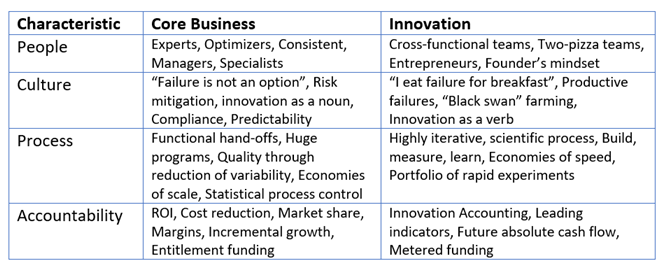
Alex Osterwalder, et al, in their Strategyzer Series including, The Invincible Company, Value Proposition Design, and Testing Business Ideas codified many of the more commonly used tools although they did introduce some erroneous thinking regarding probability and statistics. The books are quite useful, and examples will be pulled from their books into the workshops.
General Stanley McChrystal’s, Team of Teams, uses the battlefield to examine communications models. His insights and success correlate well with innovation team thinking. Battlefields are filled with uncertainty. Speed is a powerful ally, especially speed of communication and speed of decision-making. As the title of the book gives away, his breakthrough was to institute daily stand-ups where he openly shared information across intelligence agencies and the various groups within the armed forces, creating multi-disciplined teams of teams. He followed this daily information sharing with placing the decision-making in the field. He found the field officers were better at making decisions that led to success than the senior officers at central command. In short, he created a multi-disciplined set of decision-makers whose speed and accuracy vastly outperformed the previous approach. Sorties went up by a factor of over 100. Success rates per sortie dramatically rose. Within 18 months of changing how decisions were made, General McChrystal vastly enhanced the performance of his team operating in a world of uncertainty. It is interesting to note, the quality of the data did not go up indicating data was already in over-supply. Insights and speed were far more valuable then collecting more data.
In looking at companies and why they struggle to be successful with innovation, the common problems have their root in finding the proper role for innovation in support of the company’s strategy. This is then followed by realizing innovation is a world filled with uncertainty and that new tools are required to forge a successful future. These tools will be taught throughout the workshops providing you and your teams the tools and experience to be successful.
Course Manuals 1-12
Course Manual 1: Innovation life cycle
Overview of the Innovation Life Cycle
Innovation is a capability an organization can use to drive top-line growth through adding new products and services and/or to take costs out by re-imagining internal business processes. Wielded well, innovation can shape a bold and successful future for a company. In this course, New Product Business will present the tools, techniques, and procedures to maximize the impact innovation can have across an enterprise.
Workshop 1, Current State, is a necessary first step as it is critical to begin with a clear understanding of your company’s innovation capabilities. New Product Business (NPB) takes a full view of innovation across a company and how they deploy their talent and financial reserves, how they use innovation in their brand, and how innovation supports the corporate strategy. Workshop 1 provides the blueprint for understanding and mapping how your company’s current use of innovation is shaping a solid future and areas where innovation improvements are available.
In the process of creating the current state evaluation in Workshop 1, you will be introduced to the innovation life cycle which is a foundational element of the course. See file, New Product Business Innovation Life Cycle. In this way, Workshop 1 provides an overview of the course. Each subsequent workshop will provide detailed case studies or examples of the key aspects of the innovation life cycle to deepen your understanding and ability to run the New Product Business process.
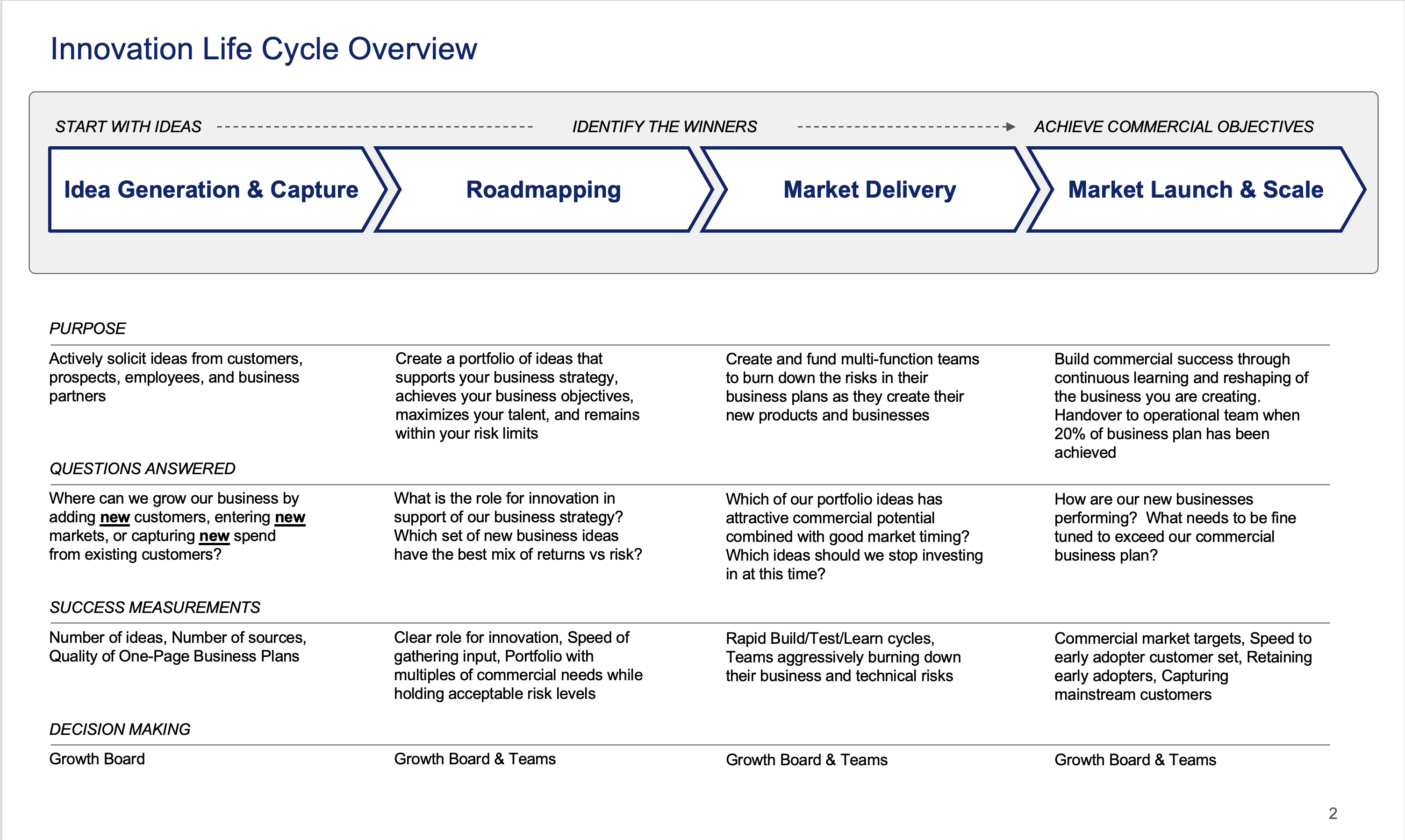
Innovation starts with an idea and ends with financial outcomes. Since it starts in the present and ends in the future (measured in months, quarters, or years), it is filled with uncertainty. The quote, attributable to Mark Twain and Yogi Berra is apt, “Prediction is difficult, especially when it involves the future.” The uncertainty that permeates innovation creates a sharp distinction between it and the operation of a core business. The core business is an efficient machine with a relentless pursuit to reduce variability to create higher quality and better financial returns. In the core business, the upcoming quarter will closely resemble the previous quarters, being a refinement of that performance. Ideally, there are few surprises as the operation ticks along.
Innovation is quite different. In place of steady-stream consistency, innovation is full of uncertainty. Known outcomes in the core business are replaced with unknowns. Functionally expert teams working in silos are replaced by multi-function teams who work closely together to pioneer their way forward, leveraging their varied perspectives and skills. Failure in the core business could be career ending, while in innovation, failure is expected and a great source of learning. Measurements in the core business are well known, such as ROI, market share, and margin. These are meaningless measurements in innovation and are replaced by risk-burndown, leading indicators, and future absolute cash flow.
Group Exercise: Discuss the Innovation Life Cycle phases, reviewing the Purpose for each. How well does your company handle each Phase? Is there a Phase they do well? Is there a Phase that needs more attention? How innovative would you rate your company? (Note: we will revisit these questions throughout this workshop.)

Phase 1: Idea Generation & Capture
The process starts with, Idea Generation & Capture, where ideas are identified that could create new businesses in the future. These ideas come from customers, employees, business partners, or even competitors. The germ of these ideas is the progress a customer wants to make, and this is true for both business-to-business (B2B) or business-to-consumer (B2C). The progress can be functional, as in “I want to buy a battery-powered car, but it has to be able to drive 400 miles on a single charge” or it can be emotional, “My bank is rude to me. There has to be a better alternative.” In each case, identifying the progress the individual wants to make can reveal the secret innovation can unlock. Not all customer pains and gains unlock prizes large enough to pursue, and this explains the value of capturing a long list of ideas.
Given the high degree of uncertainty that must be traversed to build a successful business, it is necessary to realize that not every promising idea will make it to market, and even for those ideas which do reach the market, most will perform at or below expectations with only a small number delivering well above expectations. The mathematics of innovation are governed by the Power Law, often referred to as Pareto’s Principle or the 80/20 rule, where 80 percent of the outcomes are achieved by 20% of the products. For innovation, if you have a portfolio of 10 product ideas, the supermajority (or 80%) of your commercial outcomes will come from 1 or 2 of those products. Since it is impossible to know at inception, which of the 10 will perform better than others, there must be a process to prioritize the ideas.

Phase 2: Roadmapping
Roadmapping is the second innovation life cycle phase and contains the tools and processes to sift through a long list of ideas to create a portfolio. Roadmapping takes the long list of new product business ideas and assesses their future value, balancing this against the anticipated risks of achieving that future commercial value. At the end of Roadmapping, you will have a well-shaped portfolio of ideas that represent your best collection of commercial outcomes versus risk. There are two tools that help manage the task of sifting through dozens of new product business ideas to find the most promising: the one-page business plan; and the Reward-Risk Map.
The one-page business plan is exactly as it sounds. While only page, it is a critically important tool for comparing ideas as it expands the product idea into an elevator pitch for a potential future business. Ideas often come in the form of a product name or “I think we should do X”, where X could be “enter the mid-market”, or “create a platform”, or “acquire a hot technology company and cross-sell their product to our existing customers”. These are ideas need to be set onto a common framework so they can be fairly evaluated, as they each are competing for funding and talent. The ideas also need to be expanded, because “entering the mid-market” could mean many different things. The one-page business plan, which takes 15 to 60 minutes to complete, is what you might prepare before presenting on Shark Tank. It answers critical business questions such as, who are your future customers, why will they find this offer interesting and differentiated, and what assets can we leverage to get unique advantage in this market?
The second tool, the Reward-Risk Map, graphs elements from the one-page business plan separating the ideas into five zones, each with a different outcome to risk profile. The most attractive zone has a high commercial return combined with a low risk profile. This zone contains a group of ideas that warrant a first wave of funding and a talented multi-function team to begin investigating the details of the promising businesses. Diametric on the Reward-Risk Map is the group of new product business ideas that have low potential business outcomes but high-risks. This is an unattractive ratio, and for this reason these ideas are dropped from consideration and will not receive funding or a team to pursue them further. The other three zones on the Risk-Reward Map will be covered in the Roadmapping section of this Workshop.

Phase 3: Market Delivery
Once an idea has been approved for the portfolio, it will receive funding and a team. The portfolio formation, funding, and team allocations are decisions made by the Growth Board. The Growth Board is responsible for the commercial performance of the portfolio they create. Each innovation portfolio (often there is more than one within a corporation) is aligned with the company’s strategic business objectives, such as “grow the top line an incremental 25% by reaching new customers” or “reinvent our business processes to eliminate 40% of our operating costs”.
As mentioned previously, the Growth Board will invest in multiple ideas simultaneously, as they cannot predict the future and therefore, they take advantage of multiple parallel ideas to learn which might have the greatest market potential. This portfolio approach produces good overall results, but it is important to point out it will appear expensive and possibly clumsy when viewed from the perspective of the core business. The degree the portfolio businesses are “going where no one has gone before” is proportional to the level of uncertainty they will encounter. No one had circumnavigated the world by ship before Magellan’s expedition departed in 1519 searching for a passage from the Atlantic to the Pacific. One of his two ships, following his death in a battle on what is now the Philippines, completed the circumnavigation returning to Spain in 1522. The two-ship approach is an example of portfolio in action.
Becoming part of the portfolio is a lease not an entitlement, and this marks another pointed difference between innovation and the core business. While the Roadmapping process will have created the best portfolio, it was based on assumptions contained in the one-page business plans. The next phase of the innovation life cycle is Market Delivery, and this is where the teams actively burn down the risks in the technical and business plans as they continuously build and refine their innovation. Some ideas will run into dead ends and have no way out. Most ideas will hit roadblocks but will be able to pivot their way forward. Those teams who pivot quicker and run to daylight will get to market faster and will have tuned their product or service to be well aligned with the consumers’ pains and gains.
To pivot fast and in the right direction requires a team to learn quickly. This makes sense since they have many unknowns to solve. Will our prospective customers want our service? Will our channel be able to develop sufficient demand and conversion rates? Will our business model scale? At the early stages of Market Delivery, teams will state their unknowns in the form of leap of faith hypotheses, with a set of A/Bn tests they can run that will yield action-oriented answers. The answers either support or reject their leap of faith hypotheses, and with each set of answers, the team learns more about their path forward. High-performance innovation teams learn at exceptionally fast rates.
It is important to notice that during Market Delivery, the teams continuously test both their technical and business risks. Fundamentally, innovation’s role is to create measurable and significant commercial outcomes that support the business strategy. Unlike many other innovation approaches, the New Product Business approach continuously focuses on the commercial outcomes. New products or services that fail to deliver their promised business returns are costly failures because they were allowed to consume the time, talent, and funding that could have been used on another idea. New Product Business innovation recognizes that some products will fail but is designed to ferret these out as early in the process as possible, greatly reducing the wasted time, talent, and funding.

Phase 4: Market Launch & Scale
The last phase of the innovation life cycle is Market Launch & Scale, highlighting the need to focus on achieving the commercial success of each new business which has come this far in the process. Up to this point, each new business will have been consuming talent and funding, in other words, they have been costs to the business. As a new business enters the Market Launch and Scale phase it will for the first time begin to drive commercial outcomes, such as new customers, revenue, or profit. Making this transition to commercial success is not a turn it on, binary moment. First customers will provide a wealth of real-world evidence of what is right and not-quite-right with the product. Similarly, the marketing and sales processes will indicate where doubling-down makes sense but also, where wrinkles need to be flattened. Very much like the learning in Market Delivery, the innovation teams need to continue their fast learn and pivot, and as was the case in Idea Generation, the team should gather information from customers, non-customers, market facing employees, and business partners.
It is important to note that the Market Launch & Scale phase is often omitted from other innovation approaches, leaving this critical step to some other department. Unfortunately, many good businesses die in the gap between the innovation process and market because there was no appropriate advocate for it. Throwing the product “over the transom” to Sales and/or Marketing is a typical failed innovation approach, as it leaves the product without an owner and bereft of a learning mentality which can underpin the pivots necessary after market introduction.
Group Exercise: Discuss how well your company captures the commercial outcomes from new products and services. What connects the team that develops and builds the new products from the customer-facing teams that market, sell, and support it?

Course Manual 2: Interview Executives
Executive Topic Guide for Interviews
The first part of the workshop introduced the New Product Business Innovation Life Cycle, a comprehensive process for shaping ideas into future commercial businesses. This foundational process will be revisited throughout the course. In this section, we will use the innovation life cycle to consider what information we need to gather so that you can form a comprehensive view of the current state on innovation within your company.
Some of the questions you will need to answer are on the innovation life cycle already. For example, in the Idea Generation & Capture phase, there are fundamental questions regarding, “Where can we grow our business by adding new customers, entering new markets, or capturing new spend from existing customers? The emphasis on new is intentional, as innovation is all about new. You will need more innovation the more your strategy stretches your company to need new customers, and/or to introduce new products or services, and/or grow a new channel, … or anything else substantially new.
The Topic Guide for Innovation Life Cycle sets out the specific questions you need to answer to get an understanding of your company’s innovation processes and decision making.
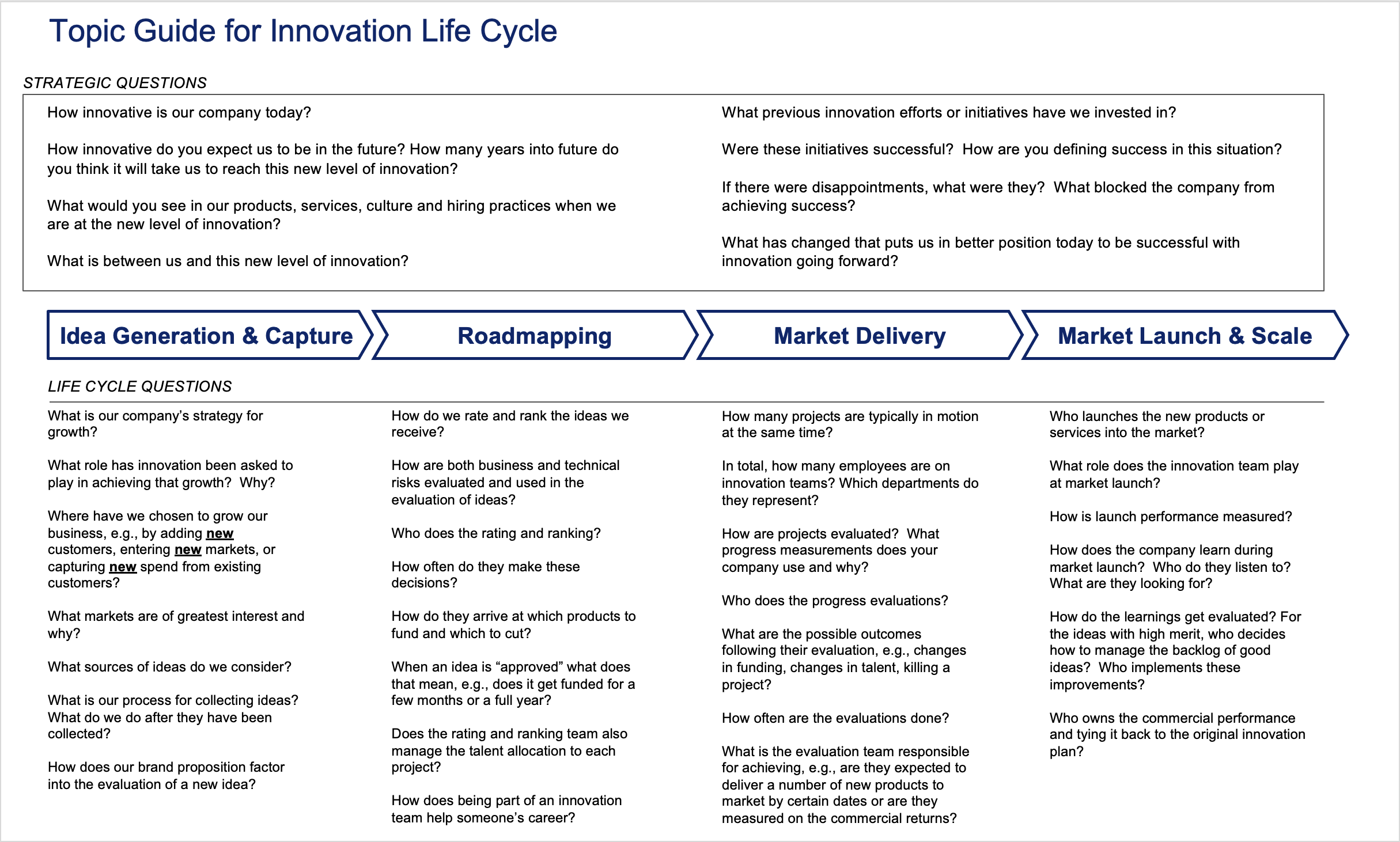
The questions in the Topic Guide cover both strategic and day-to-day operational topics. They are open-ended and will act as an x-ray of your company’s innovation efforts at this moment. There are no right or wrong answers. The Topic Guide is a diagnostic tool that will help you describe how your company manages innovation. Only after you have obtained answer to these questions from a variety of executives will you be able to determine how well the current processes are servicing your strategic business needs and where you might want to recommend changes. The topics of fit and recommended changes are covered in subsequent workshops.
Group Exercise: Review the questions in the Topic Guide. Which questions do you think will uncover the most insight into how your company does innovation? Why? Which questions would you not ask, and why?

Why Interviews Work
With the Topic Guide in hand, you might want to rush to do an interview but before you do, it will be valuable to understand why interviews are the right method for collecting the data you need. In a world inundated with phrases containing data, e.g., “data driven strategy”, “data enabled”, “big data”, “data scientist”, “data aware”, “machine learning trained on massive data sets”, … it might seem that we need do a quantitative survey. Useful as those are, the data we need is qualitative, such as commentary, opinion, and insights. There will be few numbers, although the numbers you will collect will be quite useful, e.g., “we typically run four (4) new business programs simultaneously”. The task at hand is akin to investigative journalism, where the right questions are likely to elicit a range of responses. The purpose of the interviews is to develop an understanding of your company’s current innovation approach. And it is precisely this range of responses that will help you frame your understanding of how your company currently handles innovation.
The Topic Guide has two parts, containing questions that are strategic and those that are related to the four innovation life cycle phases. Start with the strategic questions as it is important to allow the person being interviewed the opportunity to expand on their innovation vision. The questions are designed to create an interview atmosphere, allowing you to ask follow-up questions which will round out your understanding of the answers. This is not an interrogation – the person being interviewed should be relaxed and interested in participating.
Group Exercise: First, spend five minutes to write down where you have used qualitative analysis, and its strengths and weaknesses. With the group, share your personal experiences and assess how it aligns with the proposed use to discover your company’s approach to innovation?
Select Executives from across the Company
This raises the question of who to interview. Unlike departments such as Marketing, Engineering, or Legal where it is clear who you would interview as the owner of that function, Innovation rarely has a single head. That is not to say many companies do not have a Chief Innovation Officer, as many do, but that the remit for taking ideas and shaping them into commercial businesses is usually dispersed beyond the office of innovation. This dovetails nicely with the idea of multi-function teams, introduced earlier as a fundamental unit in innovation. These teams benefit immensely from the varied perspectives necessary to grow an idea into a thriving business.
It is very likely that many people in your company either believe they own or actively participate in innovation. Innovation is a shiny object, and few departments or organizations would want to be characterized as not being attracted to it, as innovation is about shaping the future of your company. With so many potential innovation owners or players, it is not surprising why CEOs do not have a crisp understanding of the innovation efforts across their company, and hence, the enormous value of capturing the innovation current state in this workshop.
The dispersion of innovation poses a few challenges. First, who should you interview? In the extreme case, every department head may claim to be involved in innovation, which would create a long list of interviews and raises the second challenge of whose voice is important. In a hierarchical structure, such as the Marketing or Engineering departments, you would expect the senior-most leaders to set the strategy and operations manuals for their department. If the CEO had a question about Marketing, they would naturally turn to the CMO to get the complete answer. In the case a dispersed topic such as innovation, even if there is a Chief Innovation Officer, there may be several senior leaders who are actively involved in innovation strategy and execution. The third challenge is to determine what part of the innovation life cycle an interviewee is familiar with, as it is unlikely each executive will be versed in all aspects of the innovation life cycle.
To form a solid understanding of the current state of innovation at your company, you will need four or five points of view for each Topic Guide question. This usually means interviewing six or seven executives who are meaningfully involved in innovation, as each person may not be able to contribute a meaningful answer to each question. Selecting the interviewees should be done with the guidance of a senior innovation leader, such as the Chief Innovation Officer or other senior executive who is tightly connected to innovation.
Note: There are rare cases where the Chief Innovation Officer owns the entire innovation life cycle, and they are uniquely responsible for developing and running the innovation playbook. In these situations, you can interview them and their direct reports to get the insider’s view. It would also be useful to interview a few executives who interface with the Innovation team such as Marketing or Sales, to capture their perspectives of what works well and what could be improved.
Group Exercise: Discuss how easy/difficult it will be to identify appropriate executives who are involved across the Innovation Life Cycle. (Note: in a later exercise you will be asked to create a named list to interview.)

Consider Past, Current, and Future
You are tasked with capturing the current state of innovation. To get a full view, it will be important to delve into the strategic questions at the top of the Topic Guide. The questions in the right column look back in time and are focused on the company’s previous innovation efforts. Previous innovation initiative, their difficulties, and their successes provide insights into how your company both thinks and acts. The innovation actions previously taken are real world experiments. How well did your company rise to the occasion? Who was in the lead? What were the measurements? You can use the life cycle questions on the bottom of the Topic Guide to dig deeper into previous innovation initiatives.
Compare and contrast the lessons learned from prior initiatives to the answers given to the questions about the current and future state of innovation. Look for patterns of progress, i.e., “we used to take six years to develop a new product, but since we re-organized our approach to innovation two years ago, we have decreased the development time to 18 months and going forward, we expect to have a rolling six-month delivery.” And ruts in the road, where persistent problems continue to block innovation’s path. “We are in a slow-moving market and didn’t look for top-grade innovation talent. Over the past few years, new entrants have disrupted our market and we responded by hiring a group of hot technology types from Silicon Valley. Unfortunately, they didn’t feel comfortable working for us and left, and our brand makes it hard to hire the innovation talent we need.”
By examining previous innovation efforts, you will develop a sense of what has worked at your company and the set of innovation blockers. The Topic Guide’s strategic questions about the future of innovation will allow you to test the future strength of both the blockers and the winning factors. How present are they in the current state? For example, for the company who struggled to hire innovative talent, is hiring talent continuing to pose a major risk in achieving their stated innovation goals? If it is, what remediation plans do they have in place? When you discover inconsistencies, such as a company who knows hiring innovation talent is a problem but has no plan in place to fix it, dig deeper by asking why.
Group Exercise: Discuss previous innovation initiatives, their successes, and failures, and what you have observed happens when the organization is asked to take on an innovation initiative. Record the group’s key points, as this will be used later in the course.
Preparing Interviewees
The executives you want to interview are busy with their daily routines. Your request for an interview will be additive to their workload and while some may readily accept your request, there are several things you can do to improve your acceptance rate and properly prepare each executive for their interview.
An interview, while it may seem risk-free other than the one-hour demand on someone’s calendar, is usually met with, why do you want to interview me? and what is the purpose of the interview? These are fair questions, and you need to provide honest and direct answers that put them at ease. The answer to the second question is “I am on a team that is preparing a current view of our company’s innovation approach.” The answer to the first question is “You have been identified as a leader who is knowledgeable and involved in our innovation efforts.” These answers and your comment of “we are looking forward to your contribution” should put the executives at ease.
How could an interview be anything other than fact-gathering? The answer is in what happens next, i.e., the conclusions that might be drawn about your company’s current state and the changes that may be recommended. Unfortunately, change is generally seen as a negative, even though it may be well intentioned or needed. Change disrupts the status quo and executives could project a future loss of their power, loss of position, change in job, or even the end of their career. But it could also mean an increase in power, increase in position, or the opening to a bright future. Human nature is biased to consider negative outcomes over positive. Be proactive — state that you are a fact-finding mission and that their input will be combined with several others to get an anonymous, composite understanding of the current state.
Group Exercise: Discuss techniques you have used to improve the outcomes you have achieved in previous qualitative research you have done.

Conduct interviews, a how-to guide
Interviews are much more than asking a list of questions and recording the respondent’s answers. Done well, interviews are a dynamic interplay where the conversation leads to a deeper understanding of the topic. The goal of the interview is to capture the insights and knowledge of the respondent. Success is therefore measured by the degree to which you were able to solicit the respondent’s understanding of how innovation is done today at your company. It is not measured by racing to ask all the questions, as this is not a box-ticking exercise.
A few days prior to their interview (or at least 24 hours ahead), send the Topic Guide to each respondent with a short email reminding them of the interview’s purpose and confirming the amount of time they have allocated. You will need upwards of 60 minutes to conduct the interview, however, depending on executive availability, you can run an effective interview in 30 minutes if pressed for time. Review the Topic Guide ahead of the interview and consider which portions this executive is likely to be most familiar. For those executives who are narrowly focused, develop a few extra questions about their area of knowledge so you can get a deeper understanding. If you run out of questions, ask them to take you through a recent example of the innovation process in which they either lead or took part as this will provide you with another perspective. For example, if they are deeply involved in Roadmapping, you could ask them to take you through the decision-making process they used when creating their most recent portfolio.
During the interview, take notes with a method that allows you to capture the detail of the conversation while also allowing you the ability to reflect on the answers so you can ask pertinent follow-up questions. Typical note taking techniques range from pencil and paper, scribing on notepads, typing, or audio recording. Please note: if you choose to audio record, ask the respondent in advance if they are comfortable with the interview being recorded. Also, take notes in some other form that will help you with ask follow-up questions.
Most of the speaking should be done by the executive but to relieve the pressure of a volley of questions being lobbed at them, you should do some of the talking. You can summarize their previous response to gain their acknowledgement you’ve captured their remarks accurately. Or you can preface a question with a short lead-in, helping to set the context of the question. Use these techniques to make the interview more conversant but remaining on task. Avoid giving your opinions, as this will waste time and could be distractive to the respondent.
Group Exercise: Discuss note taking techniques you have used in previous qualitative research you have done. Which technique(s) works best for you? Which of these techniques would you recommend to others in the workshop, and why?
Create interview write-ups and summaries
Following each interview, write down two or three key themes that stood out while you were doing the interview. The themes can be about the person, their approach, or their insights. For example, “She was focused on what is missing in the current process, having joined our company when our company bought her innovative start-up”, or “He pushes the innovation process to operate faster but recognizes his team can’t keep up”. Write the themes immediately, if possible, as you will be sharply aware of them as you leave the room.
The themes will help you organize and report on each interview. Let’s start with organizing what you will hear across ten executive interviews. Qualitative interviews are often called unstructured, but this is not accurate, as you will use a Topic Guide with each executive. Extracting themes from each interview will give you a basis for comparing each interview and a technique for summarizing what you captured across ten interviews. It’s true their answers will not fit into a Likert scale of 1 to 5, but the themes along with their detailed answers to the Topic Guide questions will give you the necessary connection to pull the interviews together.
The themes will serve a second purpose of helping you convey what you learned in the interviews. While you will have captured many interesting details in your notes, the themes of the interviews will paint the picture of “so what”, either by reinforcing each other across interviews or by their fractured nature. Consider a visual Venn diagram. If all the themes are repeated across the ten interviews, then you can conclude there is a singular understanding of the current state of innovation. Non-recurring themes indicate the executives have differing opinions regarding the current state. Remember, neither of these outcomes is right or wrong. Your job in performing the interviews is to capture and document the current state
Group Exercise: Discuss techniques you have used to summarize your qualitative research. What works well and why?

Course Manual 3: Review Strategy
Locate current and previous strategy documents for company
Every company has a strategy, which is to say, they have a plan of how they will approach the future. The plan is typically revised annually and describes a multi-year view of the company’s outlook, ranging from survival, through incremental growth, to rapid expansion. Strategies should also include the major actions that will be taken to achieve the strategy, and in this way, they set the company’s path and the motions they need to take. If your company’s strategy documents lack a set of actions, then ask for the operational plans were developed as a complement to the annual strategy documents.
Strategy documents should be easy to find as they are often shared with the entire company, even if in condensed format. The challenge may come in locating a complete set of strategy documents, as you will need to acquire a hierarchical set, starting with corporate, then division, then possibly your geography or business unit. You should also ask for copies from last year and the year before, as these will allow you to perceive motion which has occurred over the past two years. Strategies are forward-looking documents; however, they are constructed by people who are aware of the past and it will be valuable for you to be able to review the video tape of the past two years to get into the mindset of those who are setting the current strategy.
Lastly, ask for the full renditions of each document including the appendices, as they contain research, details, and possibly interviews that only appeared in summary form in the strategy documents.
Read documents
This may appear as a straightforward step; however, it contains several different parts. First, envision the intended audience of each document, e.g., employees vs. shareholders vs. industry analysts, and consider their expectations. While the core of a strategy document won’t vary between audiences, the key themes might, for example, investors may be more interested in the project financial outcomes, while employees will likely be more concerned about the future of their division or line of business. For each document, note the key themes, how they were supported, and the level of intensity they need to be addressed. It is common to find fluff inside a corporate strategy document – fluff being topics that are discussed but have no or little material impact on the company’s future. For example, in one company’s strategy, they spent pages presenting decreases in small-and-medium businesses which while accurate, had no bearing on their consumer market focus.
Second, consider the author’s point-of-view and the messages they might want to get across. If there is a new CEO, is she establishing a new path for the company, cleanly breaking from past strategies? If the management team has uneven in their handling volatile markets over the past few years, are they projecting they now have the situation in hand?
Third, take notes as described for the interviews, with details on each page summarized into a set of key themes for each document. Strategy documents should make it easy to capture the key themes of: 1. What is our strategy; 2. Why are we advantaged; and 3. What actions will we take to win? Each of these three points should be captured in a few sentences. If you need more than a few sentences, review and reduce your summaries to their essence. Note: if you can’t tightly summarize these three themes, seek out an interview with one of the key executives asking for 15 minutes of their time to clarify these three points.
Consider internal and external shifts
As you read through the strategy documents, it will be important to determine the forces that are the most dramatic and pose the greatest challenges to your company. These can be either external factors, such as new disruptive competitors entering your market or internal factors, such as the aging of your current product line. These factors vary in their timing and intensity, and it is important to get a sense of both. A simple analogy may help – a forecast of rain is significantly different than a forecast of a hurricane, although in both cases you will get wet.
The most common forces that are highlighted in strategy documents are “trends” which are slow-moving market observations. Long-term trends are easily spotted and measured and for the most part are red herrings, because they lack volatility and over the years have been largely folded into the market’s dynamics. While you shouldn’t ignore these factors, they aren’t sufficiently insightful ingredients for a differentiating strategy. Note: in slow moving markets, such as the insurance or banking industries in the first decade of the 21st century, there weren’t big differences in strategies and operational excellence determined who won. Disruptive competitors like these walled garden markets, because the competitive edge has dulled, allowing a fresh competitor an opening to break-in. Uber in the taxi market, Airbnb in the hotel market, and the Apple Card in credit cards are all examples of disruptive competitors using innovation to win in stable markets.
Fast-moving shifts of reasonable size and duration are of greater interest. What is changing rapidly in your market? Will that change be sustained long enough for your company to capture the market opportunity it contains? Is the size of that market opportunity sufficiently large enough to be of strategic interest? In summary,

From the strategy documents, identify which external or internal factors have two or three of these factors. This short list of factors will provide a critical lens for evaluating the innovation approach at your company.
Group Exercise: Discuss the external forces that are relevant to the markets your company serves. (Note: Choose one market if the group represents different parts of the same company.) Describe these forces in terms of their Speed, Duration, and Size. Postulate which of these external forces might represent a Strategic Shift.
Identify trends and step-changes
Now that you have a list and an understanding of the market and internal shifts that are acting on your company, you now need to identify how your company’s strategy is adapting to the changing landscape. In other words, given the outside world is changing in fundamental and important ways, and possibly internal forces are creating additional shifts, what is your company’s plan. Using the recent COVID-19 pandemic, some company strategies could be written as “batten down the hatches”, holding tight so they could weather the storm. Others saw the massive shifts to on-line as an immediate opportunity to double-down on their investment in on-line and cut their brick-and-mortar footprints.
For the purposes of innovation, it will be important to identify how your company’s strategy is changing. For example, the retailer whose strategy is to exit their physical stores and become an exclusive on-line retailer is about to make a major step-change in their business design. The role for innovation in this example will be throughout the company as they will need to reinvent their entire business design including their talent model. Compare this to an on-line retailer looking at the same market trends. They are likely to feel they are on solid ground and choose to rapidly expand the reach of their distribution network to reach a new market. Innovation’s role here will be light, as the company will be running their existing playbook.
Group Exercise: Discuss any large changes in your company’s strategy and write them down. It is likely your find only one or two changes that are both large and new, but these are critical as they will begin to describe innovation’s role in shaping your company’s future – a topic will discuss later in this workshop.
Examine timing
Innovation is about creating new products and services that will exceed your future customers’ expectations and therefore, the timing of the outcomes contained in your company’s strategy are fundamental. These outcomes will be easy to find, as they are the objectives of the strategy and are generally called out in straight forward terms, such as, “we will grow our revenues by an incremental 10% within 18 months by adding new products” or “we will acquire our first ten Tier 1 Corporate Clients in Germany by year end next year, with each new client averaging 1 million Euros in revenue”.
For each objective, you should be able to write a similar sentence that contains both timing and a business measurement, such as revenue, profit, market share, or customer win backs.
Beyond the timing and market metrics, you will need to identify the how, e.g., what is the plan. In the case of the first example, what new products will be added? Who is responsible for defining them, building them, and bringing them to market? In the second example, how will the company acquire new Tier 1 clients in Germany? What sales channel will be used? What products, services, and offers will be made? Which competitive differentiation or strategic assets will they use to win?
The timing, market measures, and actions that will needed to win will help you with your next task of identifying what is between your company achieving its strategy.

Develop a list of core strengths
Each company has inherent advantages, with some companies having a more pronounced profile. These highly advantaged companies are cited in numerous publications, webinars, and industry functions and it is this drumbeat that can make these companies seem impossible to beat. Yet, Starbucks has competitors that customers favor, possibly for service, unique coffee taste, or local business support. Similarly, Amazon is not the only on-line general merchandise retailer, Apple is not the only technology company, and Tesla is not the only battery-powered car manufacturer. The point, your company can be successful if it knows its unique strengths and deploys those strengths in the execution of its innovation strategy.
Companies such as Starbucks, Amazon, and Tesla, deeply know their strengths and build these directly into their company strategies. Their strengths become strategic assets – the launch pads for reducing the risks in achieving their corporate strategy. Apple has an inherent and powerful design capability which they leverage to create an interconnected value proposition that locks-in each user and their community of friends. An iPhone user upgrades to a newer iPhone because it is a beautiful design, and it keeps them in the group. If they choose some other vendor’s phone, they would no longer be part of their iChat and FaceTime community. Building deeper community features reduces the risk current customers will leave.
Group Exercise: Based on discussion, make a list of your company’s core strengths. When doing so, consider the complete range of possibilities: Customers, sales reach, brand strength, pricing power, joint ventures, patent portfolio, global presence, highly talented and experienced employees, company culture, speed of action, innovation powerhouse, agility, and working capital.
Develop a list of threats
Every strategy will face headwinds in many forms such as competitors, shifts in market needs and wants, or aging brand power. It is critical to understand the challenges your company’s strategy will face in pursuing its strategic ambitions. The strategy documents should contain these threats.
Of course, not all threats are of equal importance. The best way to evaluate the threats is in the context of your strategy, i.e., to what degree will this threat block your company from achieving its strategic goals. There are three factors that will help you rank the threats. Once ranked, they will become part of the Innovation Life Cycle diagram.
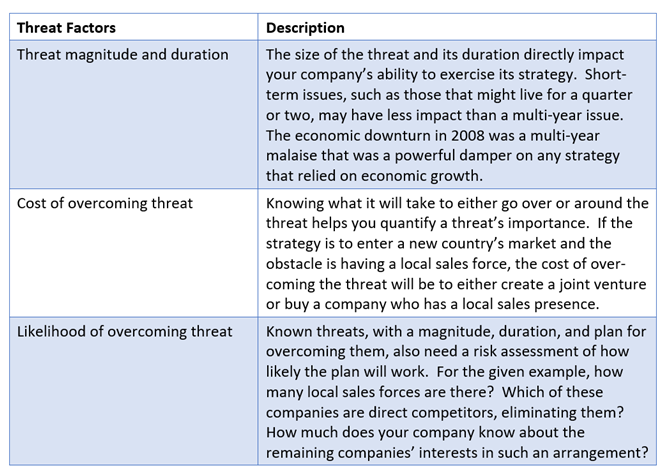
These three factors multiply together to reach a high-level assessment. Since we are talking about the future, it is inappropriate to think of precision, as we don’t have the scientific basis for such a prediction as we are beyond the realm of probability and statistics. (Note: see review of Radical Uncertainty, Kay and King: https://www.topdogadvisory.com/book-reviews )
Using ranges of High, Medium, and Low, we can separate the wheat from the chaff, by applying the following table:
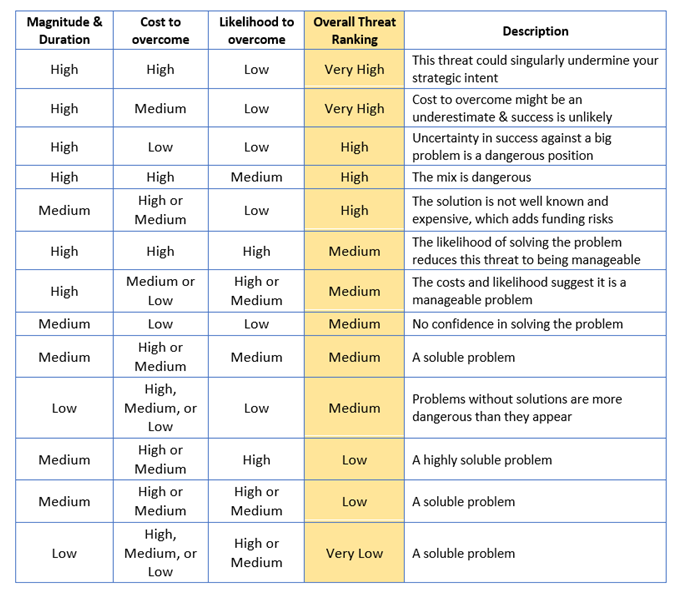
Group Exercise: Rank the threats you identified earlier by using the three factors described above. Then, using the above table, determine each threat’s Overall Threat Ranking.
Develop Leap-of-Faith hypotheses
When dealing with the future, it is critical to recognize that while you cannot predict it, you can approach it with rigor. For example, you can frame the risks, as is shown in the previous table. You can also state what must be true for your strategic future to unfold as you wish. For example, a high school student, when investing in a college education to launch their new business career, must believe their education will land them a well-paying job so they can get a return on their investment. Likewise, a software company whose strategic goal is to increase their market share by 15% in the next 12 months must believe they have a mechanism(s) to make that happen, e.g., increasing the size of their sales force, buying a competitor, or growing their e-commerce sales.
The power of developing Leap-of-Faith hypotheses is that they provide clear items that can be tested BEFORE they occur. In the case of the high school student, she could ask college administrators the percent of students in her preferred major who received job offers upon graduation. She could ask to speak with alumni of her chosen department to see if the jobs were fulfilling, reflected the field of study, and to learn their starting salaries. While there is no guarantee that job market will be the same as it was for the earlier graduates, she could know more about the potential outcomes BEFORE she enrolls in the program.
Similarly, by creating Leap-of-Faith hypotheses around your company’s strategy, you will have a clear set of tests you can run early in the process. These tests will inform the path you will need to take, allowing you to avoid future dead ends and the money, talent, and time wasted on traveling these fruitless paths.
Group Exercise: Create three to five Leap-of-Faith hypotheses regarding your company achieving its future business strategy. For each hypothesis, consider a test you could run tomorrow that would provide insights at very low costs. The high schooler calling an alumnus of her preferred college major is an example of a quick and low-cost test.

Course Manual 4: Innovation’s Role
Explicit vs. Implicit roles
Innovation can play many roles within a company within functional departments, at the strategic level, and within and across business units or divisions. Innovation is also organized in various ways, sometimes placed in a separate function such as an Innovation Hub which can act as a cross-organizational resource. Or it can be embedded within other organizations such as IT or the CTO’s office or made captive within a single division or business unit. While there are strengths, weaknesses, and reasons for these various organizational designs, the critical question to answer now is “what is innovation’s role at my company”?
This is a simple question, but it can be confoundingly difficult to precisely answer because innovation may play several roles within your company, depending on the organization that is funding it. As mentioned, your company may have more than one center of innovation, each located in different organizations. This is common, as innovation can be used by different organizations for different purposes at different times, creating an organic path to innovation’s structure and purpose. Adding to the complexity, some companies acquire smaller, innovative companies for the purposes of jump-starting their innovation capabilities. These new organizations add to previous instances of innovation.
The best way to cut through the clutter is ask team members who are on these various innovation teams to describe the role they see innovation playing. Are they on projects to “drastically take costs out of the business by reinventing the core business” or are they “expected to create new products that will save the company”?
Timing Expectations
Along with the role innovation is expected to play, there should be a clear date associated with the outcomes that innovation is expected to deliver. It’s not sufficient to say innovation’s role is to dramatically reduce the cost of executing our core business if you don’t also have dates against specific, measurable outcomes, such as “we will remove 20% of our claims processing costs in 18 months by reinventing our process. This will be followed by another 15% reduction when we roll the new process out to our three other markets in the subsequent 8 months”
The timing of the outcomes identifies the urgency of innovation’s role. Outcomes that have long-term dates, such as “in five years”, may be correct in their description but would not be urgent. It is important to clarify if innovation’s role is urgent because it has direct and material impact on the funding innovation will receive, the talent pool that will be assigned, and the degree senior management will be willing to shift the company’s culture to pave the way forward for innovation’s success.
Since innovation may have more than one home and therefore, play more than one role as in the above discussion, it will be important to understand innovation’s urgency in each of unique roles it plays within your company.

Innovation’s link to corporate strategy
Innovation contains an innate conundrum – its infinite flexibility and power make it hard to grip. This flexibility has caused innovation’s promise to be elusive – such as failing to deliver new products to help conquer new markets or outpace competitors. Why does Innovation often fail to drive the business as expected? How can you effectively direct it to assist you and the other members of your management team in achieving your desired business outcomes?
The root of the problem is not with Innovation’s broad applicability, as this is an inherently positive attribute similarly found in other tools such as mathematics or technology. The problem is how management teams wield innovation, often doing so with little experience. This shouldn’t be surprising as most executives honed their management skills in the core business, marked by the certainty of repeatable business processes and well-worn decisions. Historically, Innovation was considered someone else’s responsibility; the domain of R&D or something done in an Innovation Hub.
It will be valuable first to set a definition for Innovation and contrast it with your core business experience. As mentioned before, innovation is the creation and leverage of “NEW” to achieve a business objective. It might mean NEW products or services; or NEW channels; or entirely NEW customer experiences. NEW brings with it both uncertainty and the need for learning-your-way-forward. In Innovation, you simply don’t know every answer. You will make lots of mistakes, rapidly correct course, and repeat. Where making mistakes is often equated with failure in the core business, mistakes in Innovation leads to learning and progress. Companies who innovate well encourage learning from mistakes, as they know they are closer to success with each new insight.
Innovation is a sport whose field of play is best circumscribed by corporate strategy. Because Innovation is infinitely flexible, your corporate strategy provides the perfect and necessary anchor. A good corporate strategy leverages your company’s unique assets to create outsized advantage for you in the marketplace, making it inordinately difficult for your competitors to respond to your actions. Since a well-chosen strategy maximizes your chance of winning, aligning Innovation to drive the strategy creates both the direction and source of power for your Innovation outcomes.
Integrating Innovation with your corporate strategy also helps management teams move away from generalities (“We need to be more innovative.”) to defining the explicit ways Innovation can be deployed (“We can accelerate our strategic goal of entering the small-medium market by white-labeling the backend functions we need and complementing them with our unique capabilities in creating a superb customer experience in-line with our brand.”). In this case, the company is following its strategy by leveraging its unique assets in CX and brand value to quickly bring their NEW offer into the NEW market. Innovation’s role is to accelerate the overall process of putting strategy into action and to sharpen its direction and power.
There are four different roles Innovation can play in support of your strategy and likely, only one of these is right for your company. First, it can Fill the Gap between your strategic growth plan and the growth you are expecting from your current product set. Second, it can become your Growth Engine where 20% to 40% of your yearly revenue is generated by products that are only two or three years old. Third, it can act as an Accelerator, shortening the time it takes to achieve commercial success. Lastly, Innovation can boost a company’s performance through a Moonshot, creating a new product that rapidly scales in the marketplace and significantly contributes to shaping your company’s future.
A handy chart compares the various innovation roles.
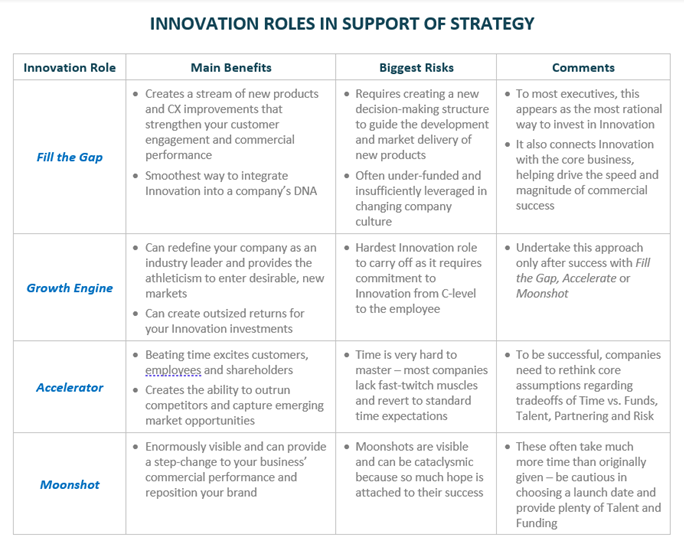
Group Exercise: Discuss amongst the group which of the four innovation roles described in the above table best matches the role your company’s role for innovation.
Innovation’s link to corporate brand
Innovation creates new products and services which may or may not align with your company’s current brand. Let’s begin with a pragmatic definition for brand. Brand is the promise your company makes to its customers, its partners, its shareholders, and its employees. For your customers, it should convey the unique ways your company can help them achieve the progress they desire. This may take the shape of making it easy for them to achieve a goal or to make their lives easier. The measurements of the brand promise can be made in how well you advance your customer. It could be they could not previously save money and your company brand is a promise to help them save money throughout their lives, and by natural extension, throughout the lives of their family members. Products that support the brand could be credit card transactions that “round up”, putting the change into a savings account or a digital savings card that allows children to learn how to save.
But there can also be the case where your current brand may be rooted in a world you no longer believe is representative of your future market. Financial institutions are a good example, as they were in a market that eschewed innovation habitually. When their market was shook-up by disruptive innovators, they responded by creating their own digital apps but chose in many cases to use product names that were either unique or only linked to their parent company. When Goldman Sachs created their consumer business, they named it Marcus by Goldman Sachs, allowing the Marcus name to be new and fresh while keeping the financial stability of the Goldman Sachs brand.
For your company, it will be important to identify your brand’s attributes and promises. You can readily get these from the Marketing department (or whoever is the brand owner), as these are off-the-shelf materials. You will use these brand elements when you do the assessment of the current state of innovation, following this workshop.
Group Exercise: In what ways does your corporate brand (or line-of-business brand) align with the role innovation plays at your company. Discuss amongst the group and record the alignment or dissonance between brand and innovation.
Innovation’s importance to the company’s future
Beyond innovation’s role the urgency of its role, and its potential alignment with innovation as discussed earlier, you will need to get a grip on how important innovation is to the future success of your company.
In banking, there were several decades where innovation was not a critical element of a financial institution’s future success. Bank executives concerned themselves with capital reserves and meeting the regulatory demands place on them such as Sarbanes-Oxley, Anti-Money Laundering (AML) and Know Your Customer (KYC). Today, however, the financial markets have been approached by digitally native companies who are offering consumers an array of attractive, modern banking tools for savings, credit, mortgage, and loans. A review of recent bank strategies shows how dramatically the role of innovation has been made front and center. Bank investments in innovation, joint ventures, publishing cloud service offerings for 3rd party development all represent the radical important innovation now holds within the financial world.
How does innovation fit in your company’s strategy? Is it “nice to have” or “critical”? Has your company placed significant investment behind innovation, such as hiring top talent from outside of your industry or acquiring small, innovative startups who propel your innovation capabilities forward?
Review the strategy documents for evidence of innovation’s importance and assess where on the scale of “Not needed” to “Can’t live without it” you believe best represents innovation importance at your company. Innovation’s importance will have a direct impact on the talent your company can attract and retain. For innovation, top talent is one the greatest contributors to a company achieving its strategic goals, or interpreted more dramatically, talent is the single most important factor in predicting which companies will thrive, survive, or disappear.
Innovation as part of the corporate culture
Another lens on innovation is how the extent it is embedded into your company’s culture. A simple acid test is, when you describe your company to a friend or family member, do you use the word innovative or possibly other words that might carry a similar meaning?
Let’s dig into what it means to have an innovative culture. A company who is innovative believes its future is predicated on finding new business models, new products, new services, new channels, and new customers. They believe in pioneering and in so doing, believe in failing and learning. They reward individuals for asking questions not asked before, spending time on experimenting with new ways to exceed customer needs and wants, and uncovering market secrets that no one else has found. The culture expects individuals to make alliances across the company, both horizontally and vertically. Management expects employees to challenge the status quo, not because that by itself is valuable, but because it is the germ of what could become a future business. Employees are encouraged to work on multi-function teams. They expect some of these teams to fail and a smaller number to fail quickly while an even smaller number to be wildly successful. Innovative cultures celebrate what they learn and they learn at a rapid pace. Speed is more valuable than scale, and innovative companies talk about economies of speed rather than economies of scale.
Culture, as one CEO said, is how our company behaves when no senior manager is in the room.
Group Exercise: Capture your company’s innovation culture using the following tool.

Assign a score to each row that you believe best characterizes your company. Note: if you work in a global entity, it may be more relevant for you to evaluate the business unit you are most familiar with.
Thoughts for evaluating:
1. How many scores were 1,2, or 3? The more of these, the more your company resembles the modern-day office factory, where efficiency and risk avoidance dominate the culture and decision making.
2. How many scores were 8, 9, of 10? The more of these, the more your company is innovative, pushing to discover how to shape the future.
Innovation Ownership
Understanding who owns innovation can be difficult as innovation often resides in a variety of organizations throughout a company. A dispersed innovation structure could be quite useful as it could place innovation at multiple leverage points, representing a mature innovation approach. However, it could just as easily be the incoherent outcome from an unstructured approach to innovation. Your job is to identify the owners of innovation. Later, we will deal with how that innovation ownership structure is either hindering or helping your company’s innovation abilities.
A definition of innovation ownership contains three parts: A person or group of people // who makes decisions // along the Innovation Life Cycle.
Part One: “A person or group of people”. An owner is a person or a group of people, such as a Growth Governance Board.
Part Two: “who makes decisions”. There are many people who are tangentially involved in innovation. The people you need to find are the decision makers.
Part Three: “along the Innovation Life Cycle”. You will likely find different decision makers, some who might focus on only a portion of the Innovation Life Cycle.
Group Exercise: Create a list of innovation owners using the following template. Mark the Innovation Life Cycle Phases they are involved in and describe the decisions they make.


Course Manual 5: Measuring Results
Why not use standard financial metrics?
The financial metrics and measurements in the core business are well known, including revenue, profit, and market share, and are widely used to keep a pulse on the business. These tools are well-honed over the years have proven themselves to be useful in helping make decisions regarding how to tune the business. For example, a retailer who has measured a decline in weekly sales may choose to offer a discount to increase sales. Similarly, the logistics team will see the inventory increase and reduce the amount they are ordering.
In the uncertain world of innovation, these well-established tools simply don’t have power or applicability, and must be replaced with a new set of financial metrics. There are a few clear reasons why this is the case. First, revenue profit and market share are not available during the early stages of the innovation cycle. Products and services are being developed and are not ready for sale. Second, these measurements would not help in the decisions that need to be made in the early stages of the innovation life cycle.
The uncertainty of the innovation cycle also means that the patterns that are well established in the core business are not present. Managing the core business is often done by comparing patterns of business performance, such as this week’s sales compared to last week’s or to the sales for the same week last year. This repeatability of outcomes, in this case sales, allows for deep insights and for recommended actions to be taken based on historical evidence. But in the case of innovation these patterns simply don’t exist and must be replaced with metrics and measurements that can aid decision making in near real time and without the benefit of weekly, quarterly, or annual patterns.
To be clear, the innovation lifecycle must be guided by metrics and measurements – it should not be a free for all where decisions are made based on gut feel alone. As we will see in the next section, innovation is guided strongly by insights derived every day through a learning process.
Group Exercise: Discuss how innovation is measured at your company. What metrics are used? Discuss how these metrics might incent innovation teams? (or not)
Innovation metrics
Innovation metrics create a mathematical model for the future business you are trying to create, with each metric acting as a linked factor to that future outcome. The power of this model is in its ability to be tested continuously as the product evolves on its path to market. Let’s examine this in detail.
Since innovation is about creating a future business, we need leading indicators of performance that will help predict that future outcome rather than the trailing metrics that are useful in the core business. Revenue and profit, for example, are backward-looking measurements. This is fine because the core business is running at near steady state and is mostly predictable on a day-to-day basis. But in the case of innovation where you are crafting the future, trailing metrics are of little to no value in helping you make the decisions you need to make.
Innovation metrics provide a basis of measurement and comparison because they operate at a unit of one customer. For example, how much revenue can we expect to acquire from each customer; or how many referrals will each customer provide us; or how much will it cost for us to serve a customer. By using a unit of one customer you can immediately begin testing and building the future financial business model. As you can imagine, having a unit of one customer provides immense flexibility in how you test your future business. Let’s take the case of the lemonade business. Instead of waiting to source a production volume of organic lemons and to build a factory that can squeeze and distribute the organic lemonade, you could set up a lemonade stand to test the attractiveness of your product with a pitcher of fresh squeezed organic lemonade. Each customer will help you answer the underlying leap of faith assumptions in your business plan, such as: Will they pay a premium for organic fresh squeezed lemonade? Will they refer friends and family? Will they be a repeat customer?
Leap of faith assumptions are intrinsically linked with innovation metrics and for that reason, we will introduce them in the next section.

Leap of faith assumptions
A leap of faith assumption is exactly as it sounds. It describes the many aspects of your future business that you currently must believe for the business to be successful. In the case of the lemonade stand, one of the leap of faith assumptions is that your customers will pay a premium price for fresh squeezed organic lemonade. This leap of faith assumption is obvious but it’s critical to capture these assumptions and to test them as soon as possible to get a grip on the risks in your future business. Simply put, the leap of faith assumptions state the critical risks you must burn down for you to have greater confidence in your future business. Much of the market delivery phase of the innovation lifecycle is dedicated to evaluating your leap of faith assumptions through rapid testing.
You will construct leap of faith assumptions for the various aspects of your business including who is your target audience, what will they find valuable in your offer, how do you compare to competition, and will they be repeat customers. Leap of faith assumptions must be an honest appraisal of the risks in your future business. You will want to be critical of your future business when developing these assumptions, as a robust list of hypotheses will guide your testing regimen and provide a systematic method for burning down the risks in your plan.
These assumptions also link directly to the innovation metrics that you will use to construct your future business case. For example, if your business plan is predicated on customer referrals then you will have an innovation metric for referrals and you will conduct tests on customer referrals. If, however your business plan is not built on referrals, you can omit both the metric and the tests. In the case of the lemonade stand, referrals are important and would be part of your testing scheme, meaning you would have to devise ways to test the willingness of a customer to refer their friends and family.
Group Exercise: For the lemonade stand business, create a three leap of faith hypotheses and the related innovation metric that you could use to help test and learn about the viability of your future business.
Communication and distribution of results
Once you have a set of leap of faith hypotheses and the innovation metrics that will help you gauge your progress, your innovation team will need to devise tests that will either prove or disprove your hypotheses. Each of these tests is a science experiment which you construct to provide input into your decision to either proceed on your current path or pivot to a new one. (Note: we will cover the persevere vs. pivot decision in a future workshop.) Since you will be devising and conducting experiments on a continuous basis, your path to success will be adjusted by each pivot/persevere decision that your innovation makes.
Your team will have the open playing field to make these decisions, however; it is incumbent that your progress be reported to the Growth Governance Board who is funding your efforts. Assume for now, your team meets with the Growth Board every 10 weeks. In that period, your team will possibly have conducted dozens of experiments, each designed to validate one of your leap of faith assumptions that underpin your future business. Given the high degree of uncertainty prevalent in each new business plan, it is likely many of the tests will disprove your assumptions, causing your team to reconsider their best path forward. If you picture roots of a tree, these experiments represent each fork in the roots with the results taking you down the persevere or pivot path. You can imagine the variety of different positions your team might be depending on the outcomes of the dozens of experiments. The key point here is that at the end of the 10 weeks and dozens of experiments, the Growth Board will need to know what you have learned, the persevere/pivot decisions you have made, and from your newly defined position, the strength of your future business outlook.
It might seem obvious, but there is another audience for whom it is critical to get constant updates, and that is the innovation team itself. Teams are typically no larger than 10 to 14 people, especially in Roadmapping and the early months of Market Delivery. The progress the team makes and the persevere/pivot decisions they need to make must be shared across the team. During the daily standups, progress on the most recent experiments must be shared. Typically, the team develops a real-time dashboard that reports results, and this can be used during the standups as well be referenced by team members at any time.
Results alignment with corporate strategy
We mentioned the innovation portfolio earlier, which is the collection of future new businesses that will collectively deliver the desired strategic business outcomes. Each company’s strategy defines how they want the business to change, responding to market dynamics and carving its path for long-term viability. For some companies, this could mean cost savings and/or growth, and for each of these, they will have a set of actions that define how to achieve those objectives. For example, a strategy to grow revenue by 20% may have a list of actions of acquiring small competitors or expanding product development to create new adjacent products current customers will buy.
The importance of the strategy is that it defines the playing field for innovation. For a company whose strategy is 100% about survival and cost-cutting, their innovation portfolio should be a collection of ideas that will radically take costs out of the business. An example might be re-imagining how the core business operates, such as eliminating entire processing departments and through creative web applications, providing a fantastic customer self-serve experience. Conversely, growth-oriented strategies should construct a portfolio of innovation businesses that expand the company’s top-line.
In the case of growth, it is important to distinguish between the different ways to grow, as different growth strategies require different innovation portfolios. Growth can be achieved in several ways. As shown in the table below, innovation plays different roles depending on the growth strategy. Be wary if the term innovation is used near the word growth if there is not an explicit role define for innovation. Example: “We will grow our business by being innovative” provides neither an explicit growth strategy nor a role for Innovation. Innovation needs an explicit role otherwise it will be reduced to banner waving and posturing.
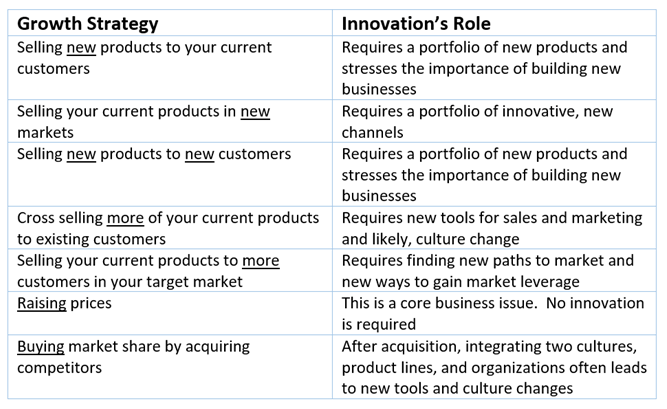
Group Exercise: Discuss your company’s strategy. How well aligned are the planned innovation initiatives with those listed in the table above?
Decisions based on results
We have discussed the leap of faith hypotheses that each innovation team will need to have concerning the success of their future business, how they will need to continuously construct tests to prove or disprove their hypotheses, and the persevere/pivot choice they will need to make based on the outcome of the experiments. What exactly will the team be deciding? How will the tests help them?
The lemonade stand at a community athletic event example provides a clear and direct way of answering these questions. We identified some of the innovation accounting elements that will be fundamental to our future success, represented here with mathematical symbols. This is an overly simple model, but it serves our purpose.

Since each of these are multiplying factors in our business plan, each can have a major impact on how we steer this idea into a future business. The first test might ask customers to taste the product and then pay $7.50 for it. If there was an overwhelming interest to pay $7.50, we might then ask them to buy one for their athlete, as this test would give us feedback on Pcup and Cupsorder. If customers are unwilling to pay $7.50, we could rerun the test at $6 or $5 or $4 until most parents attending a community athletic event would be willing to pay our asking price. The key is to test their willingness to take a significant action, in this case pay for our lemonade. If we couldn’t find a premium price (say, above $2) for our lemonade, then we are faced with a clear need to pivot, as persevering at $2 per cup undermines our business plan of having a premium product.
Of course, in this case, you would not accept the outcome of one test to make such an important decision, which highlights the need to be very quick at your testing cycles and running tests that are inexpensive. If after 3 or 4 tests, there is no observed interest in our lemonade, we will have to consider “why” and what we could do to change our offer. Maybe they would prefer a different flavor other than lemonade. Maybe we need to test various options of sweeteners. Maybe we need to offer crushed ice.
This is a simple example; however, it shows the connections between leap of faith hypotheses, the innovation accounting elements, and the need for making decisions based on your testing results.
Failure as a learning tool
The tests you create must be designed so that there is a chance of your team’s hypotheses being disproved. Most people would characterize a negative outcome as “we were wrong” or “we failed”. These descriptions are both right and wrong. Yes, the test proved your hypothesis was incorrect, and in that way, your team failed, but even that is only partially correct in that the failure was the team’s hypothesis and not the team itself. Great innovation teams, test rapidly, learn, pivot, and repeat this process continuously through Market Delivery, Market Launch & Scale. Many of their hypotheses will be disproved along the way, yet innovation teams view this as learning, not failure.
It is important to note these tests are not graded in the same fashion as tests in school. In school tests, there is a single, correct answer that is already known. The question, how fast is the speed of light has a precise answer of 186,000 miles/second or 300,000 km/sec. In the tests your team will construct, the answer needs to be discovered. It is only after the tests, that your team will have data to make its decision to persevere or pivot. Collecting the data is the critical aspect of the test. Getting the answer that supports your hypothesis is helpful, but data that disproves your hypothesis may cause your team to pivot to an even stronger future business.
Group Exercise: Discuss the degree to which innovation teams are allowed to fail. What implications does failure have on the careers of those who participate on innovation teams?

Course Manual 6: Innovation Portfolio
Idea portfolio: quality and quantity
Innovation portfolios represent the collection of future business ideas that will shape and deliver the future your company’s strategy desires. It is fair to ask how many business ideas should be in our portfolio, and how can we tell a good idea from a great idea and exclude bad ideas. Your innovation portfolio needs to balance the scarcity of investment resources you have (talent, funds, and time) against the uncertainty that inherently inhabits each of the ideas in the portfolio. Should you have two ideas? Ten?
We need to first investigate the differences between the normal distribution and the Power Law. The normal distribution is the familiar bell-shaped curve whose shape contains the outcomes of a situation. The beauty of the normal distribution is that it is well behaved and applies to many business situations, such as production planning and quality control. Unfortunately, it doesn’t apply to the world of innovation, but luckily the Power Law does. The Power Law is commonly known as Pareto’s Principle or the 80/20 Law, where 80% of the outcomes are due to 20% of the causes.
It is helpful to understand why our standard understanding of statistics doesn’t apply to innovation. Probability was a mathematical approach to predicting outcomes, initially devised to solve gambling outcomes. Probability requires three basic premises: First, all outcomes must be known. Example, rolling a die can only result in a 1, 2, 3, 4, 5, or 6. Second, all outcome rate of occurrence must be known. For a die, the chance of any outcome happening is exactly 1/6. Third, the outcomes and their frequency must be constant over time. This is true for dice, as rolling a die today or tomorrow will have no impact on the outcomes or their frequency.
Consider innovation ideas that might be in your portfolio. Do you know all the outcomes? You might argue that there is a binary outcome of success or failure, or possibly a range of unsuccessful, below plan, at plan, and wildly over plan. If you accept the last definition of outcomes, you could move onto the second test: how frequently will each occur for this idea? Now you are stuck, as the outcome for each idea in your innovation portfolio is unknown. The third test also fails, because as your innovation team learns and makes persevere/pivot decisions, they will change their perspective of their future business outcome.
Having described why probability is a failed technique for predicting outcomes, it might be surprising to learn many companies (incorrectly) evaluate their innovation portfolios using probability. Simply put, don’t follow their bad example.
The question of how many ideas to hold in the innovation portfolio can be answered by the measured results of venture capital firms, who have made tens of thousands of investments and have the corresponding known outcomes. The results are sobering:
6 out of 10 investments lose money. Most often these investments are killed at some point in Market Delivery before they get to Market Launch.
4 out of 10 investments show some performance with 25% returning 1 to 5x, 6% returning 10 to 20x, and 1% returning 20 to 50x.
4 out of 1,000 investments return >50X. That means 1 out of every 250 ideas can lead to a great business.
Your business strategy provides a clear target, e.g., grow our revenue 20% in the next 12 months. Your innovation portfolio needs to aim at this target and consider the uncertainty of the outcomes governed by the Power Law. You can use the venture capital outcomes distribution to guide your decision on how many portfolio ideas to have in your portfolio. Also note, you will constantly be adding and subtracting ideas over time as innovation teams test, pivot and re-evaluate the potential outcome of their future business.
Group Exercise: Discuss the failure and success rates of venture backed companies, cited above. Do these numbers reflect the investment thinking at your company? What might account for any significant differences?

Risk content of the portfolio
Risk is an interesting term. If you have spent your entire career in the core business where operational excellence is expected, you would have avoided risk as it introduces the chance for failure. Innovation, however, requires dealing with risk since the future outcomes of each idea in the portfolio is an unknown. The previously cited outcomes based on venture capital investments make it clear that 6 out 10 investments failed. Nowhere in the core business would a 60% failure rate be tolerated. Even a 6% failure rate would cause an investigation and a change in processes.
One conclusion that could be drawn is known as the Spaghetti Test, i.e., “we need to throw a lot of ideas up against the wall to see which ones will stick”. (Note: this was an old test for knowing when pasta was cooked al dente). While descriptive, the Spaghetti Test approach suggests that all ideas are equal which is clearly not the case.
Innovation ideas differ in the amount of risk they contain. Since innovation is about creating new businesses, risk should be viewed from every possible angle, including:
Business risks: what assumptions have your team made in the design of your future business? This could be assumptions about the needs of your target market, the ease of which you will reach them, the power of your value proposition, the costs to run the business and support your customers…
Technical risks: what technological hurdles does your team have to overcome to create a viable product? This could mean having to crack the code of something that hasn’t never been done before or relying on a technology component that has yet to be proven.
Talent risks: what key skills do you need on your team to be successful? While this often refers to technical competencies, remember to consider the business risks and the talented individuals required to overcome those risks.
Competitive risks: what current or new competitors will be significant competitors to your new business? This could mean looking far and wide at non-conventional competitors or considering how a current competitor might make a big move.
Group Exercise: When your company discusses risk, do they consider all four of the above risk categories? Do they possibly have other categories of risk?
Projecting business outcomes
Projecting the business outcomes of your innovation idea will be a fundamental input to the team who are evaluating ideas to be included in the innovation portfolio. Beyond the risks just mentioned, they will be interested in knowing the potential commercial value of each idea. Since portfolios are going to have 10 or more ideas in them, the team who will decide which ideas are included will need a common basis for comparing the project business outcomes.
The previously introduced innovation financial elements form the basis of this estimation. When asked to forecast the future, it is important to remember innovation’s purpose is to create “new”, and with new comes uncertainty. How much revenue will your nascent product idea generate? The answer to this is best provided in the form of ranges rather than a precise number. Note, this is a radically different approach than would be found in the core business which has been operating for dozens of quarters, years, or decades. In the core business, you would be expected to provide a number, much like your company’s CFO provides Wall Street each quarter.
For innovation, we will deal in ranges, ratcheting up the projected number from conservative estimates for each of the innovation financial elements. For the lemonade stand example, the Price per cup, Cups per order, and Customers per event, would be set at their lower limits, maybe $4/cup, 1.2 cups per order, and 35 customers per event. We would continue through the business model, such as market reach (# of events we could cover each week), and with numbers assigned, produce an NPV for this future business. The curve might be closer to flat, but it is our first view of what our business might look like.
Framing the other end of the projection range, would be a business where the innovation financial elements were set to “fantasy” levels, $7/cup, 2.3 cups per order, and 75 customers per event. Since our innovation financial elements are multipliers, the fantasy plan’s NPV curve will likely have a sharp, upwards curve. Neither the conservative base case nor the fantasy plan is necessarily correct, but they do provide insight into the future business performance. It will only be through the team’s actions of establishing and testing their leap of faith assumptions, their pivoting or persevering, and their continuous refinements that the most likely financial outcomes will be known.
Group Exercise: Discuss how your company currently projects the success of future businesses, e.g., do they look for future businesses that can generate 10% of a well-established current business?

Decisions made against the portfolio
Innovation portfolios are dynamically adjusted to deliver the expected business results that align with a company’s strategy. These continuous adjustments are necessitated by the inherent uncertainty in the portfolio and the on-going learnings of each innovation team. With this as a backdrop, let’s consider the various decisions that need to be made to an innovation portfolio.
Initial construction: Portfolios are initially created to meet or exceed a strategic objective of a company. They generally will be a mix of current innovation projects and those that are in their earliest phases. All innovation ideas, independent of the phase they are in, must develop a one-page business plan to explain how they are going to win and the expected financial outcomes. The one-page business plans allow the ideas to be compared and blended into a portfolio.
In/double-down/kill innovation projects: As each team learns their way forward, their projected future business value will change. The three critical dimensions of change are: time, size of financial returns, and risk.
Time: most projects experience delays, although there are projects that accelerate their path to market. The portfolio owner needs to evaluate the timing of financial returns when considering which projects receive talent and funding.
Size of financial returns: When balancing the portfolio, size of financial returns can dominate the conversation, but it should be remembered, that the future business outcomes are “estimates” and likely have inherent uncertainties.
Risk: We discussed risk earlier, noting it can be any unknowns that stand between an innovation idea and its evolution into a successful commercial business. The risks across the portfolio must be acceptable, meaning the company needs to feel comfortable with both the quality and quantity of risks in the portfolio. For example, if many of the innovation ideas relied on being expert at advanced technology, such as artificial intelligence (AI) and Internet of Things (IoT), and the company did not have access to these skilled resources, they may feel the portfolio has too much risk.
As each team presents its learnings, they will update the portfolio owner with details on these three critical elements. Managing at a portfolio level, they will decide which projects continue, which receive additional resources, and which projects to kill.
Top up: As projects are killed, they free up headcount and investment capital that can be placed into in/double-down projects. They also possibly provide the headroom to add fresh innovation ideas to the portfolio. This means the Innovation Idea phase of the innovation life cycle needs to be continuously running, providing fresh ideas to absorb the excess capital or talent.
Group Exercise: As mentioned earlier, 6 out of 10 innovation projects fail to return any money. Good portfolio management kills these projects as early as possible, following the first rule of holes, “when you find yourself in one, stop digging”. Discuss what it would be like to be on a project that was killed.
Portfolio decision makers
The portfolio decision makers are generally a group of senior managers who represent the various functions needed to launch and scale the innovation portfolio. This team is chosen because they can work with the innovation teams to flatten any issues that might delay a new product’s launch or dampen its ability to scale. It therefore makes good sense to staff the innovation portfolio decision makers with functional leads from the core business, including sales, marketing, operations, and customer experience. Whoever sits on this team must have the power to align the organization’s capabilities or culture ahead of the new products launch.
For example, one company had hardware service personnel who did maintenance and repair work on each of their customers’ premises. They were highly trusted and relied upon by their customers. A few of the innovation portfolio products leveraged the client relationships the service team had created, shifting their position to also including providing advice on how to prepare for future technological change. This would be a major shift for the service team, so in advance of launching the first new product, the head of Service did the following:
Provided client access: He asked his team to provide a list of ten customers who would be willing to explore new ideas regarding the relationship they held with their service team member. The feedback from these clients had two key impacts. First it shaped the future of the new product, as they learned what permissions the clients would allow for advice from their service team. Second, it provided material to prompt conversations with the service team, to gauge their willingness to adapt to a new role.
Involved Service in the product design: Since it was part of the business plan to leverage Service team members in providing advice to their customers, the head of Service placed a lead Service team member onto the innovation team very early in Market Delivery phase. She became the voice and conduit to the Service team which expedited the turnaround time. Being part of the team turned a a potential us/them situation into “we” which eliminated finger-pointing that often occurs.
Trained the Service team on how to provide advice: Ahead of Market Launch, the Service team trained the Service team who worked at customers in the targeted entry market. They were also the team responsible for shaping this advice service in response to customer feedback. Remember, the initial ask was for ten customers and at Market Launch, they would interact with 120 customers. This larger sample size provided a richer set of feedback which was used by the Service team to tune the advice service before scaling it to a larger market.

Course Manual 7: Innovation Culture
Evidence innovation is part of the culture
Most companies will characterize themselves as innovative. The term is fashionable and has little downside, but few companies are innovative. A clear place to measure innovation is within a company’s culture. This is true because people are the engine of innovation, and a company’s culture defines which employees they want to attract and retain.
Here is a culture example from a national automotive repair company. Their marketing and brand teams identified that friendly service was a key contributor to repeat business (adding to increased customer lifetime value) and to increases in their referral rate to friends and family. This pleased the senior management team because they had always prided themselves that their company delivered friendly (and effective) service. Advertising and brand efforts amplified friendly service but as months advanced into quarters, the business performance did not improve and surprisingly, when they did customer surveys, the company’s employees scored poorly on “delivering friendly service”. What was wrong?
After investigating, it was found the company made no effort to hire friendly staff, i.e., people who had interest in being friendly. They had no screening questions that would identify if their candidates were outgoing or engaging. They did have several questions regarding skills competencies which were clearly necessary, however, these were not paired with questions that would help hire based on friendliness. Once hired, the annual employee review process had no measurements for friendliness. Neither did management’s annual bonus have any component that measured and compensated on delivering friendly service. And, not surprisingly, there was no training on friendliness that would advance the employees understanding, awareness, or abilities. In short, the culture of the company had no signals or mechanisms that made friendliness a topic of discussion.
This automotive repair company was not on an innovation journey, but their cultural gap serves as a good example of a company whose culture was at odds with their strategy. In this section we will examine the aspects of culture that will lead to a company achieving its innovation goals.
Group Exercise: Discuss how your company’s culture reinforces innovation. What signals do employees receive before they join? During career conversations, how do managers and employees discuss innovation as part of a career journey?
Innovation’s impact on career paths
The most important innovation ingredient is the individual team members who collectively contribute their insights, energy, perseverance, and beliefs to create new businesses. How does a company attract and retain these talented individuals?
First, a company must want to be innovative, meaning its strategy must demand the creation of new products and services that can significantly alter the course of the company’s future. This strategic demand for shaping a company’s future sets the expectation that the company is serious about innovation. Talented innovation-minded individuals will be attracted by this signal, as it indicates that they can build their innovation career at this company.
Of course, there are many companies vying for top innovation talent, so companies must offer more than strategic intent. Innovation talent will look for evidence that after they are hired, their career path will be embellished by their choice of innovation. Here are clear signals they will seek:
Senior leaders whose background was in innovation: An easily observable career success story for innovation is to have senior management populated with people who had substantial commitments to innovation throughout their career. This takes time, but those companies who have promoted innovation stars to senior management have a compelling story to tell. Note: getting your “card punched” by doing a short tour of duty in innovation doesn’t count, e.g., a four- or six-month assignment attached to an innovation team is window dressing if the remainder of that executive’s career was operational excellence roles.
10% innovation time: Depending on the company, this has different implementations, but a good working definition is the recognition that employees can or must contribute to the constant reinvention of their company and are encouraged to spend 10% of their work time on new ideas. They are encouraged to work in teams with the bar to join a team being you can add value to their success. Often these programs are advertised on company websites, along with success stories.
Speed and failure: The culture should be fast paced. Walking the halls would embody the famous line from Tom Cruise’s character in Top Gun, “I feel the need – the need for speed”. Wasting time should be anathema. The teams should all be asking, “how do make a faster decision?” Correspondingly, these same teams will fail often and their culture needs to support the obvious statistics of 6 out 10 innovations lose money, then failure is a natural part of innovation. Innovation cultures eat failure for breakfast.
Group Exercise: To what extent does your company have the three innovation signals mentioned directly above? Which one of these signals do believe carries the most power in getting across the message?

Innovation’s reach beyond technical teams
It has been mentioned earlier that innovation is a team sport and that it requires team members who can create functioning businesses. This means innovation must be present throughout a company’s culture, not just within the technology department. While technology is an important ingredient, successful new product businesses must deliver the desired financial outcomes not just a shiny new product.
This means a company’s culture must support and encourage employees in Marketing, Sales, Operations, Support, Customer Success, Finance, Legal, … to be part of innovation. These are not supporting roles but rather, essential positions for the design, launch and scaling of a successful new product business.
Encouraging participation in innovation from some of these functional groups can be a tricky part of the innovation equation. Consider the head of Operations, who manages an over-flowing list of pressing projects that need real-time attention from his team. As her team strives to deliver on their operational excellence targets, they run flat out. Peeling a few team members off to work on something as “fun” as an innovation project will add to the workloads of each remaining ops team member. Additionally, a team member who shouldered the additional load for a year would like to be acknowledged for their contribution. How should their contribution be measured and compensated versus the ops team member who spent a year on the innovation project? (Note: We will discuss unknotting this problem in a subsequent workshop.)
Evidence of Build / Test / Learn
Successful innovation cultures encourage employees to explore and learn, as learning is the only way to determine if you are on the right path. But, just as few companies would hesitate to call themselves innovative, few companies say they aren’t supportive of learning. So, what do we mean when we say an innovation culture thrives on learning?
A definition for learning will help this discussion. A learning culture recognizes that to achieve your objective, you need to wrestle with the unknown. You are not expected to see around corners. You cannot plot your best path for sailing across the English Channel by sitting on the coastline. You choose your favored course but then you adjust as you learn the winds, currents, debris, and sea traffic at each spot along the way. Learning is your continuous assessment of your progress and the factors which are blocking or accelerating your movement. Learning is the choices you make at each moment on the journey as you interpret these inputs and chose your next step. Learning is knowing you must take action to determine if that path equates to progress, a need to pivot, or a regrettable dead end.
Learning requires provable hypotheses, and for our nomenclature, what we have been calling leap of faith hypotheses or assumptions. When your innovation team has a list of hypotheses, they will then design tests, build them, and put them into play. Innovation cultures are familiar with the build / test / learn cycle; they have taught team members how to design and build MVP tests which are low-cost and quick to construct. They have team ceremonies where they discuss this information, making critical persevere / pivot decisions. They also publish each test’s data on the team dashboard for the entire team’s understanding.
Additionally, Growth Governance Boards, who are responsible for funding the various initiatives within the innovation portfolio, will based their decisions on what has been learned by each innovation team and their forward learning plan. Growth Boards will evaluate the speed and depth of what has been learned. Teams that methodically burn down the risks in their business plans are rewarded with additional funding.
Some companies do pose as learning companies. To help you evaluate, here are a few characteristics of companies who haven’t managed to put learning at the center of their culture.
They expect complete plans: Failing to recognize that the future contains a great deal of uncertainty, a company will expect their innovation teams to have thought of every possible obstacle along the way and to have contingency plans. Plans grow in length but not in value.
Managers who prefer avoiding risks: Those who are funding projects want confidence they are backing only winners. They prefer projects with little to no risks versus those that can change the course of the business.
Companies that have no off-the-shelf build / test / learn capabilities: The build / test / learn cycle is replete with testing techniques that can accelerate the process. Innovation teams are familiar and trained on these techniques; understand the power of pushing the data into a team dashboard; and know how to make decisions based on rapid testing. Companies who lack any of this testing and decision-making componentry are ill equipped for learning.
Group Exercise: Does your company call itself a learning company? Does your company exhibit the three characteristics listed directly above? How do you see these items blocking innovation? What needs to change to become a learning company?

Pivoting as a skill
There is a difference between being flexible in making a decision and being indecisive or waffling. There is also a difference between making gut-feel decisions and having a data foundation for your choices. Pivoting is a decision-making approach that is both flexible and based on data and is necessary in an innovation culture. Because it is different than decision-making in the core business, it is instructive to give it a deeper look.
For the purposes of our illustration, let’s assume you are on an innovation team who are designing a next-generation 3D graphics tool. You are unsure if your future customers will prefer to have drawing wizards which will reduce the skills required to create a 3D image or if they will prefer complete control over every aspect of their drawing. Wizards will also shorten the time to make a drawing. Innovation teams might construct their hypothesis as, “Our target customer will prefer drawing wizards as they value speed over having infinite control. They are also not expert at 3D graphics and will learn the various 3D controls as they are guided by the wizard.”
The next step is to design and build a test. For our example, the team will sketch their wizard ideas on a series of 2×3 feet white boards, hang them on the wall, and literally walk prospective customers through the wizard experience. They will gather overall and detailed responses. They will evaluate facial expressions, asking questions as they observe physical reactions. They will probe on what works and why. Similarly, what doesn’t work and why. In the span of a few days to design, build, and execute the test, they will have sufficient data to prove/disprove their hypothesis. They will then meet to discuss what they have learned. They may choose to rerun the test, incorporating some of suggested changes. Quickly looping through, they will have gathered sufficient data to persevere or pivot.
Compare this with traditional business decisions. Most decision points are familiar, meaning there is historical evidence of the reasons the decision needs to be made and the outcomes of those decisions. For example, if a new product line is not selling to expectations (a familiar if unfortunate situation), there are known remedies: increase the promotional activity within the target audience; increase the promotional activity to a secondary audience; offer a discount…. All these options have been tried at the same decision point in the past with other products, making this decision a matter of picking between known outcomes.
Note: modern Marketing teams are incorporating A/Bn testing into their approaches, creating on-going test and learn cycles. This is a big step forward and allows them to support their pivot decisions with customer test data.
Group Exercise: How experienced is your company at quickly testing ideas? What techniques do they use?
Speed vs. depth
In the previous illustration, it was suggested the innovation team may choose to rerun their test after incorporating some of the customer feedback, which raises the question, “how much testing is sufficient to prove or disprove your leap of faith assumption?”
The answer is more of a balancing act than a specific number. Since the innovation team have many leap of faith assumptions in their business plan and will always have an upcoming Growth Board review in a number of weeks, they will pressure on them to learn quickly. Balancing this need for speed are the questions they ask themselves, and will invariably be asked by the Growth Board, “are the voices and comments we heard representative of our intended market?”, “did the testing mechanism bias their responses?”, and “What makes us confident that we have collected data that conclusively points in the direction of our decision?”
Innovation teams must consider the importance of each decision, the time and resources required to perform more tests, and their future ability to retreat from this decision and pursue the other leg of the decision tree. The common mistake is to be unsure and to order another round of tests, and possibly, yet another. This can become a self-inflicted showstopper, as the team’s progress grinds to a crawl and the Growth Board begins to question the team’s ability to learn their way forward.

Course Manual 8: Talent Allocation
Team participation across functions
Innovation is a small-team sport, where the team represents the complete set of skills to design, build, and launch their new business. This means that in addition to technology team members, an innovation team needs representation from Marketing, Sales, Operations, Customer Experience, and the other departments who will contribute their insights to the new business. The natural question is, which individuals do you pick to put on an innovation team?
There are three base line requirements.
Functional competency: Each person may be the only person on the innovation representing their function. Remember, innovation teams are small (~10 team members) and this means many of the functions will be represented by one person. In some cases, to keep team size to a minimum, one person may represent two functions when they have the requisite knowledge of both departments. Functional competency means they are fully aware of the various capabilities within their department. For example, the Marketing representative would be expected to be conversant in market segmentation, channels, advertising, SEO, driving market awareness, …. This does not mean they need to be expert in each of these topics but rather, they can advise their innovation team when to consider using each of these capabilities.
Functional team member relationships: The previous requirement focused on the candidate’s knowledge of what their function does. This requirement is that the candidate know who within their function can be tapped to provide deeper insights on each of the functional capabilities. Let’s say, for example, your innovation team was interested in interviewing ten existing customers who fit a particular market segment. The Marketing team member on the innovation team would probably be able to easily describe the various market segments and know roughly how many customers were in each segment. (Functional competency). They might have to ask a Marketing team member for the company’s policy and procedure for interviewing existing customers. After learning they need to get the Sales Account team’s approval, they can use the pulled list of customers and lead sales team member’s name to help their innovation team do the interviews quickly and smartly. Extending this example, the innovation team want to use a Jobs to be Done interviewing approach. The Marketing member on the innovation team will then tap their relationships within the Marketing team to find an expert in this interviewing technique, possibly adding them to the innovation team to perform the interviews.
Passion for creating the future: Innovation team members are chartered with developing new businesses that their companies can use to shape a successful future. There is certainly the thrill of being part of an innovation team as it pioneers its way forward and that thrill both comes from, and is amplified by, each of the team members. Innovation is a participation sport with all members of the team actively creating the future. There are no free riders in innovation – they simply are too expensive to have around.
Group Exercise: Given the three requirements listed above, discuss your company’s talent pool and what percent of the population would you staff on an innovation team. Does the availability of suitable talent surprise you, i.e., is there far too many or few innovation-ready talented people within your company?
Timing of team participation
Innovation teams continuously evaluate the future business they are creating as they progress through the four stages of the innovation life cycle. In the idea stage, the future business is characterized by its one-page business plan, which sometimes is written by the person who has the idea. The “team” at that point, might be this single person, but clearly, they are not capable of designing, testing, building, launching, and scaling their future business so they will need teammates. When do these teammates join?
The typical progression is first to add a few team members who can help strengthen the one-page business plans. Then, once an innovation idea is added to the portfolio, a team is formed who can make the necessary progress, e.g., formulate the leap of faith assumptions and exercise the build / test / learn cycle.
The mix of functional talent and the number of team members will depend on the innovation idea and its specific challenges and level of promise. For ideas that have large commercial expectations, companies will staff and fund these to quickly burndown the risks in those plans. Less commercially promising ideas and ideas that have considerable risks might receive less team members and funding.
You may wonder, when does a Marketing or Sales team member join an innovation team? The answer is usually at the beginning of Market Delivery or possibly even in Roadmapping. They join early in the process because their insights into customer needs and wants, routes to market, marketing motions, costs of customer acquisition, … are critical to shaping the future business. Getting them involved early increases the odds the future business will be a success, as their insights get baked-into the plan. The alternative, sequential approach where Marketing and Sales learn of the new product just prior to its market launch, makes it difficult and costly to make any changes.

Size of innovation teams
Innovation team sizes are dynamic throughout their innovation life cycle. As mentioned above, the team may start as a single person and grow to 10 or 20 as they approach Market Launch. There is pressure to minimize the team size because the Growth Board will be funding multiple portfolio projects and there generally is a limited number of talented individuals who can fill these team roles. Having said that, team size will also be a result of the following factors.
Overall talent pool size: This is a limiting factor, particularly so for rare talents. For example, in today’s rush to digital, experts in artificial intelligence, machine learning, and neural networks are in high demand but relatively short supply. This means, an individual might be assigned to two innovation teams.
Number of innovation projects in the portfolio(s): If the pool size represent supply, the portfolio represents demand. The number of innovation projects that are simultaneously being explored will spread the talent.
Outcomes and risk of each idea: Some innovation ideas could be breakthroughs for a company. Other ideas may contain significant commercial promise while others could be attractive but only because they will likely have a modest return accompanied by reasonable amounts of risk. It would be foolish to staff all these projects evenly. Growth Boards might favor a project which can deliver sweeping change, reducing the available talent and funding for other portfolio projects.
Innovation idea complexity: Inherently, some projects involve more engineering disciplines, such as the case in automotive where talents are needed across design, mechanical, electrical, electronic, fluid, hydraulic, structural, software, … These projects require more team members to properly represent the various disciplines.
Dedicated vs. part-time
Being part of an innovation team is unlike being part of teams in the core business. An innovation team member makes progress every day. The team communicates continuously throughout each day. They pass the ball, knowing their teammates will be there to catch it. They acknowledge that each person is fundamental to the success of the team and know if they are going to be off the field of play for more than a few hours, their teammates need to know.
Innovation team participation is not an off the side of your desk activity. It is not fair to your teammates to join the daily standup call and multi-task – you wouldn’t accept that behavior from them. You must be present and actively involved.
Also consider the lean staffing of an innovation team, with the likelihood that each team member being the sole representative of their function, and the team’s loss when that person is not on the field. Example: on the daily standup, the Marketing team member is absent, which means the team will not get an update on the tests that were run over the past three days. The team a) cannot discuss and decide their forward progress on that leap of faith assumption, and b) any other items or actions that were contingent on that decision will also get delayed. For a visual, picture a baseball team not fielding a first baseman or a soccer team without a goalie.
This leads us to consider if being part of an innovation team requires dedicated time, what is an effective working model. Full time is the working model when teams are in Market Delivery, especially as the pressure builds as they approach Market Launch. In these situations, being part of the innovation team is their day job and their career’s success will be directly linked to their contributions to their innovation team. For some individuals, they might be part of a single innovation team at a given time, working part time. Others might be on two or three.
There are good reasons to support the idea of working part-time on an innovation team, typically done at 50% or 25%. For example, a team member from Finance might be needed 25% of the time during the early stages of Market Delivery, possibly to build, test, and train other team members on the financial business models that underpin the business case. Good practices are to dedicate time each day, including participation on all daily standups.
It is helpful to think of innovation teams as playing a team sport. Every member of the team must be present. The team needs to refine its game each day, which means everyone must keep up and contribute. The team’s progress and eventual success is directly linked to how well the team learns to pass the ball, speed-up their rate of play such as reducing the time to run each build / test / learn cycle and make their persevere / pivot decisions.
Group Exercise: Discuss the working model of being part-time on an innovation team but also having to participate each day on the daily stand-up. How does this differ from other part-time working models, such as those where you might contribute by working independently or can work 4 hours one day and then choose to do other work the remainder of the week?

Talent decision makers
The multi-function requirements of an innovation team demand talent from most or all a company’s functional departments. This will require the Human Resources department be integral to the selection process of innovation team members. The natural place to do talent allocation is within the Growth Boards, so it is by this logic, that a Human Resources leader must be part of the Growth Boards.
Human Resources is often known as a back-office function, controlling the many processes necessary for hiring, retaining, and separating talent from a company. While they may be characterized as a cost center, this doesn’t capture their role of curating the key talents that are necessary for a company to thrive. It is this role of talent management that is fundamental to the success of the Growth Board.
The other members of the Growth Board, who represent the various functions across the company, also have a talent management role. They know the team members from their department, their career aspirations, and their strengths and weaknesses. Collaborating with Human Resources, the Growth Board will be well informed to make their staffing decisions.
Criteria for choosing talent
Beyond the functional needs such as “we need a Mechanical Engineer who can do structural design”, the criterion for choosing talent includes emotional and career factors, including:
Team player: A team player is someone who enjoys being part of a team. They elevate the team’s success to their top priority and allocate their daily efforts accordingly. On team calls, they ask other team members how they can help. They challenge each other, not to show off how smart they are, but rather to identify a better path forward. They use the word “we” instead of “I”. They join a team asking the question, “how can I make a difference”.
Uncomfortable with the status quo: Innovation team members are crafting a very different future for their companies, through the creation of new products and businesses. Part of their desire comes from the thrill of creating something new – something no one else has done. Another part of their desire comes from being unsatisfied with the current business. They should have insights into how the current business could be (vastly) improved or what unmet customer needs could fuel the success of a new business.
Career Path: Each member of an innovation team will transition through the team in a matter of weeks to many months, even possibly a year or two for major innovation projects. Their contributions to each innovation team must also be meaningful for their career, which means before placing someone onto an innovation team, they must identify how this experience will improve their career trajectory. Do they want to become a general manager of a division, or do they want to become a world expert in applied data science? Aligning their innovation team roles with these future positions is important to both the employee and the team they join.
Frequency of talent decisions
The core business operates close to a steady state, where disruptions to the business are not expected and staffing remains generally constant over the course of a year. Most companies do annual plans, including strategic planning and it is changes in the annual strategic plans that flow down manifesting themselves in additions or subtractions to various affected functional teams. This annual cadence has become the norm, and this pace has become ingrained in the thinking of employees and managers. “Once I’m on a team, I’ll probably stay here unless I ask to be moved.”
That slow pace of change creates can create loyalty or a sense of entitlement, but in either case, there is built-in expectation employees are secure if they perform to the standards of their position. This creates a striking difference with how innovation staffing is done. Innovation staffing is dynamic because each team faces new challenges each day. As each team learns and pivots, their future businesses come sharper into focus. Some teams will need more resources while other teams might need different resources, given the pivots they have needed to make. The unfortunate teams, those that have lost their ability to pivot, will disband and their talent will become available for other innovation projects in the portfolio.
Typically, Growth Boards meet every 10 or 12 weeks, and are making talent and funding decisions each time they meet. Yes, they could “stay the course” with each of the previous decisions they made regarding talent and funding, but this is highly unlikely as some projects will break away from the peloton while others may suffer a breakdown. It is fair to estimate that half of the teams will have some talent adjustment at each Growth Board meeting, either adding, subtracting, or swapping resources. The changes are often one or two people being added or moved to each team as their upcoming needs demand. For example, one team may have finished a data intensive set of tests and will focus on customer experience hypotheses over the next 12 weeks. They can free up their data specialist who can then move to another team who is now entering a data intensive product design phase.
Group Exercise: Where has your company used high-powered teams to crack a problem. How was the talent chosen for those teams?

Course Manual 9: Funding Allocation
Funding decision criteria
The Growth Board typically has access to both a fixed and variable pool of capital to invest in the innovation portfolio. Their challenge is to maximize the future commercial performance of their portfolio amidst all the uncertainties and risks that are in it.
Growth Board members are not prescient – they are not inherently better at predicting the future than anyone else. They need a set of tools to guide their funding decisions. The first part of that toolset is decision criteria.
These four criteria from The Invincible Company, by Alex Osterwalder, are clear, useful, and measurable.
Desirability Risk: Customers aren’t interested. Customer acceptance (and possibly love, recommendations, and loyalty) is critical to the future success of your new business. Will you have enough customers? Will they prefer your product to competitive offers or staying the course? Can you reach these customers? Will our brand help us? Great ideas aren’t great if they don’t have enough customers.
Feasibility Risk: We can’t build and deliver. An imagined idea that can’t be built will not become a future business. Teleporting people across the United States could be a wonderful alternative to airline travel, but with today’s technology, it is simply not viable. Feasibility risk also addresses other parts of the overall business. Do you have the sales reach needed? Can you strike the partnerships or joint ventures with key suppliers? Can you secure the capital to build the infrastructure you need to support your future business?
Viability Risk: We can’t earn enough money. Will you be able to generate the top line revenue and growth numbers that are in your new business plan? Will customers pay the needed sums? Can you cost effectively drive awareness, interest, and sales? Will you retain customers, get expected long-term per customer revenues, and referrals to maintain a healthy business?
Adaptability Risk: External factors are unfavorable. This is the competitive risk combined with other external factors such as economic, societal, cultural, regulatory, or market trends. These are typically big exogenous factors, or a major move made by a competitor or new entrant into your targeted market, whose actions will negate or blunt your business plan.
The next section will explore how these criteria are used at various points in the innovation life cycle to make funding decisions.
Group Exercise: How does your company think about risk? How would you characterize their risk appetite? How do they categorize risk, i.e., does it follow different criteria than the four described above? Does one or more of your company’s criteria add insight beyond the four described above?

Funding decisions
The four risks shown above cover familiar territory, as these are the same risks each innovation team deals with as they navigate their idea towards its intended market. They build leap of faith hypotheses around desirability risks, such as the lemonade stand test of will a customer pay $7 for a cup of fresh squeezed organic lemonade. They continuously redesign their technology approach to push the feasible limits but not break them. From day one, they are evaluating their business viability, identifying items in their overall go-to-market approach that need to be tuned. And they are scanning the market and adapting as they observe competitive moves or market shifts.
The reality is that while all four risks are always in play, an innovation’s team ability to accommodate a risk varies across the innovation life cycle. At the idea stage, the entire investment is a bit of time and a piece of paper on which the one-page business plan is written. All aspects of the new business are flexible, and changes can be made at a low cost. In many ways, the innovation idea at this stage is entirely cerebral with changes to the idea and its associated business plan done “in your head”. At Market Launch and Scale, the degree of flexibility is greatly reduced, as the team has built the product, designed their Marketing and Sales motions, trained Customer Experience team members, and so forth. Changes at this point are both costly and limited in their scope because the product is now real, and changes are magnified and dispersed. Consider the example of a team that created a new high-tech washing machine, where thousands of units have been manufactured, tested, and shipped into global distribution centers. At this stage, making a change to the product’s design would be difficult to effect, costly, and waste considerable time.
Funding decisions, therefore, reflect the varying levels to pivot across the innovation life cycle. In the early stages, funding is provided to mostly burn down desirability and viability risks. These are risks that refer to the future customers’ willingness to pay and the costs to reach and serve them. As an idea progresses, feasibility risks rise in importance squeezing out desirability risks, as the challenge at hand is to design and fabricate the product or service. This can mean a diverse set of action from bending metal to writing code but in all cases, teams must be able to answer the question, can we build this?
Funding also changes shape across the innovation life cycle. In the beginning, the Growth Board will likely fund 10 or 20 ideas, each with a small amount of talent and cash so they can learn more about their future customers and burn down their desirability risks. Some projects will fail at this stage but for those who have promise, their funding will increase. As the successful project list decreases, the winning projects will receive 5 to 10x the previous levels of funding, aiding, and accelerating their path to market.
Funding ownership, pre- and post-decision
Funding decisions are made by the Growth Board, typically done every 10 to 12 weeks. The Growth Board has the authority to allocate talent and finances, and these decisions are made within a few days of the Growth Board meeting in which they have been updated by each of the innovation teams. With a fresh perspective of the progress each team has made and expects to make in the next period, the Growth Board assesses the portfolio’s best chances to achieve the financial outcomes assigned to innovation by their company’s strategy. Winning innovation teams, those whose future businesses have strong promise, will receive more talent and funds. Teams with less promising futures, may have their funding reduced, and the least promising ideas will be removed from the portfolio, freeing up their talent and finances for the more promising teams.
Following the Growth Board’s decision, the innovation teams immediately have access to the new funds and talent unless stipulated to have some delay, such as “Tom, a data scientist, will join your team in two weeks, after he finishes his current assignment”. Since each team presented to the Growth Board its future 10- or 12-week testing plan, the talent and financial assignments have clear use. Each innovation team has ownership of the finances and talent to achieve their plan. They do not need to ask for permission to use these funds. For example, if they need to spend $10,000 on creating a mockup of their future product to test with consumers, they are expected to use their team’s resources (talent and funding) to get it done. This might mean executing themselves or hiring a 3rd party. In either case, their job is to get it done and not to ask for permission.
This might sound perfectly logical, but it is different than decision making in the core business where there is a hierarchy of spending authorization typically based on a manager’s level and an accompanying financial process replete with checks and balances. Speed of action is demanded of every innovation team and putting the standard sign-off processes in their path will severely slow them down. This is not to say that innovation teams can spend money without an audit trail, as this would be irresponsible. To keep the innovation teams within the financial field of play, they rely on their Finance team member to ensure the proper use of funds and that the proper level of reporting is done.
Group Exercise: How does your company handle decision-making? Is it consensus based? When do senior leaders need to get involved in the decision-making process? When is decision-making authority delegated?

Course Manual 10: Risk Appetite
Risk size
Risk is an interesting term as it is associated with positive and negative outcomes. There is the common phrase, risk/reward ratio, which is often used to connect a future benefit such as the promotion you might receive for successfully completing a special project. For example, you manager asks you to lead a SKU rationalization project to reduce the number of current products by 20% to 30%. The project is rarely done and there is known resistance within the product organization, making the outcome of this project uncertain. You choose to lead the project because you believe you will be successful, and you want the promotion.
There is, however, a strong bias in both society and business linking risk with negative outcomes, such as the risk of smoking (death) or various traffic signs such as, Bridge Ices Before Road (car crash). No doubt the world presents many dangers, and it is prudent to consider our reactions to these risks.
The first thing to recognize is the severity of the risk. For innovation risks, we are looking for the degree a risk may block us from realizing our future business success. Because it is a view on both a) our unknown future business; and b) the risk’s impact on our future success, we must be realistic in assigning a precision to a risk’s severity. In the case of the Bridge Ices Before Road, drivers do not expect the sign to say 12.6% chance of Bridge Ices Before Road. Analogously, innovation risks should be measured in easy-to-understand and manage buckets, such as Big risks, Medium risks, and Small risks. Anything more precise is misleading, suggesting there are far more observed data points than are truly available.
To complete the picture of risk size, it is helpful to add two end points. The first is bucket for Very Small risks and the second, positioned at the other end of the scale, Very Big Risks. The table below provides a description of these buckets. Each organization can choose to adjust the definitions but once agreed, they should use consistently use these definitions when describing risk size.
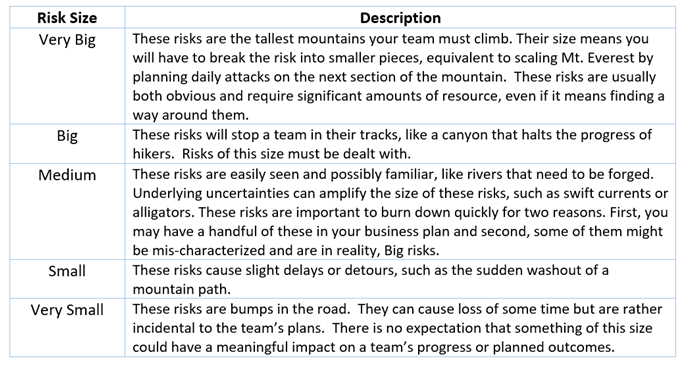
In aggregate, a team can handle 1 Very Big risk in their plan, along with 1 or 2 Big, or 1 to 4 Medium. Risks in these three categories demand attention and resources. Growth Boards will demand early progress to be made against these risks, as risks increase in size the further into the innovation life cycle the team progresses. This is because the team’s flexibility to handle the outcomes of risk testing diminishes and the costs to address adverse outcomes increases.
Group Exercise: How does your company measure the size of risks? Are the suggestions in the table different than what your company currently uses?
Qualifying risks
Risk size helps a team sort through the many risks in their future business as it provides prioritization scheme. Very Big risks taken precedence, then Big followed by Medium. Only once these risks are addressed or further explored should a team consider other risks.
Once the risks are graded, the team’s next step is to create leap of faith hypotheses that align with the top ranked risks. The hypotheses then lead to tests that will either prove or disprove the underlying assumption, providing evidence to guide the team’s direction.
Evidence-based decisions is the technique for avoiding gut feel or opinion-based decisions, which is a common criticism of innovation processes. These criticisms, such as “the innovation team burns through a lot of money and does so by making decisions based on whims” are made by employees or managers who are not involved in the rigor of defining leap of faith hypotheses and the testing mechanisms associated with them. Quite the contrary to ill-informed claims that innovation teams use a dart board for decision making, innovation is entirely focused on rigorously burning down the risks in the business plan (desirability, viability, feasibility, and adaptability).
So how much testing does a team need to do before they can decide on their direction of travel? Innovation demands quick decisions which puts pressure on making decisions with as little data as possible but enough that you can proceed without second guessing. Here, in the next table, are some guidelines.
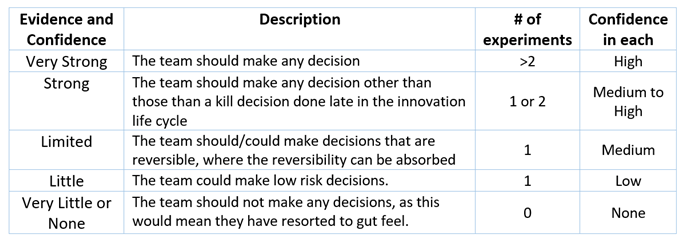
Group Exercise: Discuss the line items in the table above. Does the group agree with the # of experiments needed to make a decision?
Data collection techniques
The above sections described how to size the risks in your new product business plan and the level of evidence recommended for making persevere / pivot decisions. These techniques provide innovation teams a foundation for making quick decisions. Part of making these decisions is the team asking itself, “what information do we need to convince us that we are on the right track?”
In the core business, decisions are made based on statistical data. If you a current enterprise software product was to be offered in a new country, it would be customary to conduct several focus groups with 8 to 10 prospects, then use this to formulate a quantitative questionnaire which might be fielded to hundreds of prospects allowing the data to be cut into segments with 30 or more responses in each. The market evidence would be statistically valid and have a high confidence factor. This could be a good approach if you are exploring an idea such as pricing, and you also believe the new target market has many similarities to the markets you currently serve.
Innovation teams don’t have current market experience, which means they lack deep knowledge of how their future customers will behave. Their new product busines plans will have tens of variables in play (What price will they pay? What are their expectations for customer experience? Who will be our buyer? Who is in the decision-making unit and whose voice is most important? What value proposition will win the day…), and they need to get a sharper view on each of these questions. Since they have multiple, simultaneous questions that must be answered, they need testing techniques that are fast, low-cost, and easy to implement.
There are several techniques that work well in this setting, both qualitative and quantitative. We will explore the various techniques in detail in another workshop, but for now, explore one representative technique known by various names, including the Wizard of Oz test. As in the case of L. Frank Baum’s character, the magic of the wizard in these tests are performed by a human. This test is often used in software where the future benefit may be delivered by a cloud-based service, but for testing purposes, the service is supplied by a human. The test can be quickly created with a few front-end screens and deployed on-line. A testing community can interact with the new “service” and provide feedback within hours, providing the innovation team with both qualitative and quantitative feedback. Follow-up conversations with agreeable testers can provide a richness and depth.
Running towards risk
The movie image of innovation teams is that of young people wearing t-shirts with the slogan, “I eat failure for breakfast” or “I run into burning buildings”. While hyperbolic, they do deliver a clear message that innovation teams are familiar and comfortable handling risk. Why is this true and why does it matter?
Uncertainty is naturally found in innovation forcing innovation teams to continuously deal with it. As described earlier, this uncertainty can be in the economics of the future business, the technological ability of the team to deliver it, or the market dynamics permitting your team the space to operate and be successful. A well-performing innovation team keenly assesses the complete set of risks in their plan and builds tests to burndown these risks. They are aggressive in doing so, knowing that each risk that is investigated, will illuminate their path forward.
Consider the power they create by swiftly running towards risk. By testing early, the team provides themselves great flexibility to adjust to what they will learn, as the product, its value proposition, its sales channel, … are not in cement. Early testing gives them the opportunity to adjust the various aspects of their future business. Early and frequent testing also saves enormous amounts of time, as pivots to the new product business made earlier in product’s lifecycle can be done quicker than if those same changes needed to be made later. By running towards risk, innovation teams save time, money, and talent by finding their path to market through early-stage testing.
Embracing risk is another reason innovation teams need fast, low-cost testing techniques. For each of the many variables they need to verify, they need evidence they are on the right path. They are neither interested in studying each variable in-depth nor are they able to spend the time to design, build, and execute tests and then analyze and report on the data. They are asking, “what can we learn today?”, with today being symbolic of the speed they cherish and need.

Risk profile of innovation decision makers
Innovation decisions are made in different places within most organizations and fall on the shoulders of different individuals. The most obvious two groups are the innovation teams and the Growth Boards, who have specific innovation jobs to be done. Beyond these two teams, there is the company’s senior management and their Board of Directors, all of whom must understand and support innovation’s role in achieving the company’s strategy. Let’s look at each and how risk can affect their thinking and decision-making.
Innovation teams should embrace risk, meaning each person on the team should feel comfortable with failure, learning, and doing both at high-speed. The innovation team leader, who is the leader amongst equals, must encourage the team to aggressively seek out their risks, as burning down risk quickly is fundamental to their eventual success. When considering innovation team members, and especially team leaders, companies must find team members who run into burning buildings.
Growth Board, which are staffed with senior management from various functional departments, need to be sensitive to risk and the speed innovation teams burn it out of their business plans. However, they personally do not need to be someone who would run into a burning building. Their role is to manage the portfolio of innovation ideas and to flatten Market Launch and Scale issues surfaced by the promising innovation teams. The risk profile of a Growth Board member is someone who has a fine-grained understanding that not all risks are created equal; pushes the innovation teams to explain how they are reducing their key risks; and willing to fund promising programs to help them burndown the remaining risks in their plans.
Innovation is typically funded because it will be accountable for some measurable and significant part of the future financials of the company, e.g., 20% of our revenue in two years will come from new product businesses we will create. While senior executives are responsible for delivering the expected outcomes of the core business, they also need to be aware of innovation’s role in shaping the future of their company. They need to embrace innovation and not treat it as a “science experiment” which is an unsupportive and deriding phrase expressed by non-believing, senior managers. These senior managers often believe innovation is too risky and that the company should use those funds and talent to expand the current business. The time for that conversation was during the strategy offsite, when the company fashioned its strategy and designed a role for innovation.
Group Exercise: Does your company have a funding body like the Growth Board? Who is a member on that team? Are the decisions your company’s team make similar to those suggested above for the Growth Board?

Course Manual 11: Decision Making
Description of a good innovation decision
Innovation decision making focuses on adjusting course in near real time, as each innovation team learns its best path to its market success. Good decision-making has the following characteristics.
Speed: Time is the single largest issue to master in making good innovation decisions, as there are several factors which favor slower decisions. First, there is the natural desire to avoid making a mistake which inclines teams to do additional analyzing and testing. Second, each test requires effort to design, build, and execute it, yet in many cases, the test will be used only once or at one point in time. If a team is well versed in a variety of fast testing techniques, it will spend extra time in constructing and executing tests. Tests are important but they are a means to an end. Good teams find ways to cut every possible corner without sacrificing quality.
Contextually meaningful: Teams will often find themselves in situations where they are uncertain of which direction to take. Before designing tests, good innovation teams construct leap of faith hypotheses they need to test and check to make sure that these hypotheses are aligned to their future business plan. Some items, possibly the color of an app’s home screen, could be immaterial to a future customer’s choice to buy, use, or recommend the product. The team in this case would not need to test the home screen’s color palette. However, if the same app was a spin-off of a major corporation, and one of the key items in the business plan is “we expect our corporate brand to strongly influence our ability to capture new customers”, then both the color scheme and possibly the brand hierarchy will need to be tested. For example, the Apple Card’s design, logo, color scheme and user experience retell the Apple brand story, making it attractive to Apple customers who were the designated target market. Testing the look and feel of these materials would have been important to make sure Apple customers felt comfortable with this brand extension.
Sufficiently but not overly confident: The need for speed is the counterweight to repeating tests which provide additional data and confidence. Innovation teams learn to ask the right questions, only running tests that are fundamental to their future business. Returning to our lemonade stand, the team could ask a myriad of questions, but will focus on those that give them confidence around their business assumptions, such as the price per cup someone is willing to pay. The test will force the prospective customer to decide and take an action, in this case exchange $7 for a cup of organic lemonade, as this is a high-fidelity simulation of the future purchase decision customers will make. Many other questions can be asked, such as the type of cup or straw (bamboo vs plastic), which can add to the team’s understanding of their future customers’ preferences. After one afternoon, the team can meet with hundreds of prospective customers and learn possibly enough to decide how to shape their offer. They can talk with people who looked at the stand and chose to not stop. They can ask the customers what they were expecting and how their first sip met/exceeded their expectations. The collection of feedback should be sufficient for the team to discuss its decision. See Group Alignment, next.
Group alignment: Usually only a portion of an innovation team will design and conduct a test, but they will report the results back to the entire team. Communication across an innovation team is fundamental to their success, as innovation is a team sport with the whole team needing to be aware and bought-in to each decision. Group alignment is not groupthink, however, where everyone is indoctrinated to think the same. Quite the contrary, an innovation team thrives on the varying opinions of its team members. Each team member has the responsibility to add their insights into the discussion, to improve the team’s understanding of the situation and the decision that needs to be made. It is clear to all members on an innovation team that each decision will be aligned with certain team members, whose expertise positions them to be the decision maker(s). This decision specialization is both understood and mutually agreeable across the team. Decisions taken are respected as team decisions, even if not everyone on the team was involved at the same level.
Reversibility: Most innovation decisions are reversible, allowing a team to explore Path A and retreat to take Path B. There is a cost to being wrong and having to retreat but often that cost in time, talent, and money is less than dwelling at the juncture, pondering both paths. Teams use different techniques but a common one is to set a decision deadline whe the team can’t decide which path to take, such as “we will proceed down Path A if Tim doesn’t learn any new information regarding upside of taking Path B within 48 hours.” The formula is simple: an owner (Tim), with a task (determine the upside of Path B), within a limited period (48 hours). Clearly, some decisions are more easily retraced than others, and appropriately, teams allocate more thought and resources to gather more confidence where the cost of reversibility is high. Example: Ford re-platformed its popular F-150 pickup with aluminum replacing the industry standard of steel. This was a crucial design choice and one that would have very high reversibility costs. This type of decision requires thorough testing, both market testing with future prospective customers (and existing customers) and engineering design and manufacturing testing.
Group Exercise: Discuss the points described above regarding good innovation decision-making, especially Speed as the primary criterion. How does your company value speed of decision-making in innovation projects? Do they consider Reversibility as a criterion or a weakness?

Ambiguity acceptance
In the core business, senior managers expect their teams to thoroughly evaluate a decision and present well-thought out, data supported options. If in a review, a senior manager believes there is uncertainty in the supporting information, they usually ask their team to take another look. They expect a deeper dive will yield a solid story for making a better decision, trading off time for greater certainty.
In innovation, ambiguity is a natural part of the decision. For the lemonade stand, in one test the team might ask 40 people to purchase a $7 glass of lemonade, which would provide evidence of customer take-up. This evidence might be sufficient for them to design their next test, or they may decide to run the same test a second time. In either case, a) they are not expecting to run the test again and again, and b) they will be presenting to their team but not senior management, as the decision is theirs to make. This means the team will have to decide the level of ambiguity they are comfortable with when they make each decision.
This team-level choice to accept ambiguity works well for innovation teams as it provides the flexibility to place their resources on their largest risks and accept higher levels of ambiguity on smaller risks. Ultimately, they will need to present their decisions to the Growth Board, which is a natural check and balance preventing innovation teams from having too much ambiguity in their decisions.
Future vs. Past
When making decisions, the typical thought model is to consider what has happened in the past. For example, a retailer will consider the additional volume of candy to buy for Halloween based on historical store sales for this holiday, then layer in any unique exogenous factors such as a new housing development opening in the last year inside of the store’s catchment area. When historical data is available and the decision framework is the same (e.g., how much candy to buy for Halloween?), it is both logical and valuable to leverage the insights available from previous instances of having made this decision.
In innovation, however, the past doesn’t exist as each innovation team is faced with new decisions with new variables. Since the situation is new, historical insights are unavailable forcing the team to look to the future. In some ways it frees the team to consider options, as they are untethered to the past, but in other ways, it makes it more difficult for the team as they must work harder to make these new decisions.
This lack of relevant historical data is one of the reasons the team must contend with ambiguity. How much will someone pay for organic, fresh-squeezed lemonade? How often will they be willing to pay this amount? To how many friends and family will they recommend the product? These represent the unknown variables in the business plan that are answered by simulating the future. These test simulations are the most accurate way to understand and measure future customer behavior, and it is this future behavior that needs to guide the “now” decisions innovation teams need to make every day.
Authority Levels
Innovation forces decision-making to the point of each decision, with a clear owner who is accountable. This is the reason almost all day-to-day decisions occur within innovation teams and not with senior management. This decision framework is mandatory as decision speed is fundamental to future market success and the people with the most insights are the people working the issue. This is unlike the core business where experience in making repetitive decisions increases someone’s value and is the reason seasoned executives are trusted to make “big decisions” in the core business.
Innovation, because everything is new, is misaligned with the experience-based decision model used in the core business. Innovation decisions require pioneering skills, not farming skills. You need to survey the landscape as you are moving through it and the decisions will be made on quick observations. There is neither time to ask senior management for their opinion nor is it likely they have the relevant understanding of the current landscape to provide useful insights. Innovation teams are expected to make their own daily decisions and to own the outcomes.
Layering onto this devolved decision-making model is the authority of the Growth Board, who make portfolio-level decisions. Through the innovation portfolio, they are expected to deliver the future financial outcomes that have been assigned to innovation. They, therefore, are responsible for deciding which projects receive funding and talent, applying their budgeted resources onto the most promising projects. Their decisions are based on the input from each of the innovation teams. The speed of the innovation team decisions combined with the portfolio distribution of talent and funding provide the best way to achieve the desired financial outcomes.
Project Studies
The project study for Workshop is designed to put the workshop concepts directly into practice. The outcome of the Project Study will be an understanding of how your company currently undertakes innovation. The team will assemble information regarding the innovation life cycle, how innovation decisions are made, and by whom. It will likely be the first time your company has had a multi-perspective view of the overall innovation process and when completed, will be valuable for the insights it provides.
The team should complete the following set of questions by interviewing senior executives and through their understanding of how their company operates. The tables are organized by topics covered in the workshop making it easy to reference.
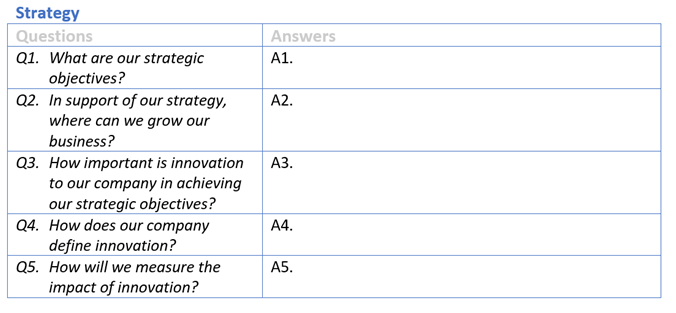
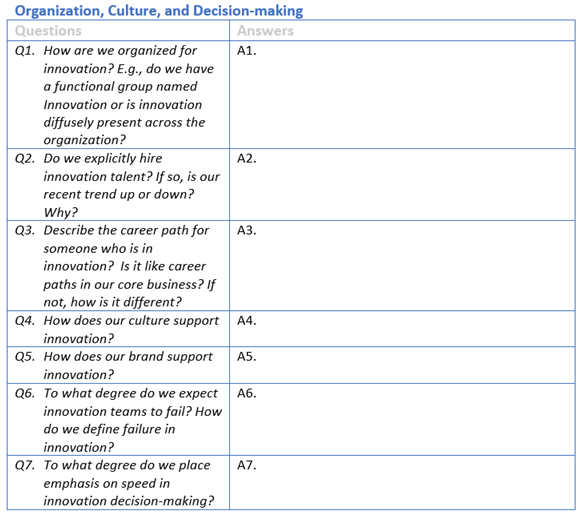
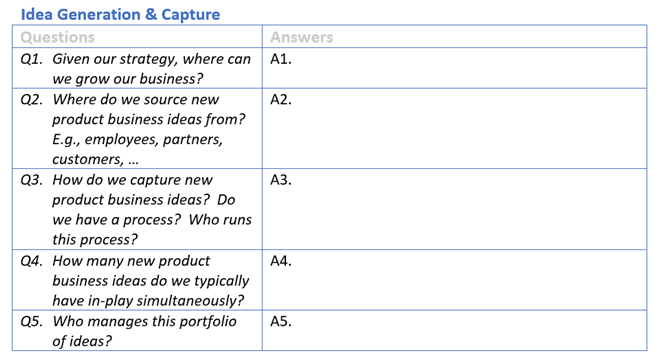
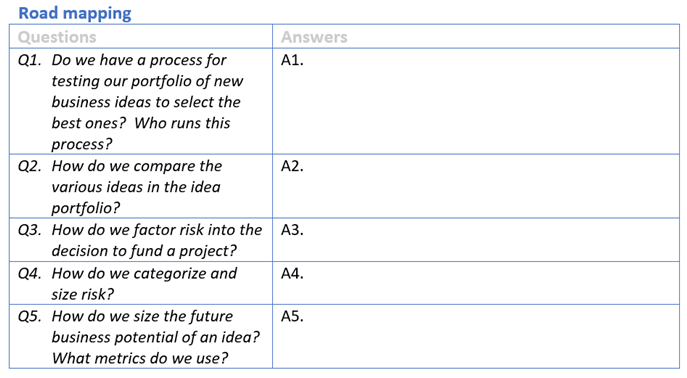
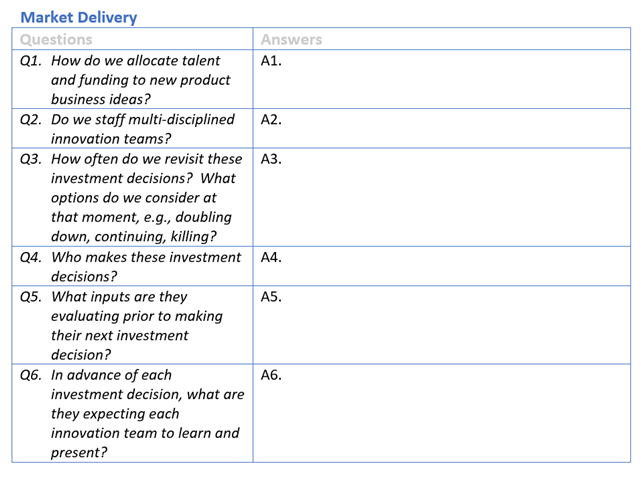
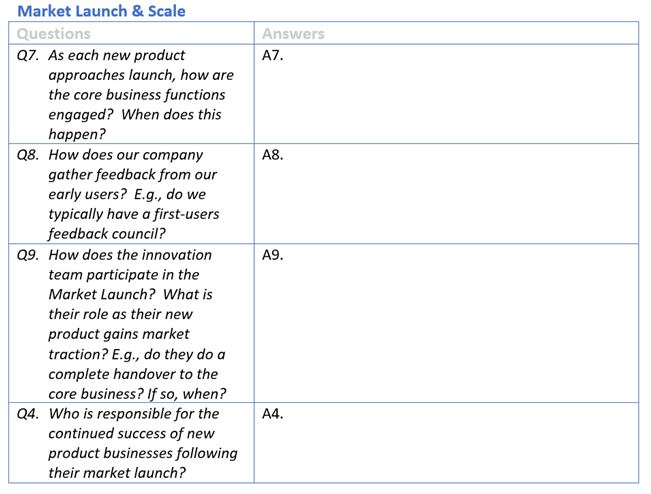
Diagnostic
Once the answers have been captured, the team can perform a first-level diagnosis on the current state of innovation at their company using the following tools. For each answer, place a tick mark that best aligns with the two descriptions. Remember, this is a diagnostic and not a grade. Honest evaluations are critical, as the remainder of the course will give you the tools to improve upon your company’s current state of innovation. To score each section, sum the columns.
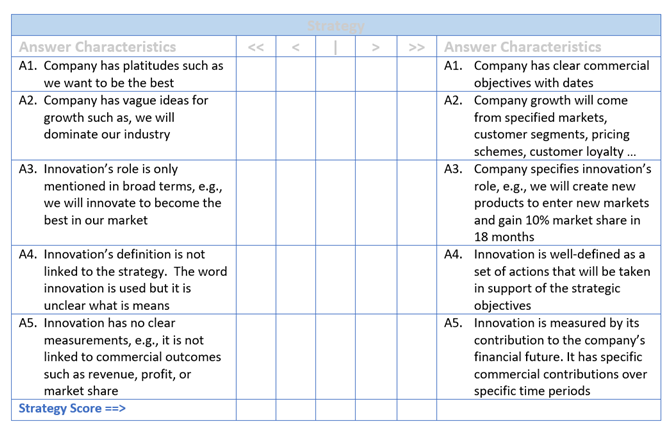
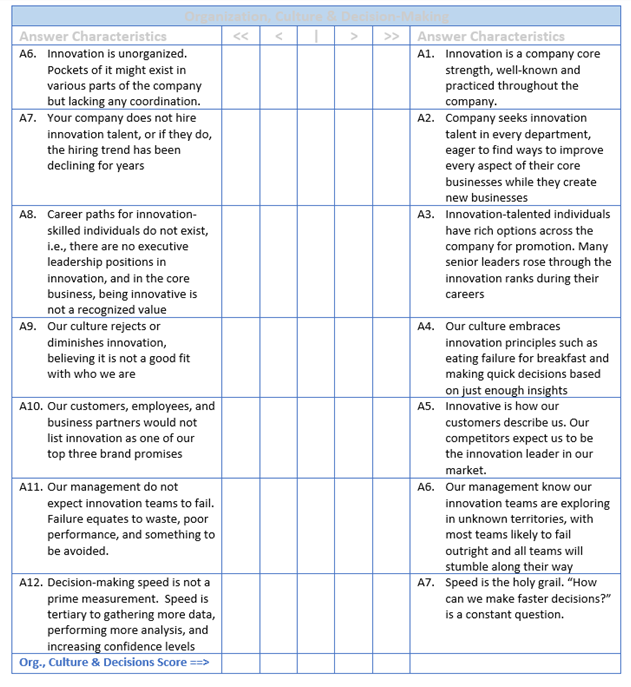
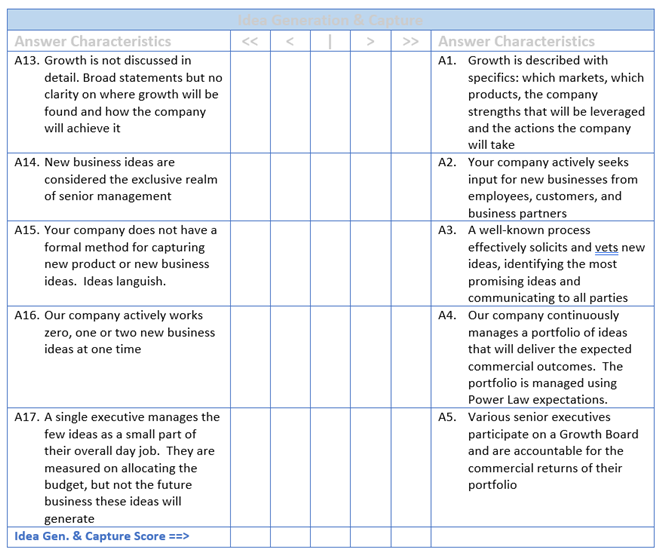
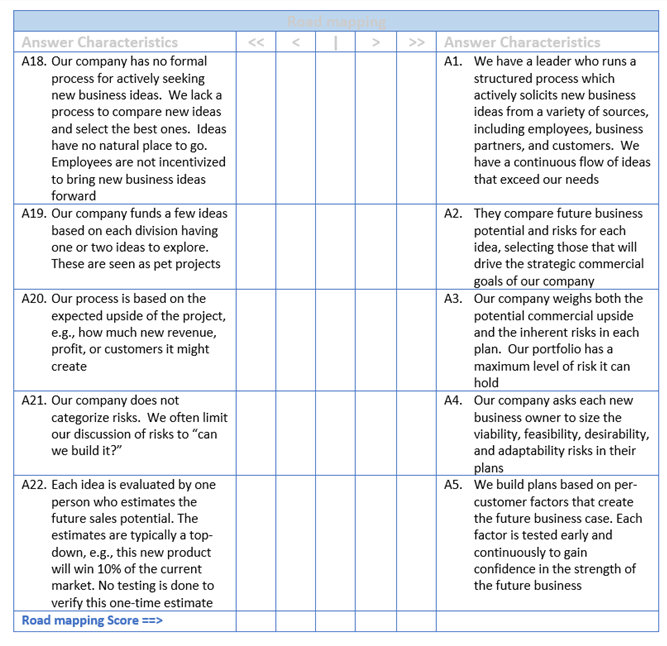
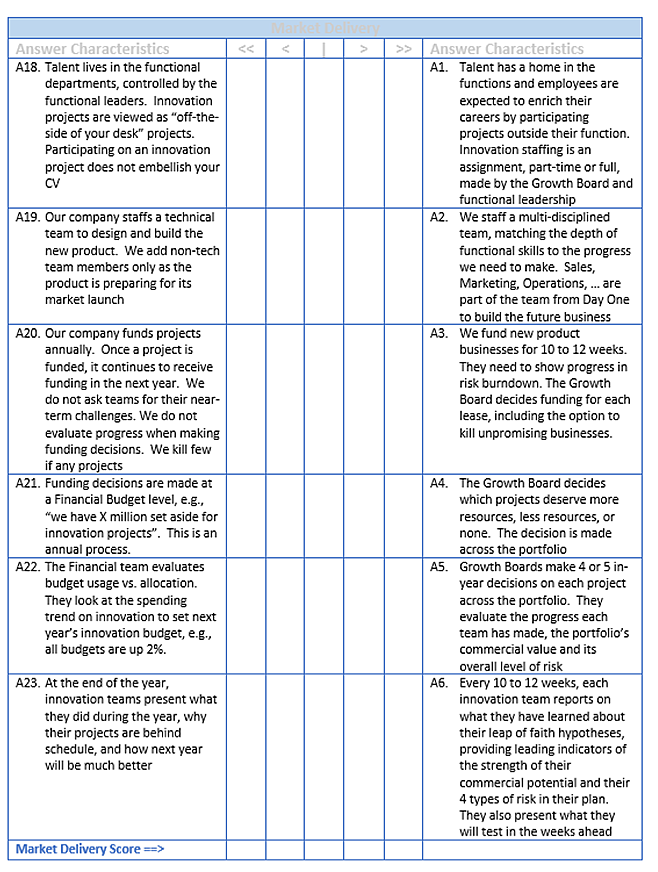
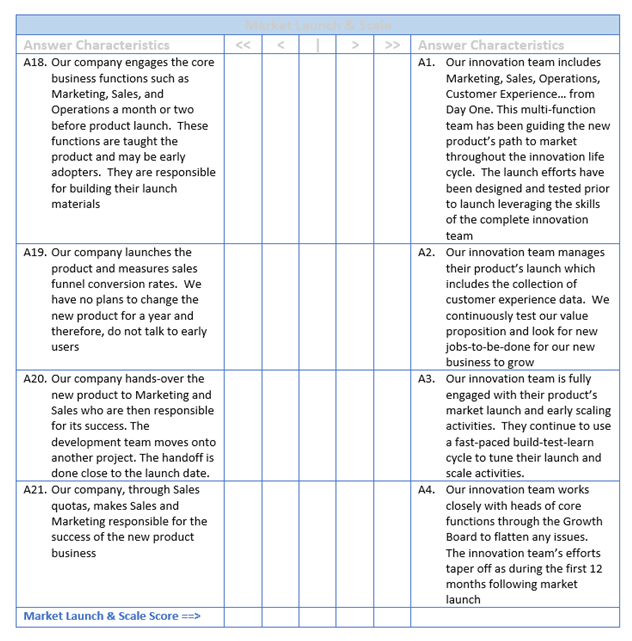

Diagnostic Evaluation
1. Evaluate each of the above six sections by adding the total ticks in both the << and < columns and place that score in the table below. Do the same for the > and >> columns, and lastly, for the | column. Where do most of the tick marks fall in each section? This is your company’s current state for that section. For example, if in the Strategy section, your scores
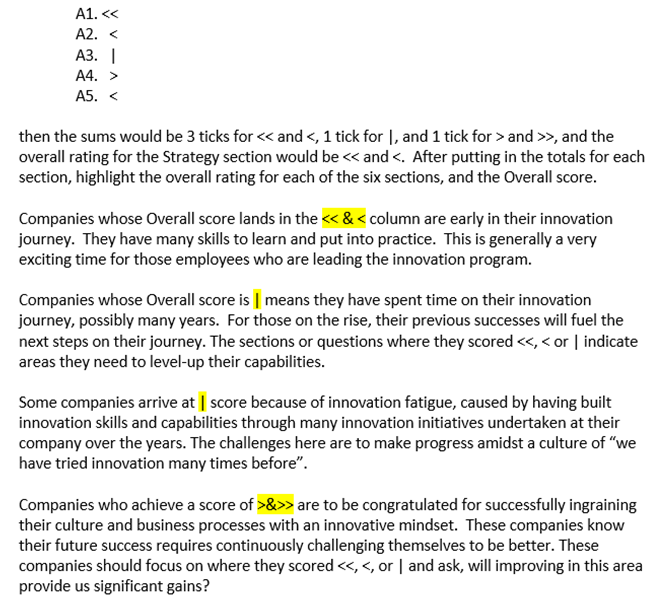

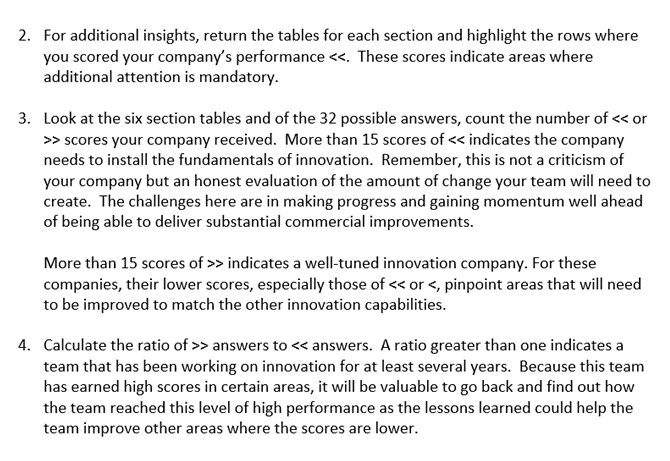
Executive presentation
Following your team’s evaluation of the current state of innovation at your company, you will need to communicate the team’s findings to senior management. While each company has its own approach to executive presentations, it is recommended you incorporate an innovator’s mindset in both preparing and presenting your findings. Here are the recommendations.
Presentation Length
The entire presentation should be completed in 30 to 40 minutes, allowing 20 to 30 minutes for conversation. If needed, you can hold a second meeting to address outstanding questions and gain buy-in to the team’s assessment.
Presentation Storyline
Begin with the team’s challenge, which was to describe the current state of innovation in your company (or a division of the company). This can be summarized on one page. Page two should describe what your team means by innovation. Include Strategy, Culture & Decision Making, and the innovation life cycle. Page three should describe how you collected your data, i.e., the people you interviewed, how many, their job functions, etc. Page four should be your findings which are neatly summarized in the tables above. Being with your overall findings and then on one page each, show the detail for each of the six sections, including the questions and answers.
Describe areas where the company scored >> : Across all six sections, pull together onto one slide (two if needed) the areas where the company is doing quite well. Make sure the executives agree with this assessment and its descriptions.
Describe areas where the company scored << : These questions, where the scores were <<, must be openly discussed. Gain the executives understanding and agreement. Agree to revisit with them outside of this meeting on any scores they do not agree with. For << scores that have executive agreement, let them know these will be addressed in the remainder of the course.
Program Benefits
Organizational
- Faster decisions
- Learning organization
- Risk handling
- Talent magnet
- Cross-functional teams
- Agile adoption
- Reduced hierarchy
- Reduced friction
- Attractive roles
- Attractive careers
Product Management
- Better outcomes
- Talent magnet
- Better morale
- Process acceleration
- Risk management
- Portfolio management
- Idea generation
- Talent utilization
- Time management
- Funds allocation
Strategic Differentiator
- More products
- More customers
- Attractive financials
- Competitive differentiation
- Strategic alignment
- Customer retention
- Market speed
- Customer intimacy
- Better products
- Portfolio power
Client Telephone Conference (CTC)
If you have any questions or if you would like to arrange a Client Telephone Conference (CTC) to discuss this particular Unique Consulting Service Proposition (UCSP) in more detail, please CLICK HERE.


















